Mexico City‘s historic district is one of the most vibrant and exciting parts of the city. While some people might think of Mexico solely as a beach vacation destination, I implore you to skip the resorts and head to the lively heart of the country in Mexico City. The historic district is filled to the brim with museums, art galleries, iconic landmarks and amazing shops. It is the only place in the country where you can visit a pre-Hispanic temple, a church from the 17th century and a food scene unlike any other. From the minute I stepped off the plane, I was in love with this area. I was in awe of the bright colours, bustling atmosphere, and ancient architecture popping up from every hidden corner.
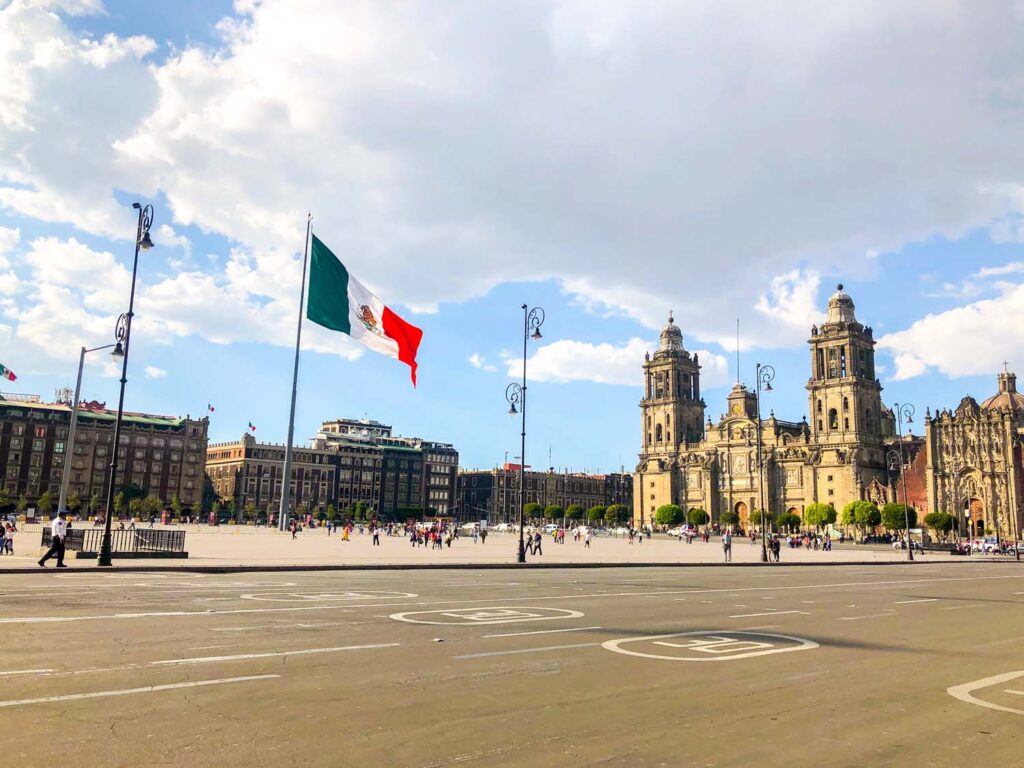
One of the best parts of Mexico City is its sheer size. While some people find this to be a downside, as it might feel overwhelming, I think it’s a huge plus! The various districts and neighbourhoods allow you to feel like you’re visiting a hundred different cities, all in one place. La Condesa is the peaceful botanical garden, Roma Norte is the hipster foodie quarter, Polanco is a luxury shoppers dream, Coyoacan is a bohemian wonderland and last, but not least, the Historic Center (Centro Historico) is the place where it all started! The streets in the Historic Center are brimming with ancient and colonial architecture. It is a place of discovery and authenticity. If you’ve never been to Mexico City before, you need to plan on spending at least one full day exploring this part of town.
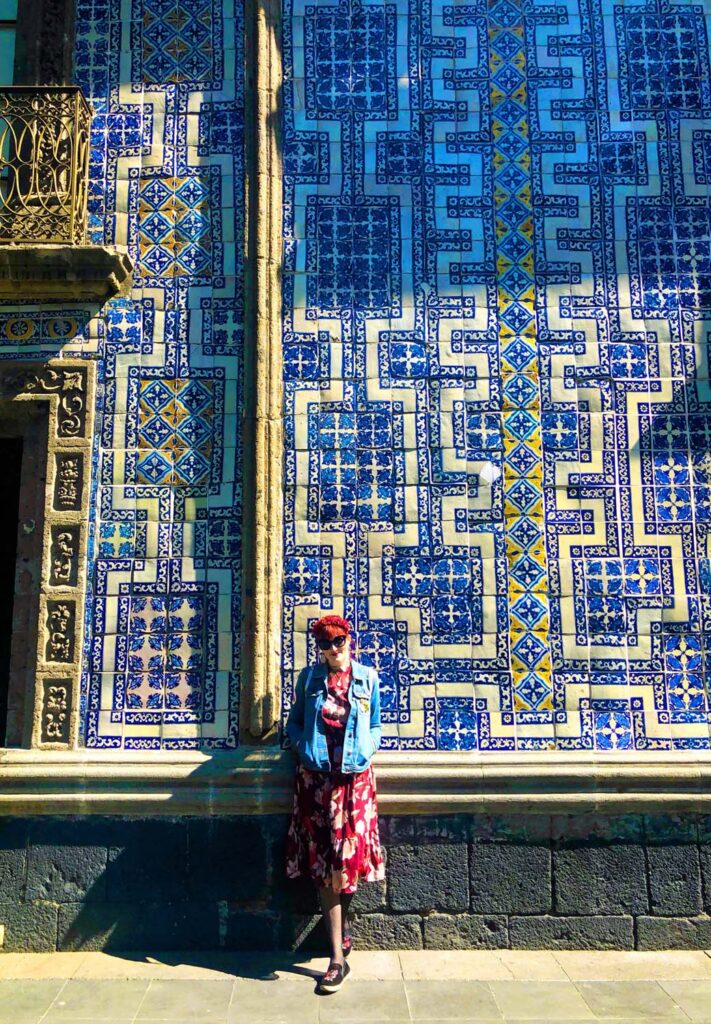
Notes About This Guide
I go into lots of details about the different stops on our tour. Use the handy-dandy table of contents to jump to any particular area of interest if you want to skip or only visit some of the locations on this guided walk.
- History of the Aztec city of Tenochtitlan
- How Long is this Tour?
- Access
- Map of Walking Tour
- Alameda Central
- Palacio de Bellas Artes
- Metro Belles Artes
- Palacio de Correos de México
- Museo Nacional De Arte (MUNAL)
- Cafe De Tacuba
- Plaza de Santo Domingo
- Old Customs Buildings
- Palace of the Inquisition
- Santo Domingo
- Street Names in Mexico City
- Secretariat of Public Education Main Headquarters
- Palacio Nacional
- West Side, Main Wall
- La Casa de las Sirenas
- Templo Mayor Museum
- History of the Temple
- Mexico City Cathedral Metropolitan
- Zócalo
- The Old Government Buildings
- Old Portal de Mercaderes
- Gran Hotel Ciudad de México
- Avenue Francisco I. Madero
- Templo de San Felipe Neri La Profesa
- Dulcería de Celaya
- Palacio de Iturbide
- Church of San Francisco
- Casa de Los Azulejos
- Torre Latinoamericana
- La Opera Bar
- Azul Historico
- Pastelería Ideal
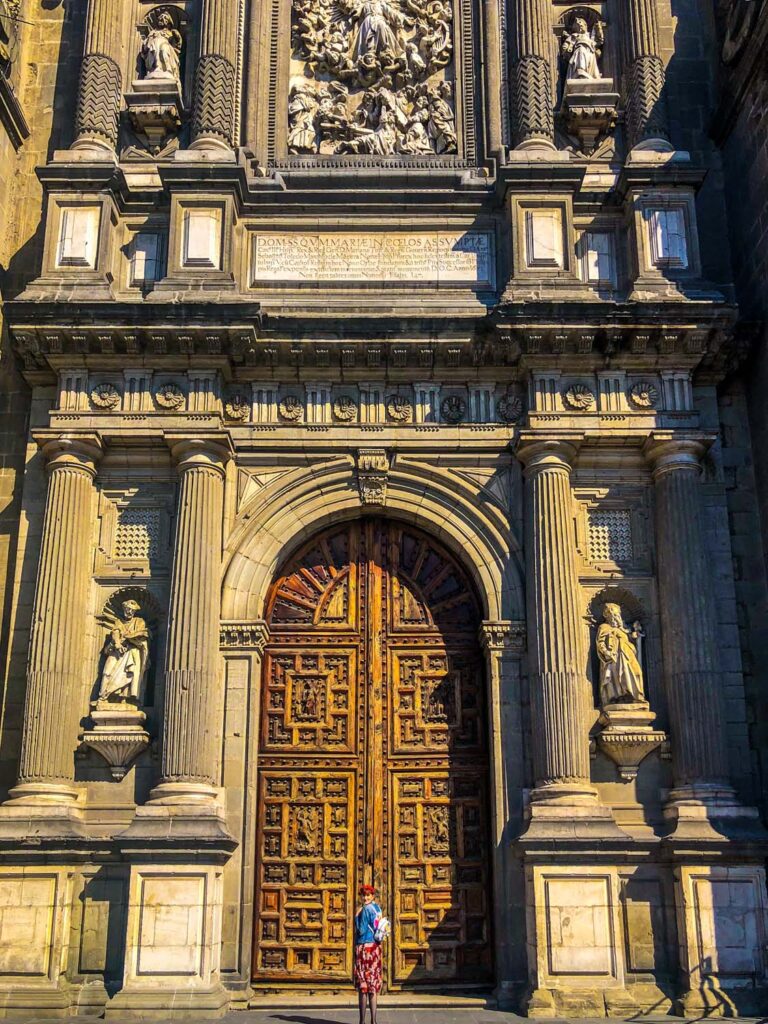
History of the Aztec city of Tenochtitlan
For centuries, the Historic Centre has been the beating heart of Mexico City. It was here, in this area, where the ancient Aztec city of Tenochtitlan once stood. The Aztecs of Tenochtitlan were incredible builders and city planners. They laid out the town in orderly streets, separated into four quarters. In between the streets were great canals that helped water and fertilizer their rich fields and crops. The roads and canal all meet at the grand Templo Mayor in the centre of the city. Inside the temple was the Palace of the Tlatoani (the Aztec emperor). Inside the temple, there was a large school called the Telpuchcalli which was used for secular studies, and a Calmecac that was used for priestly training.
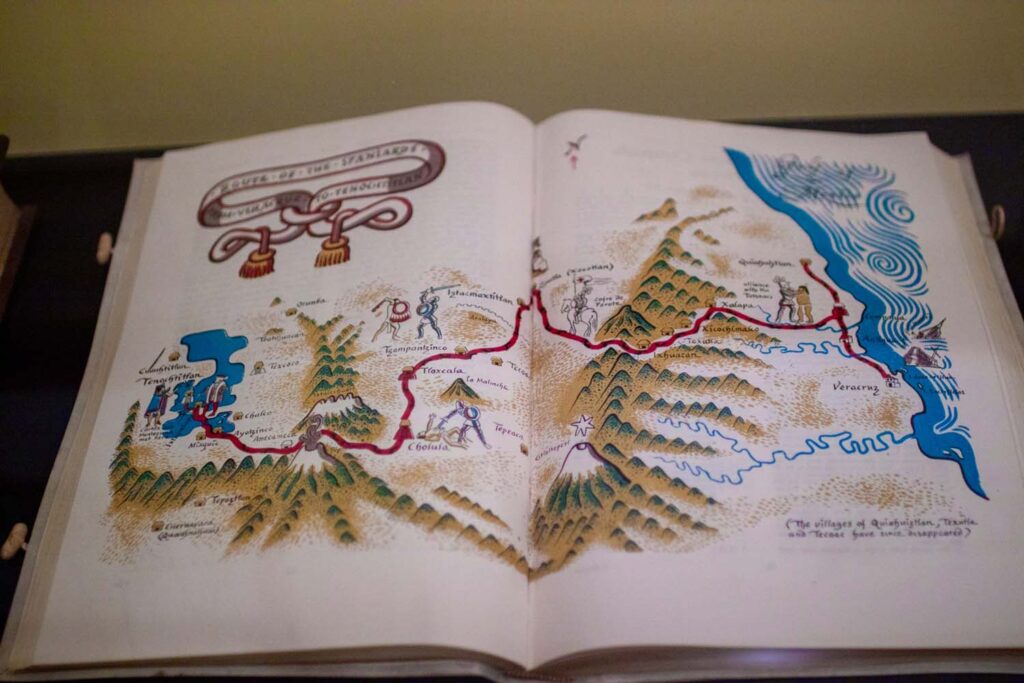
Sadly, the beautiful ancient city of Tenochtitlan was destroyed with the arrival of the Spanish in 1519. They defeated the Aztecs and stole their land. The Spaniards tore down many of their temples and buildings and renamed the streets with Christain prefixes. In addition to the destruction of the city was the removal of their ingenious canal system. Little did the Spanish know, the removal of this modern method of bringing fresh water into the city would result in severe water shortages in the big city. A problem they are still struggling with to this very day! When the Spanish destroyed the Aztec city, they re-used many of the original stones to construct their colonial structures. So pay close attention as you walk; you never know where hidden ancient stones are ready to be found!
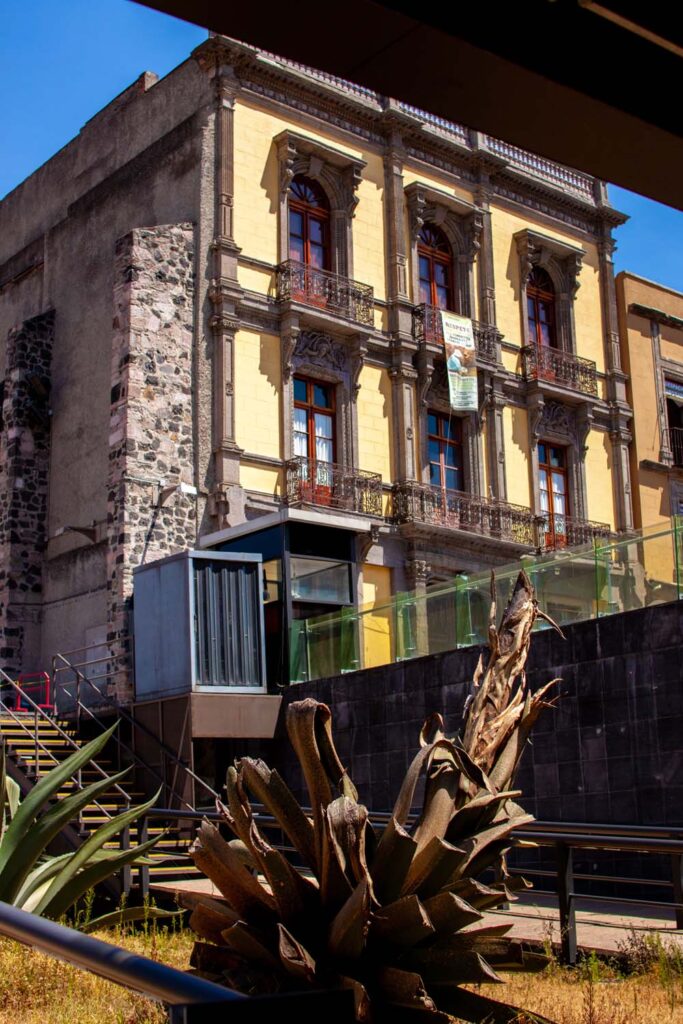
Modern History
Today the Historical Centre is spread across nine square km, occupies 668 blocks and contains over 9000 buildings! 1,550 of which have been declared of historical importance. Many of these historic buildings were constructed between the 16th and 20th centuries by the wealthy Spaniards. After a devastating earthquake in 1985, the historic district fell into disrepair. It suffered from overcrowding and pollution and was not an area that many people lauded as worth visiting.
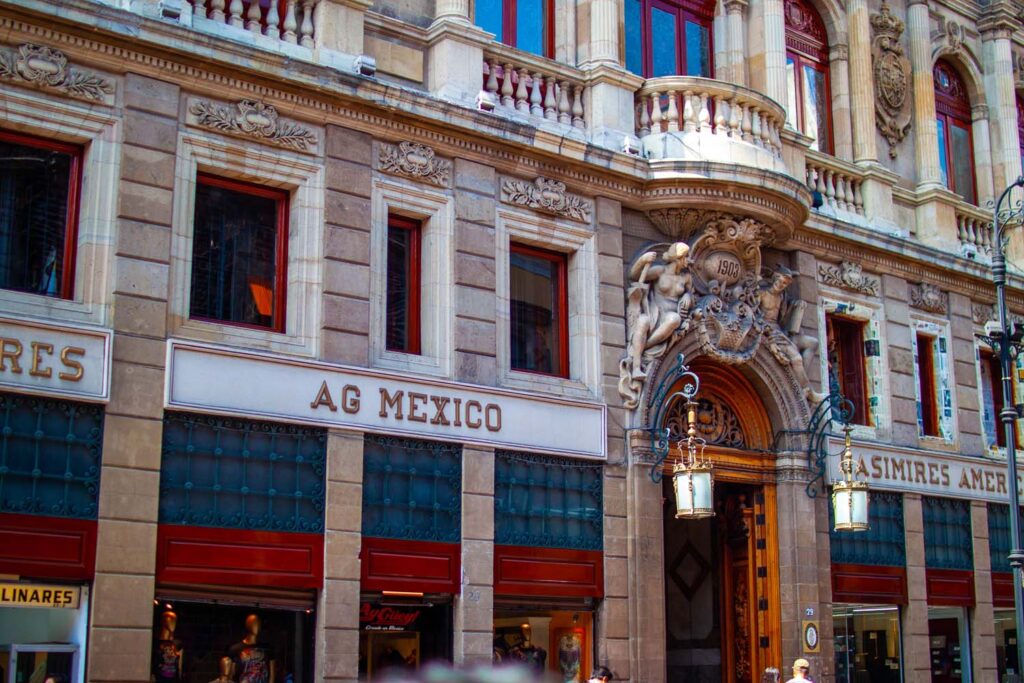
In the 1980s Mexico City’s downtown district, with its modern towering steel architecture, was the big draw. No one had time back then for history, they sought after the future. But with the nostalgia creep of the 2000s, the Fundación Centro Histórico was founded to restore this area to its former glory. The foundation wanted to bring tourists back to the area to appreciate the beauty of these buildings and restore what Aztec history they could. A massive restoration went underway to fix the damage done by the earthquake, and more police presence was brought in to ensure safety for all visitors. Today, the area is back to its position as the central spot for visitors to this great city. Just as it was in the earliest days of its inception.
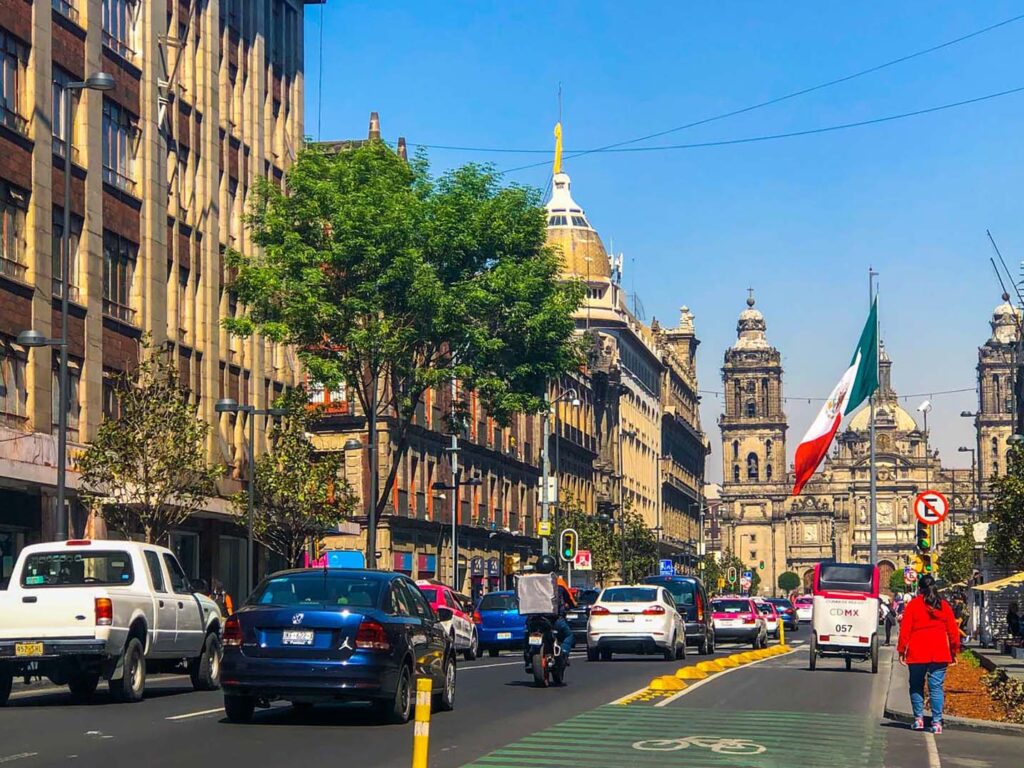
Notes on Safety
I’ve heard it all before, “But isn’t Mexico City so dangerous?! Aren’t there drug cartels everywhere?!” Honestly, I never felt unsafe when I was there, and I’ve visited multiple times. Mexico City is aware of its reputation. And despite the fact perhaps this reputation is more due to the bad press than actual tourist crime, the government has made great strides in increasing police presence. Especially in tourist areas to ensure that people feel as safe as possible.
In the end, it’s a big city, like any other big city around the world. Standard travel security practices are always encouraged. I would recommend the exact same thing whether you’re visiting Mexico City or Barcelona. And honestly, in Barcelona, I witnessed multiple pickpocketing attempts and one person I knew who had their wallet and passport stolen. In contrast, in Mexico City – I never had anything happen. Does that mean it won’t? Of course not, but I don’t think it deserve this reputation it has.
Be a Smart Traveller
- Don’t wear flashy jewellery or carry expensive handbags
- Keep your money in discreet, zipper pockets and don’t carry too much at one time
- Leave your passport in a safe at the hotel
- Stick to busy streets, well-lit streets
- Ensure your phone plan covers mobile data usage in Mexico. This is a lifesaver when it comes to calling a taxi or just using directions on google maps
- Avoid wandering around at night, instead, take a Uber from location to location
- Avoiding talking to strangers who approach you on the street. Often these are scammers either trying to distract you while they swipe your wallet or just sell you on something sketchy. Kindly just wave them off and continue walking on your way
- Someone strange won’t leave you alone? Walk inside a busy shop
- If you EVER feel unsafe, just call an Uber and you can get picked up and brought to somewhere familiar
- Skip the street taxis and use Uber or other car services instead to ensure a safe ride and reasonable price
- Avoid high-crime areas like Iztapalapa, Tepito, La Lagunia, La Merced, Doctores and Ciudad Neza
- I always carry a photocopy of my I.D. on me in case of emergencies
- Learn a bit of Spanish, goes a long way in many different scenarios
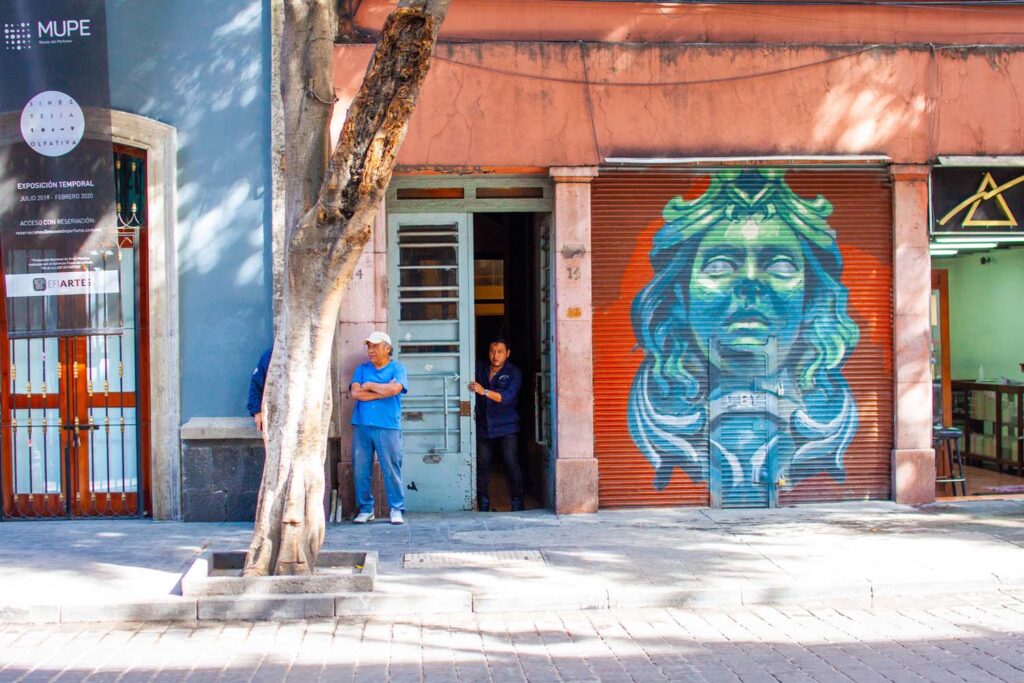
How Long is this Tour?
I would recommend spending an entire day here in the Historic Center. There is SO much to see and do. You could quickly return later to further explore the different art galleries and museums found here as well. And trust me, you’ll probably want to return for the food as well. So don’t worry if something is closed or if you don’t have the time to finish the entire tour. Missing out is just a good excuse to come back!
Access
The Historic District is bordered by the Zócalo to the east, the Paseo de la Reforma to the west, Insurgentes and Av. Juárez to the north and San Angel to the south. The best way to get around Mexico City (in my opinion) is by using Uber. Not only is Uber extremely safe, but you also don’t need to worry about getting ripped off. Fare are displayed upfront before confirming your ride. There is no fussing for cash either as you pay via a credit card stored on the app.
Rush hour traffic is REAL in Mexico City. Honestly, traffic is pretty dense throughout the entire day but it’s definitely worse before and after work hours. I would advise arriving at our starting location before 9 am to ensure you don’t have to deal with too much of the rush hour traffic.
There is also a metro station located right near our first stop. If you prefer to take public transit, that is definitely an option as well. The Metro in Mexico City is SUPER cheap and surprisingly easy to navigate. However, it is also hectic and crowded. The safety of the Metro system gets a mixed reputation. For the most part, I generally recommend Uber to ensure you have the most stress-free experience possible but if you decide to ride the metro just use all the safety tips listed above.
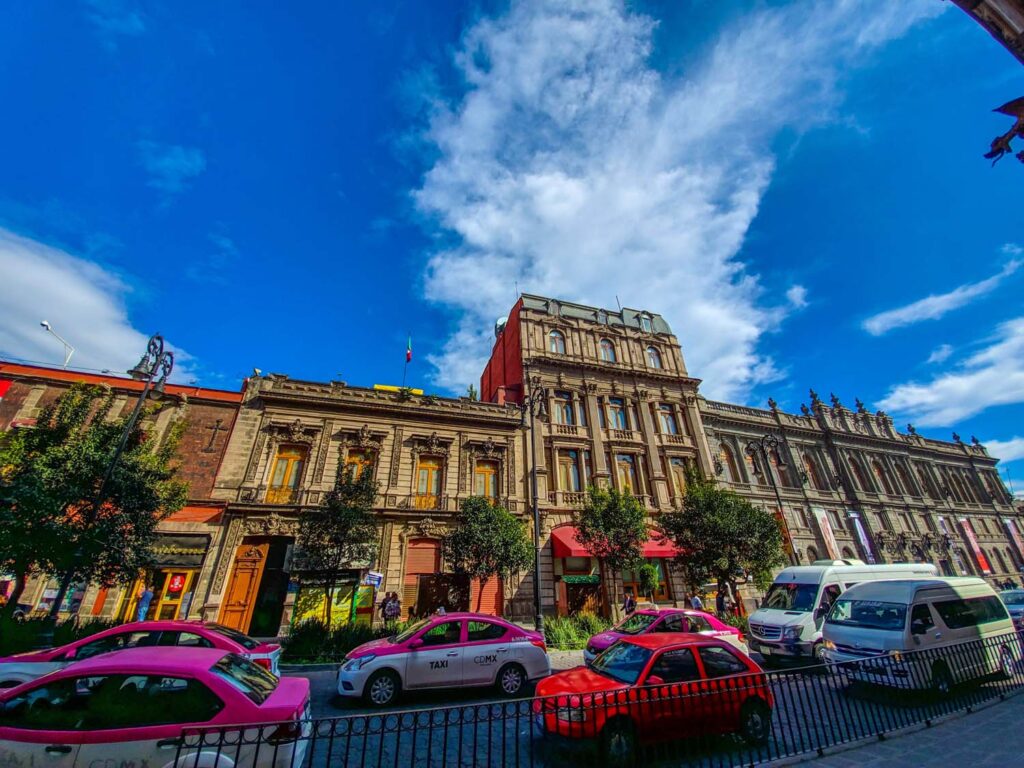
Map of Walking Tour
Alameda Central
Start your tour as early as you can manage inside the green acres of Alameda Central. This incredible urban oasis is the largest and oldest public park in the Americas. Despite being flanked by busy streets on all sides, when you are wandering inside the gorgeous green canopy of the park’s forest, you feel completely at peace.
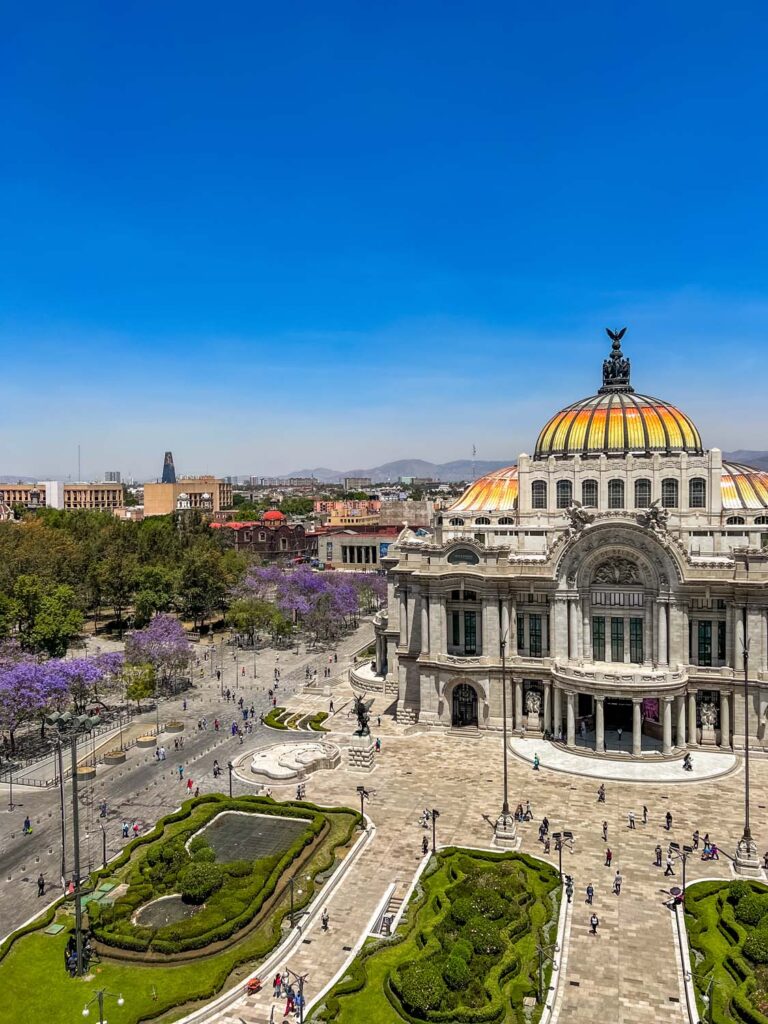
History of Alameda Park
The site where the park now stands was once the location of the ancient Aztec marketplace. Today, you’ll still find different vendors bringing out their food carts serving tourists and locals alike. I feel like that same marketplace energy still exists here, just in a slightly different form.
The name for the park comes from the Spanish word “álamo,” which means “poplar tree.” Hundreds of these álamo trees were planted in the garden in 1592. Viceroy Luis de Velasco II ordered the creations of a new public green space for the city’s residents during the start of his regime. He saw the popularity of public green spaces in Europe and wanted the same criteria for his new city.
While the eastern portion of the park was for leisurely promenades, the west end of the park held a more nefarious purpose. This western section was originally built during the Mexican Inquisition. It was known as the “Burning Place.” It was here that convicted witches and people accused of treason were publicly burned at the stake. While you don’t immediately think of Mexico as a place of witch trials, these inquisitions spread worldwide. When the inquisitions ended in 1770, the burning plaza was destroyed and transformed into an extension of the park.
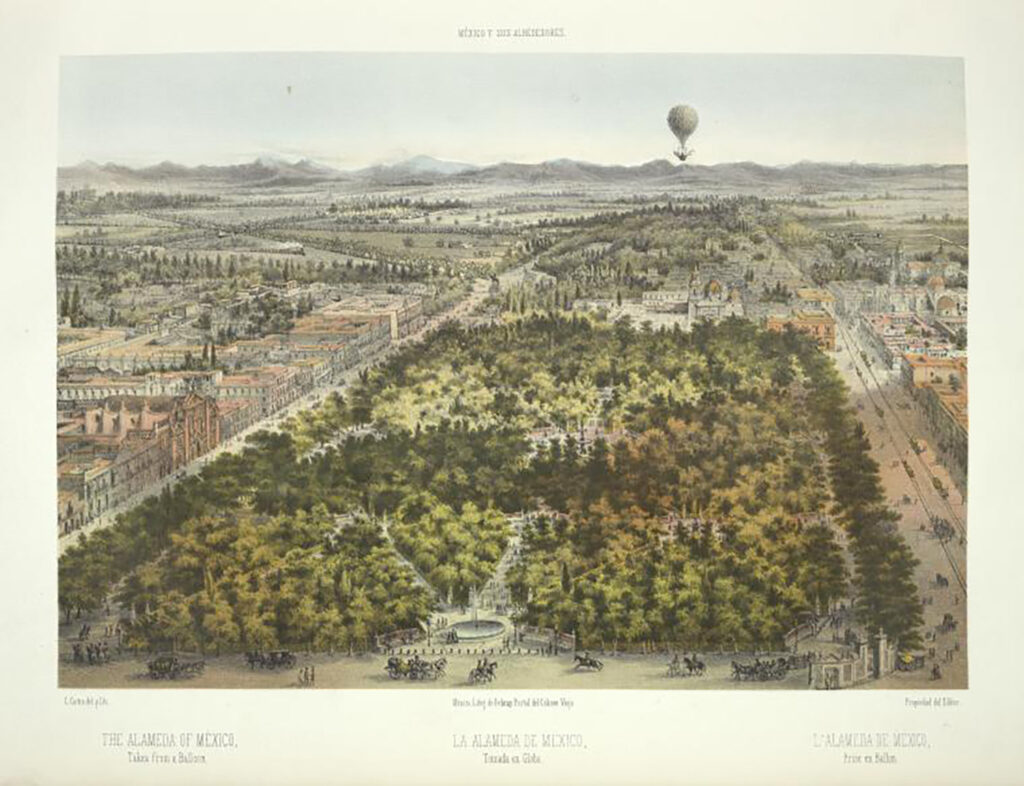
Park Monuments
Like many of the amazing parks in Mexico City, they are more than just trees. The precisely paved pathways lead you around decorative fountains, beautiful statues and incredible monuments. It feels like wandering around an outdoor art gallery. Each of the five fantastical fountains found throughout the park was made in France and were inspired by Greco-Roman mythology.
One of the most important monuments is the “Hemiciclo de Benito Juárez.” This large semi-circle of eight towering marble columns with a central plinth is topped with a group of neoclassical statues. In the center is statesman Benito Juárez himself. Juárez was the 26th president of Mexico and, most importantly, the first president of Mexico who was of indigenous origin. On either side of him are two allegorical female statues representing the fatherland and law. On the pedestal he sits, you can see the inscription “Al benemerito Benito Juárez la Patria.” This translate into “To the meritorious Benito Juárez, the Homeland.”
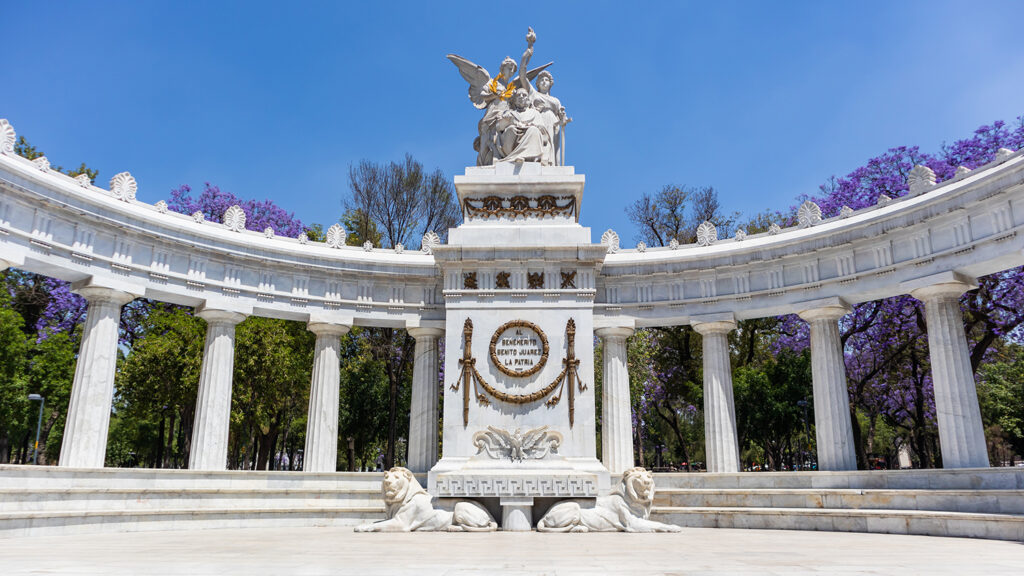



Over the years, the park has been of such important significance to the people of the city. Most importantly, the park was immortalized by Mexican artist Diego Rivera in his famous work Sundays on the Alameda Central. The mural depicts famous people and events in the history of Mexico, all together in one giant vibrant mural. You can still see this mural in the Museo Mural Diego Rivera located in the west end of the park. We won’t be stopping in there today, but later in the tour, we will see hundreds of paintings by Rivera located in-situ where they were first painted.
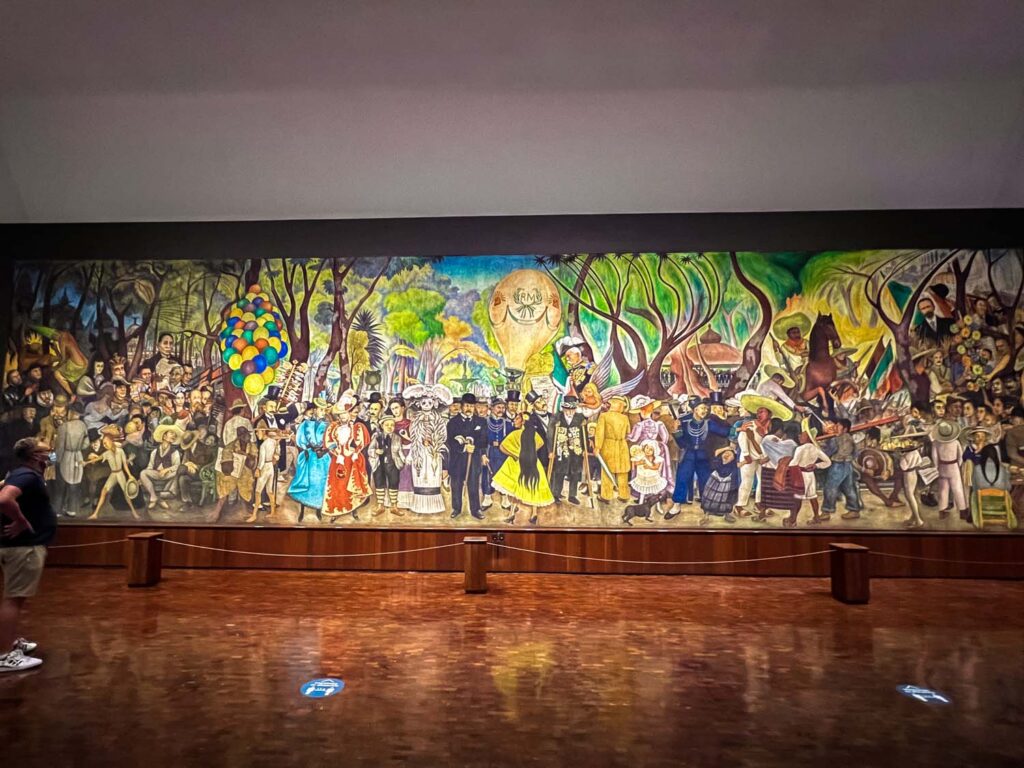
Palacio de Bellas Artes
Right next door to Alameda Park is the fantastical Palacio de Bellas Artes. The Palacio is doubtlessly one of the most impressive buildings in the historic district. Inside, you can listen to international symphonies, watch emotional ballets, become entranced by the theatre, awe at opera and even hear literature performances. Being a hub for all these performance arts gives the building its nickname, “the Cathedral of Art in Mexico.”
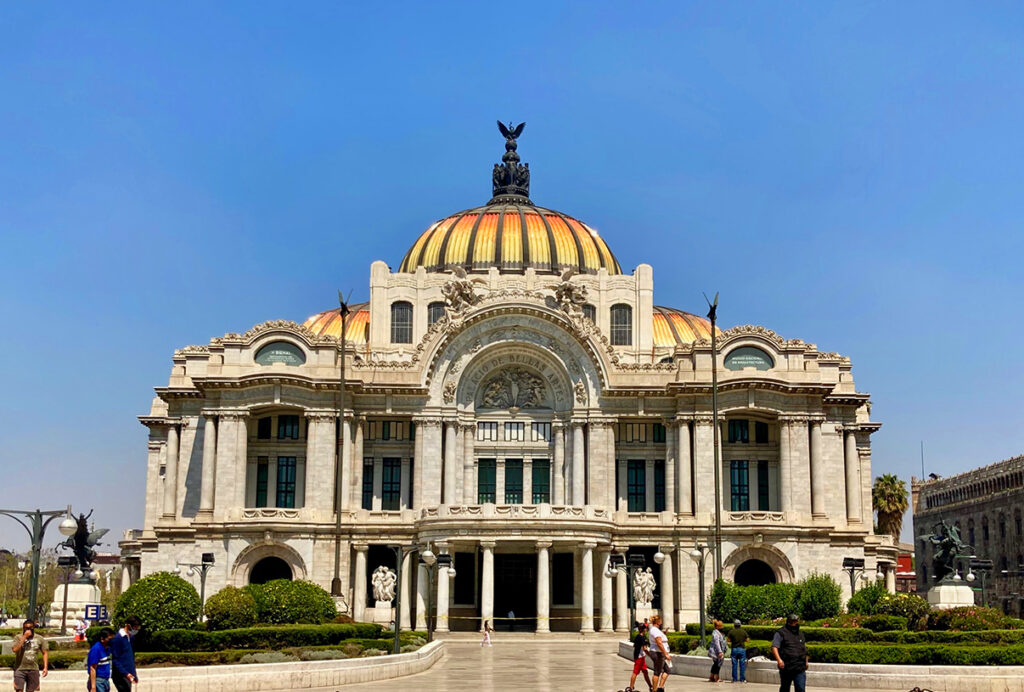
Architecture
The Palacio de Bellas Artes’ original design was conceived by Italian architect Adamo Boari. Boari wanted to create an entirely metallic structure, like the modern skyscrapers popping up in America. He loved the neoclassical and art nouveau styles as well and wanted the facade to follow those principles.
Although Boari started work on it in 1904, the building wouldn’t be completed until 1934. Problems with the soil and political unrest all contributed to halting any real progress. The situation was so volatile that Boari ditched the project and fled back to Italy. Mexican-born architect Federico Mariscal took over construction. Mariscal altered much of the design. The most substantial was the abandonment of the steel exterior. Instead, Mariscal used more traditional materials such as stone and carrier marble. But stone and marble are heavy and contribute to the fact that the poor Palacio is sinking into the soft ground a little more every year.
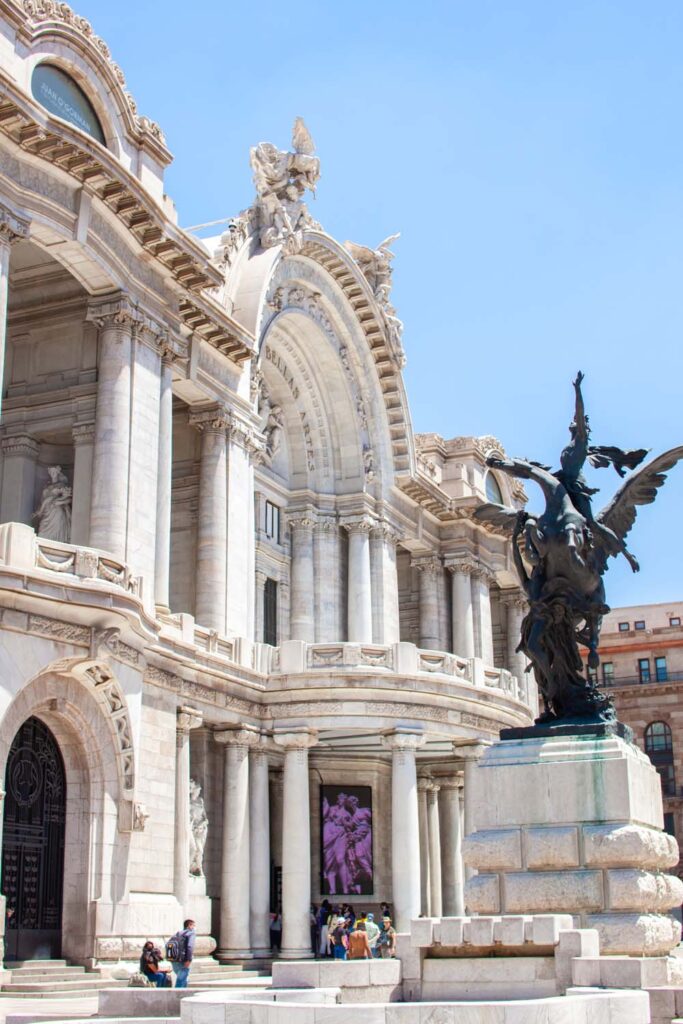

The Facade
The design of the facade is heavily influenced by classical European styles. The images and references don’t have any connection to the Mexican people or their culture. Despite the fact that the new architect was Mexican, he couldn’t change much of the exterior’s plan as the materials had already been purchased. But when we step inside, we can see Mariscal’s real vision for his Palacio.
Walking up to the Palacio, you can see four statues of the pegasuses being ridden by the four muses with Apollo in tow. Initially, these statues used to sit on top of the building. Their weight contributed to the sinking of the building, so they were removed and placed on the ground in the gardens surrounding the Palacio.
Inside the portals on the ground floor are a series of Italian sculptures. Each one depicting various allegorical figures relating to emotions that theatre and art aims to invoke in the viewer. Harmony, pain, rage, happiness, peace and love are all featured here in their mortal form.
One of the most impressive features of the building is the rainbow-hued rooftop cupola. This brightly coloured feature feels so appropriately Mexican, as they embrace colour whenever they can. It stands in such contrast to the white marble exterior designed by the Italian.
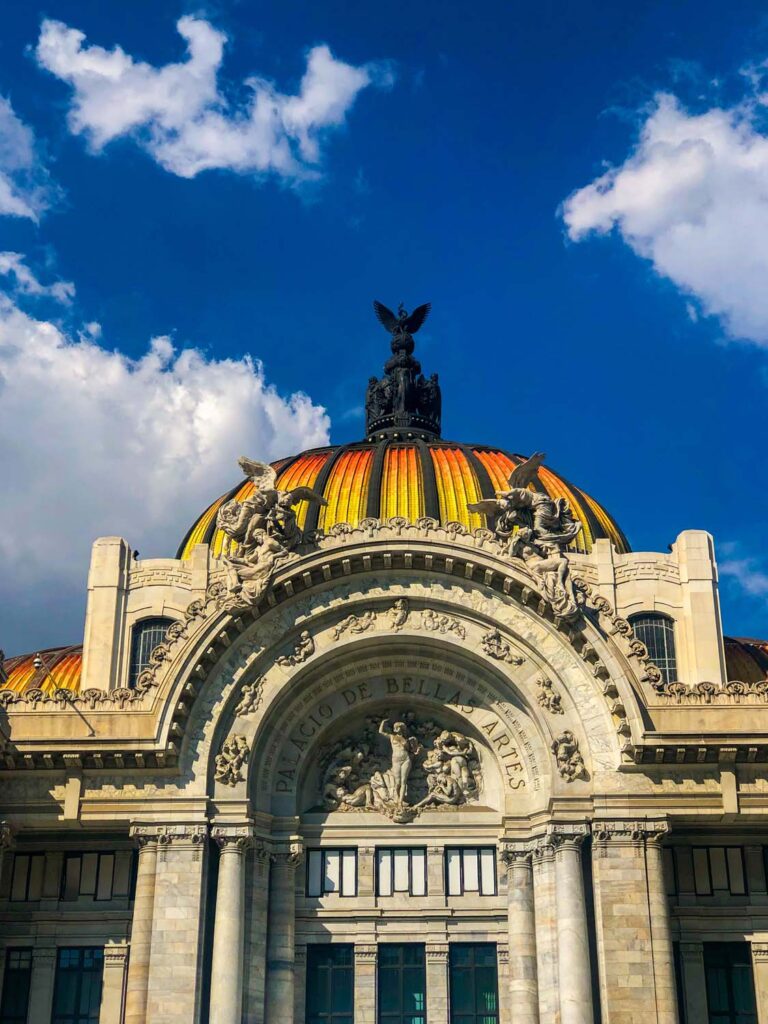
Interior Design
When you walk inside (which you can do for free if you just want a peek into the lobby) you can see the powerful Art Deco style that Mariscal dreamt up. Crawling up the sides of the building are sprawling murals surrounded by prehispanic motifs. You can see serpent’s heads curling around the window arches. Mayan deities and their masks, face out on the vertical columns. Even the marble inside is starkly different from the exterior. This marble is a darker and has a red hue giving the interior a more colourful appearance.
Interior Murals
On the second floor (if you take a guided tour) you can see the incredible murals painted by José Clemente Orozco, David Alfaro Siqueiros, Diego Rivera, Jorge González Camarena, Roberto Montenegro and Manuel Rodríguez Lozano. Outside the entrance to the amphitheatre are more bronze carvings of the Aztec and Mayan gods Tlaloc and Chaac (the gods of thunder and rain.)
Inside the auditorium, you can study the 200-foot Tiffany glass curtain designed by Mexican artist Gerardo Murillo aka “Dr. Atl.” The glass design represents the volcanos Popocatépetl and Iztaccíhuatl. Surrounding them are images of the Mexican landscape. But to me, it is the heavenly sky above the landscape that is the most powerful aspect of the piece. The opalescent blues shimmer like the rainbow as the light catches it.
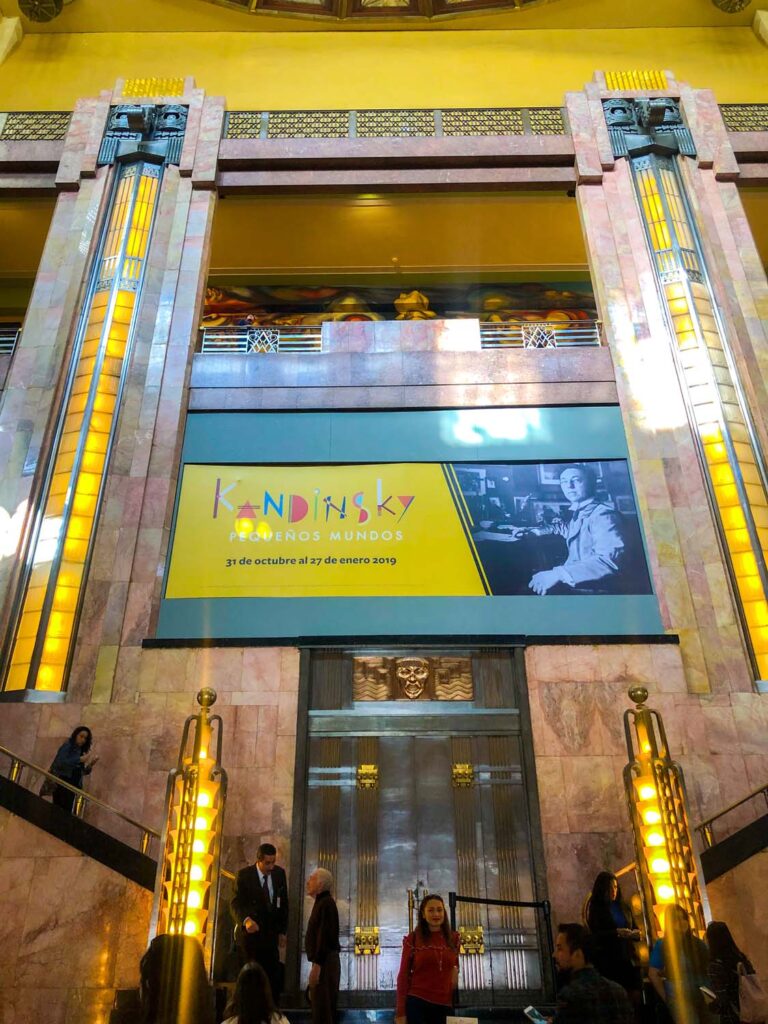


Interior Tour
Everywhere you look in the interior, there are artful representations of the Mexican people, their values and cultural references. It is 100% mandatory to poke your head inside to really soak in the views for yourself. If you just want to peek inside, the cost is free, but you’ll only be able to explore the lobby. The price of admission to the entire building is $60mxn per person + $30mxn camera fee if you want to take pictures. Usually, the line-up to get inside is very long, so if you have your heart exploring the interior, the earlier you get here, the better.
Metro Belles Artes
Walk north along the Belles Artes building, parallel to the busy Eje Central Lázaro Cárdenas. Walk until you reach the Belles Artes Metro station. Although we aren’t travelling on the Metro, this iconic Parisian station entrance is a must-see. The entrance arch was actually a gift from Paris’ Metro designed by French architect Hector Guimard. The French President Jacques Chirac gave it to Mexico City in 1998 in exchange for a Wixárika fresco, El pensamiento y el alma huicholes by artist Santos de la Torre. Today you can see this mural on display in the Palais Royal-Musée du Louvre Metro station in Paris.
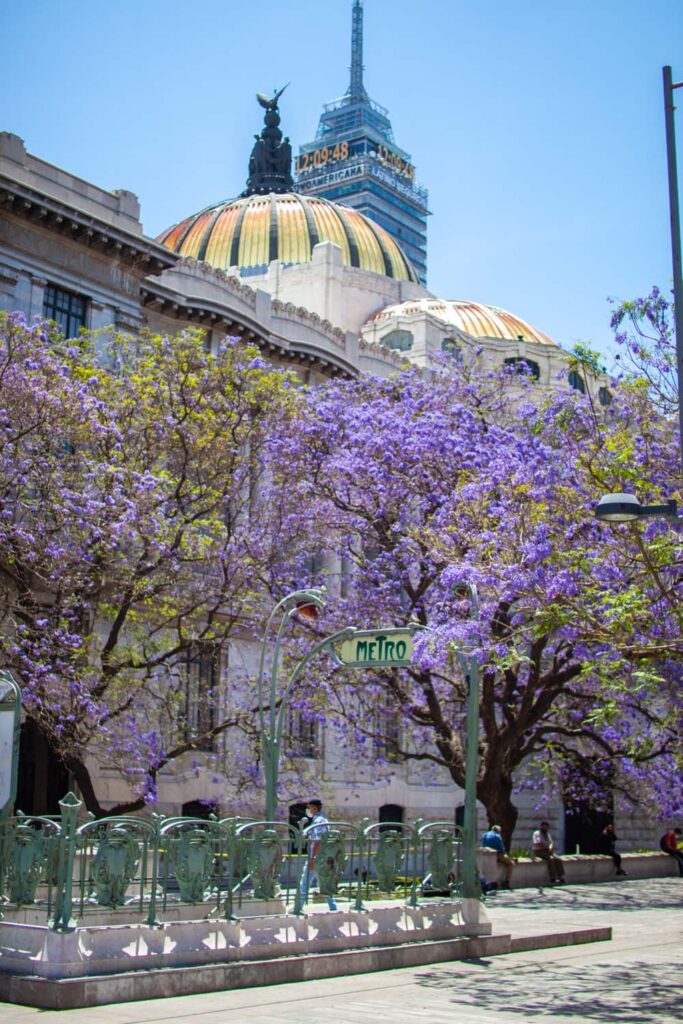
Palacio de Correos de México
Walk back down to the Calle de Tacuba to admire the exterior of the Palacio de Correos de México (Postal Palace of Mexico City.) While it might seem strange to visit a post office, this one is truly spectacular. The Postal Palace of Mexico City was designed when the post office became a separate government entity. They wanted to show off their power and created a building with a very eclectic style to make it really stand out! It blended Art Nouveau, Spanish Renaissance Revival, Spanish Rococo style, Elizabethan Gothic, Elizabethan Plateresque and Venetian Gothic Revival all together. The architect of this Frankenstein creation was none other than Adamo Boari, who designed the Palacio Belles Artes. While you’d think trying to blend that all those styles together would result in a mess, it is anything but!
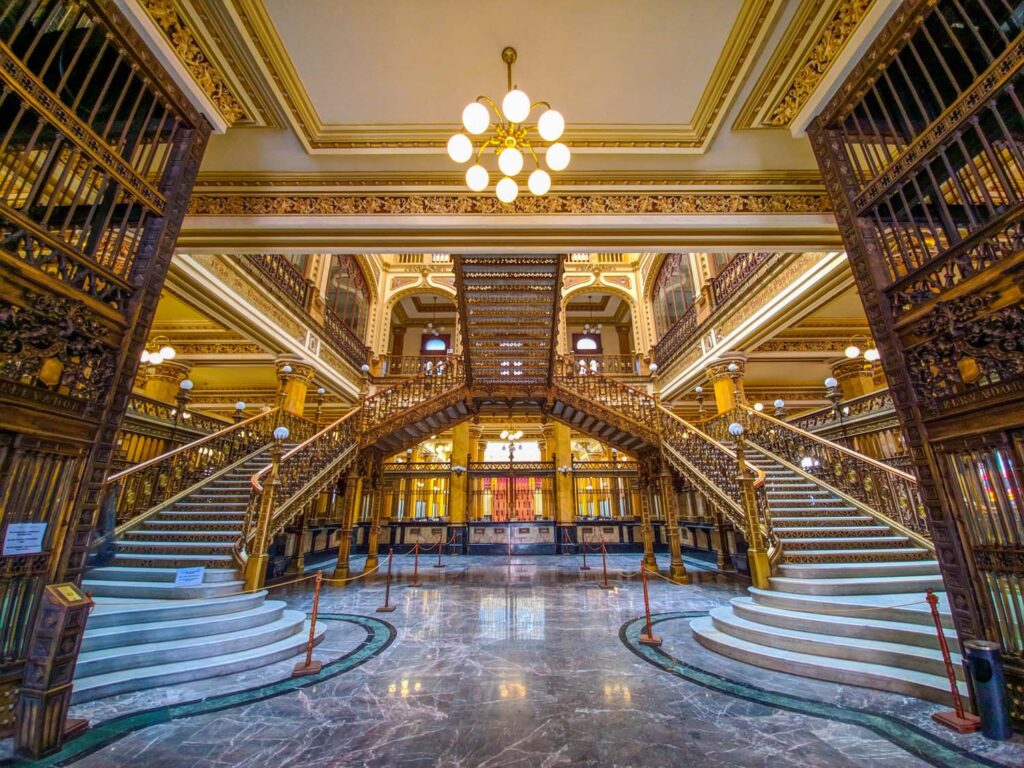
Construction started in 1902, and the building was finished in 1907. Although five years might seem like a while these days, for such a massive undertaking in the early 1900s it seems almost too quick! The frame of the building was designed on a grid of steel beams. This modern inner structure is why the Post Office managed to withstand many of the earthquakes that destroyed other buildings in the area. Military engineer Gonzalo Garita y Frontera supervised the construction of the steel frame. It is perhaps for this reason that the structure is so sound.
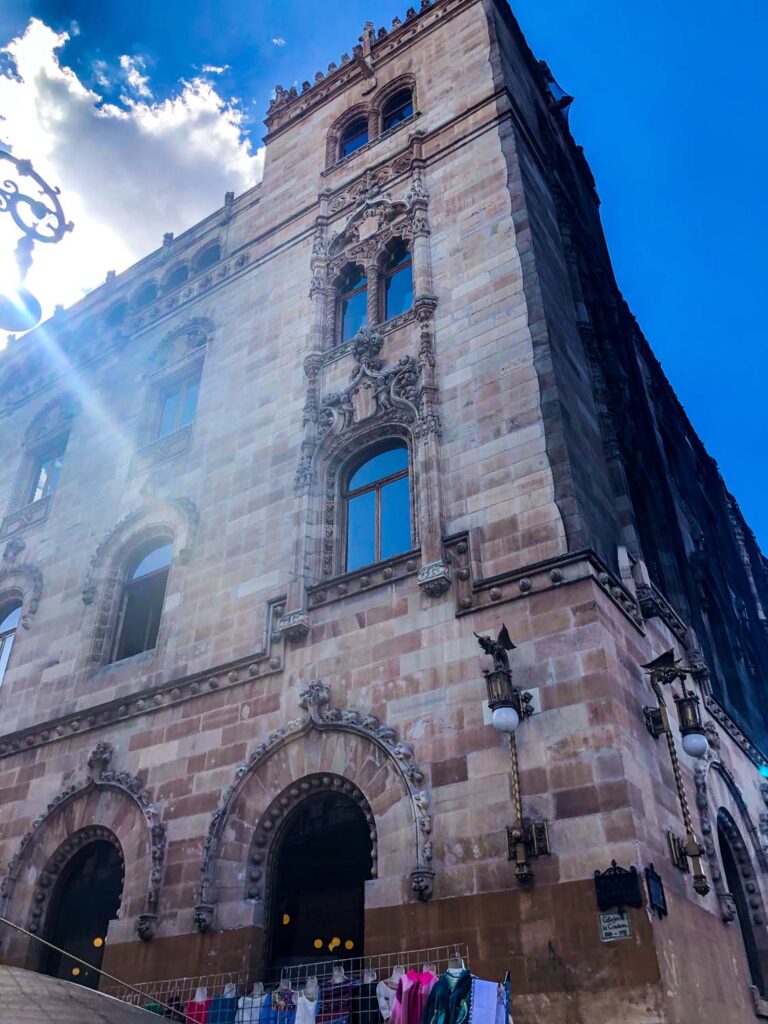

Exterior
One of the most iconic parts of the building is the colour of the stone. The stone is called “chiluca,” which has a slightly translucent effect and is exceptionally light in colour. This allows the heavy ornamentation to be juxtaposed by the airy feeling of the stone. The chiluca stone was quarried from the local Tulpetlac mines. This gives the building a bit of local flare despite the overall European-inspired architectural elements.
Decorating the facade is a mixture of Elizabethan Gothic styles. This period in architecture was dominated by twisting columns, heraldic elements, flowery crests, stone cherubs holding scrolls, gargoyles, hundreds of arches and hundreds (if not thousands) of ornamental balls. Highly polished brass and iron dragons, hanging off the side of the building, shine in the sunlight as you walk along the exterior.
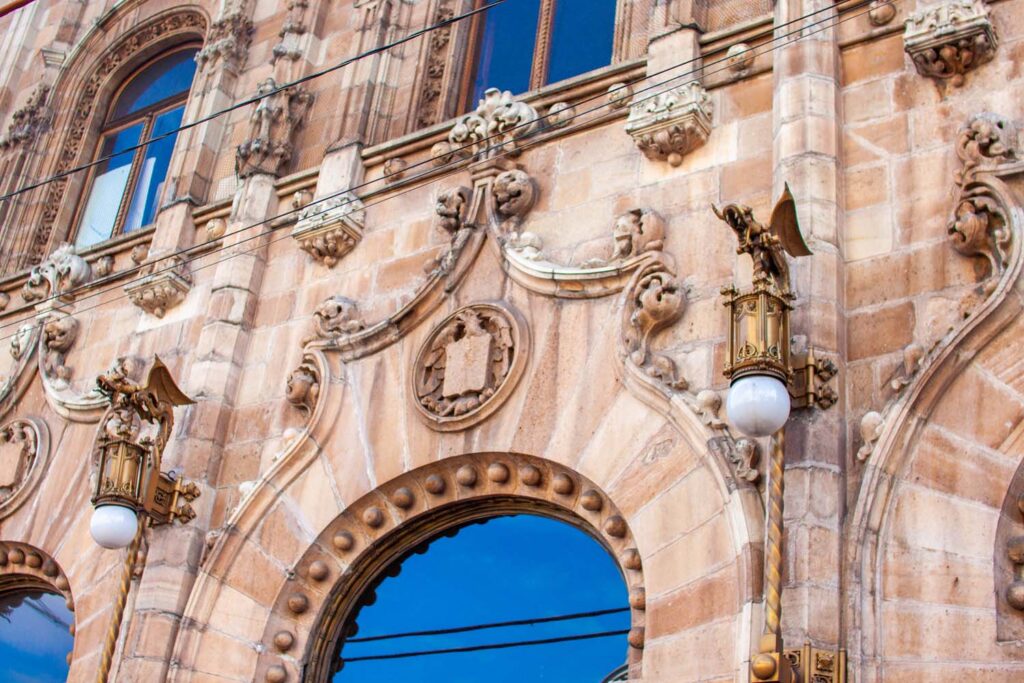
One of the interesting details of the building is the windows that look out onto the street. Take a closer look and you’ll see that the windows on each level are all different designs. Each of these unique window styles is set inside a familiar arch. This gives the facade a more cohesive appearance despite all the different things going on.
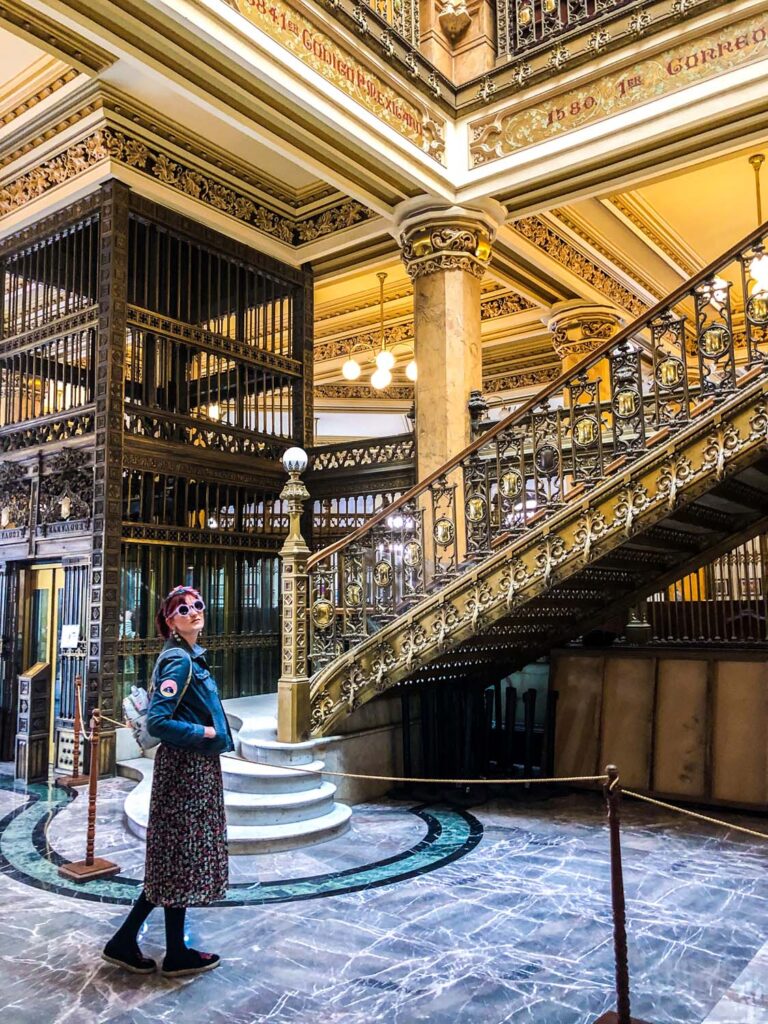
Interior
Stepping inside, you are immediately taken aback. Just like the exterior, the interior is awe-inducingly covered in ornamentation. Filigree cresting surrounds the entire building like a living piece of ivy, spreading out from every corner and growing out of control. The marble floors glimmer and shine. They are polished to the point of looking like a mirror, so they reflect the radiant bronze ironwork on the window frames and staircases.
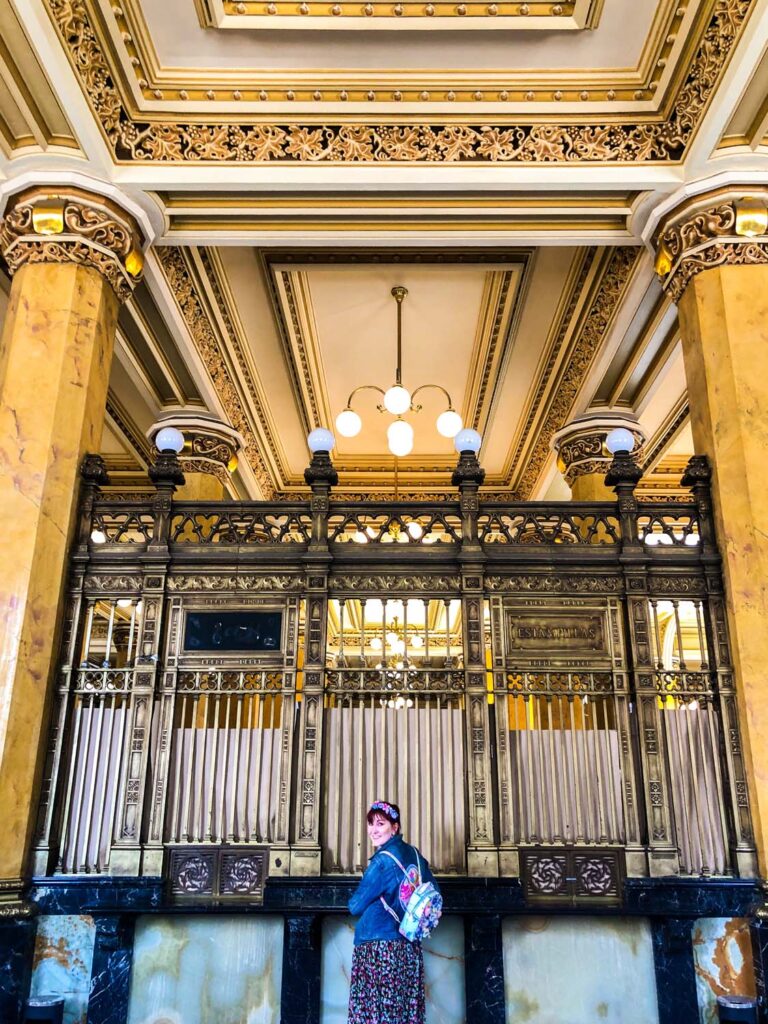
The main staircase descends down from two different directions from a central landing. The stairwell is bathed in bright sunlight from the large leaded glass dome that caps the top of the building.
Facing the staircase are a series of shields that crown the finishes of the interior arcade. These shields represent the various countries that were part of the Universal Postal Union at the beginning of the 20th century. This building is so iconic to Mexico that it inspired the design for the “Department of Family Reunions” in the Pixar film Coco.
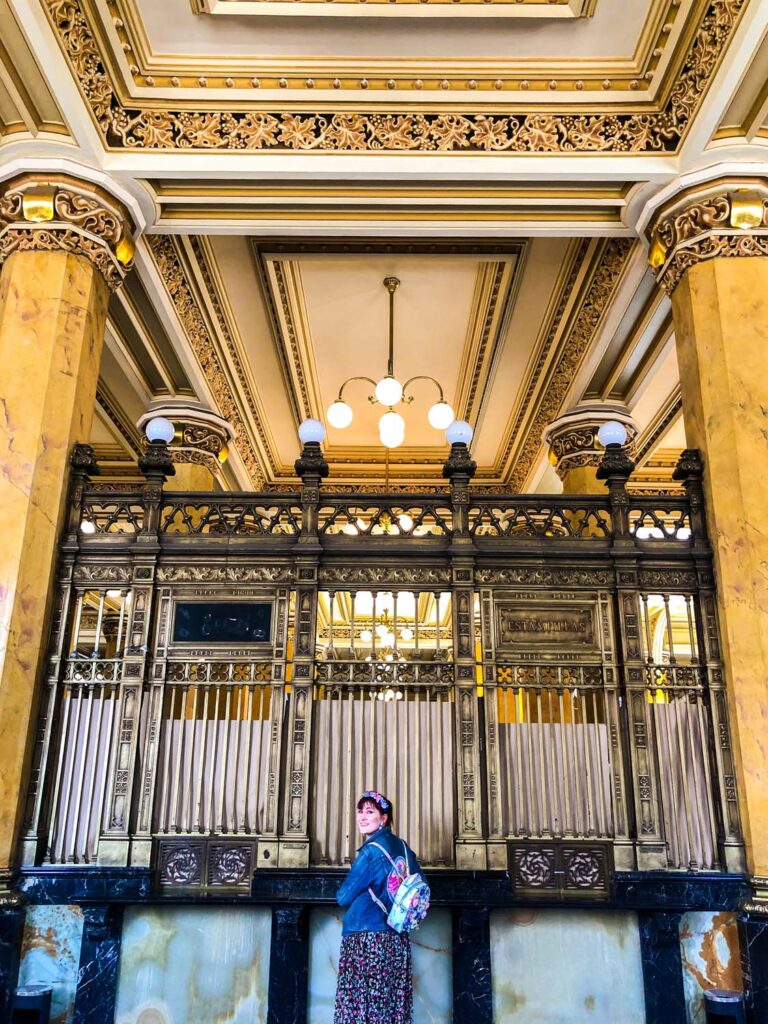

Museo Nacional De Arte (MUNAL)
Back on Calle de Tacuba, opposite the Post Office admire the grandiose Museo Nacional De Arte. This museum is worth a visit if you have a little bit more time, but for our purposes today, we are just passing by. This building is a real sight to see. It is one of the most impressive neoclassical buildings in Mexico City, built in the 20th century. The building was initially used as the old Palace of Communications. It was designed to house the Secretariat of Communications and Public Works. Mexico City wanted to show the rest of the world that they were a modern city, and one of the best ways to do this was to building yourself a world-class museum. Today museum houses Mexican artworks from the late prehispanic era to the early 20th century.
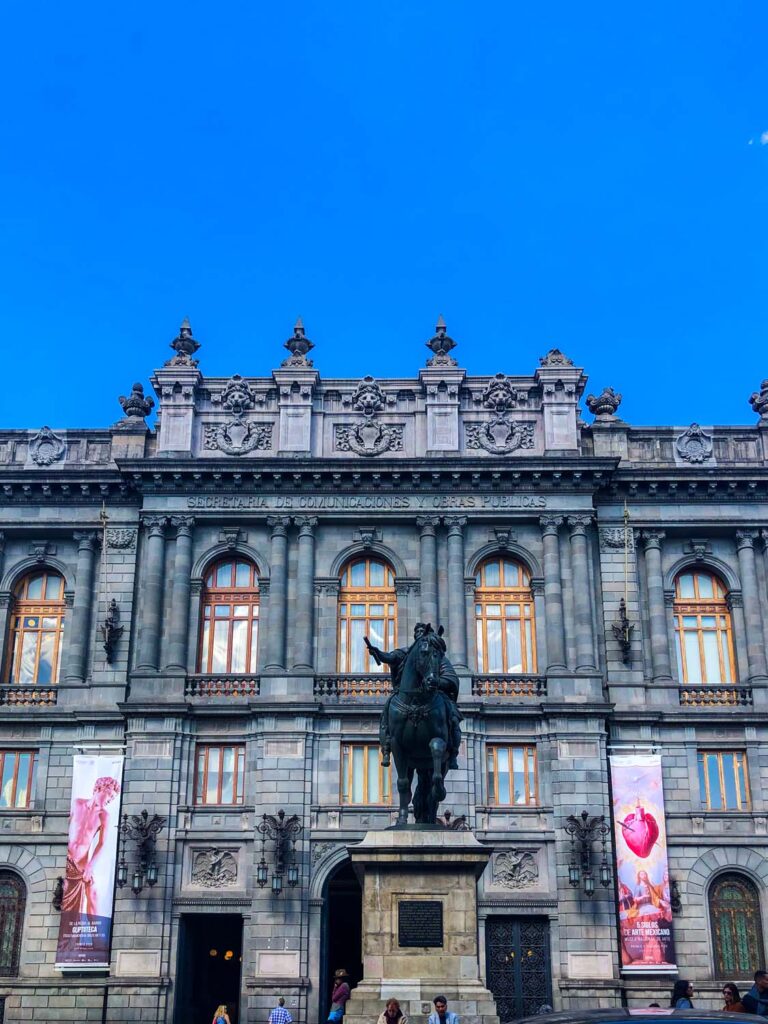
Cafe De Tacuba
Continue walking along Calle de Tacuba until you reach the burgundy painted exterior of the Cafe de Tacuba. You most likely will be able to spot this place from afar because it almost always has a line! It’s the perfect spot to grab some breakfast or brunch as the line isn’t AS long in the morning. Café de Tacuba has been a hot spot here in the Historic District since 1912. The restaurant gained real notoriety in 1922 when Diego Rivera held his wedding reception to novelist Guadalupe Marín here. Rivera would divorce Marín and marry one of the most famous Mexican artists, Frida Khalo. Another notable event that took place here was the assassination of the local governor of Veracruz, Manlio Fabio Altamirano Flores. You might think such an event would put people off but it only increased the draw.
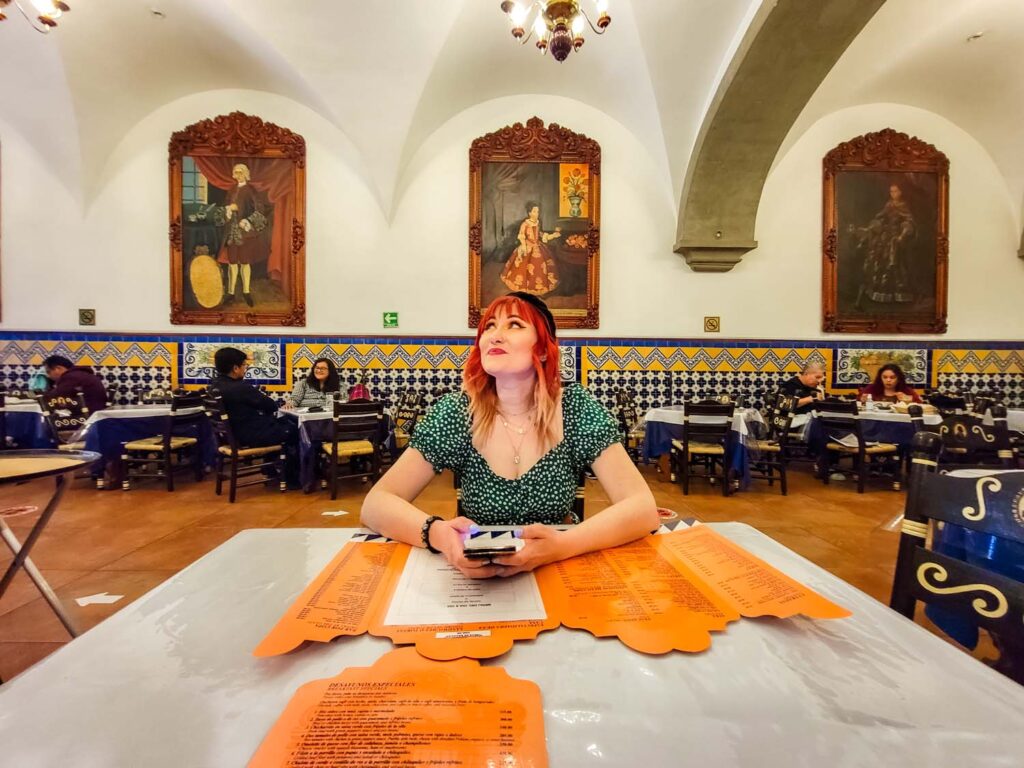
But it’s not just the history that brings people here. Aside from the amazing food, is the incredible interior design. The interior is covered in fantastical paintings from the pre-hispanic period. Vibrant mosaics and stained glass windows encircling the space make you feel like dining inside a museum. The entire menu here is based on classical dishes. Some of the best breakfast items include chicken tamales with green sauce, enchiladas Tacuba, Puebla style Garnacha, and hotcakes with honey.
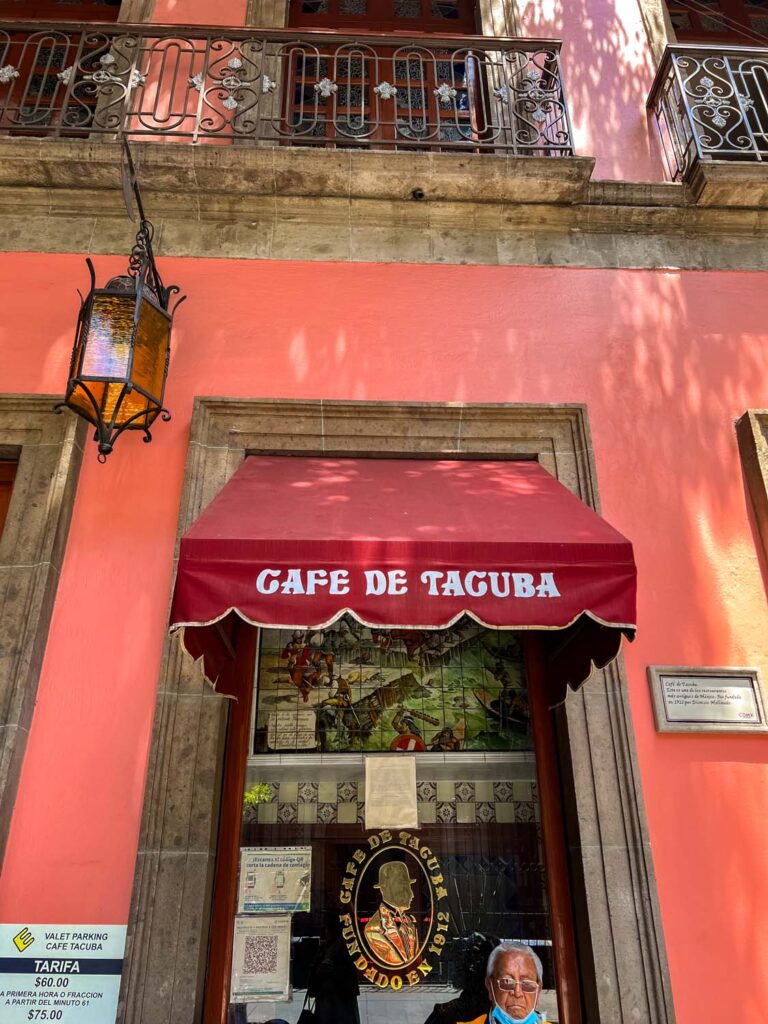


Plaza de Santo Domingo
After filling up on breakfast, continue walking east and turn north up the República de Brasil. At the corner of the República de Cuba and the República de Brazil is the Plaza de Santo Domingo.The name of the plaza comes from its location right beside the church of the same name.
The land in the Santo Domingo Plaza was given to Captain Don Cristobal de Oñate, Gonzalo de Salazar and the Marquis of Villamayor after Mexico was conquered by the Spanish. These men all built their large, luxurious residences around this square. They wanted their homes to be in close proximity to the nearby customs office. They each controlled a massive naval fleet that brought goods in from other Spanish-occupied countries like the Philippines. This brought a considerable amount of income into the new colony and just like today, customs and taxes took up a lot of time. So it was nice to live so close to work.
Josefa Ortiz de Dominguez
In the center of the plaza is a large circular fountain. In the center is a statue of Josefa Ortiz de Dominguez. Josefa Ortiz de Dominguez was a heroine of the Mexican War of Independence. She fought for the Mexican people and was a part of several conspiracies to overthrow Spanish rule. Ortiz de Dominguez would falsify documents in one of the 614 illegal print shops that spread across the plaza and surrounding area. Ortiz was eventually caught and found guilty. Instead of facing the gallows, as a woman, she was placed in a nunnery. She managed to secure a release if she promised to stop her efforts in the rebellion. Which, of course, she did not. Even in her old age, she aided several radical political groups involved in the independence movement. In 1910, Ortiz de Domínguez was the first woman to be depicted on a Mexican stamp!
On the west side of the plaza, you can see the Portal de Evangelistas leading into the church of Santo Domingo. Although this plaza is slightly farther away from the traditional tourist track, this little square is one of my favourites. It seems that whenever you visit, there is always some sort of festivities going on, and the entire plaza is adorned with brightly coloured decorations.
Old Customs Buildings
Directly opposite the plaza is the burgundy awning which covers the facade of the Old Customs Buildings. The customs house was responsible for the taxation of all items imported and exported in “New Spain.” “New Spain” was the name for Mexico during the 17th century when the customs house was first established. The building you see today was the newly built version constructed in 1730. One of the reasons I adore Mexico City is that you can see such historic buildings that have been preserved so well. Eventually, the customs offices needed to be expanded. The building was left empty until the Secretary of the Public Education Department took over.
The structure is made from a very unique material only found here in Mexico. The stone is called “tezontle.” Tezontle is dark red and a porous volcanic rock. It was one of the most popular materials used at this time and gives all the buildings from that era a special texture and appearance. The white stone around the windows, balconies and doorways provides a beautiful contrast, almost highlighting the uniqueness of the tezontle.
Palace of the Inquisition
Before heading into the west part of the plaza, look at the building on the corner of República de Brasil and República de Venezuela. This is the ancient Palace of the Inquisition. The building is notable for its dramatically “cut-off” corner facade facing Santo Domingo Plaza. The Mexican Inquisition was one of the darkest parts of Mexico’s heritage. Although everyone knows the famous “Spanish Inquisition”, their inquisitors also set up operations in their new colonies.
The Inquisitors were essentially a judicial institution that aimed to combat heresy. Heresy was considered an opinion profoundly at odds with what is generally accepted. And what was “generally accepted” was defined by the government of the time. Unlike the judicial system we have today that is based on fair trials and evidence, the inquisitors relied on brutal methods. This included torture, to get their “confessions” out of the accused. Often, this resulted in false confessions by the victims, as they would do anything just to get the pain to end.
Mexican Inquisition
The first inquisitor to arrive in ‘New Spain’ was Pedro Moya de Contreras. He arrived in 1526 and immediately went about building a new monastery for his Dominican order. Right across the street from the Palace of the Inquisition he built the Church of Santo Domingo. At the time, the current Palace of the Inquisition was a part of the monastery where Contreras and the other inquisitors worked. Their first big case was in 1566 against Martin Cortes, son of Hernán Cortés. There were rumours that Martin Cortes wanted to make New Spain an independent colony. That would mean all the resources that Spain had gained by colonizing Mexico would be lost. Which was a no-go for the government.
But even more upsetting was the fact that instead of investigating Cortes himself, they went about brutally torturing his enslaved Creole workers. When they were found guilty, they were decapitated, and their home near the Templo Mayor was razed. The site was sown with salt, a typical practice on conquered cities to symbolize a curse on their re-inhabitation. Just more proof of how brutal the colonization of Mexico was.
Life after Inquisition
When the Inquisition was disbanded, the building was put up for sale, but no one wanted to buy it due to its horrific past. It was finally purchased by the local archbishop, perhaps as a pity bid, but the building passed hands many more times. That was until 1854 when it was sold to the School of Medicine. But the cursed nature of the building seemed to persevere. In 1873, the famed romantic poet Manuel Acuña committed suicide by poison inside the school. Today, despite the building converted into the University’s Museum of Medicine, you can still make out the coat-of-arms of the Inquisition on the facade. This is depicted on the crest with a cross, branch and sword.
Santo Domingo
Walking towards the west side of the Plaza, you’ll be able to admire the exterior of the great Church of Santo Domingo. The architecture found on this building is very precious as it is the last remaining monastery from the original ‘New Spain’ constructions. When the Spaniards arrived in Mexico in 1526, the Dominican orders immediately established houses of worship. But many churches needed to be rebuilt over the years. Architects from the new world didn’t know how to cope with the soft soil and earthquakes that plagued the area. The church uses mainly the same dark tezontle rock framed in white cantera stones.
The twelve columns on the facade of the church facing onto the square represent the twelve apostles. In the portals on the first floor, we can see Saint Francis and Saint Augustine. Above them, we can see Saint Dominic kneeling as he receives the keys to the kingdom from Saint Peter and Saint Paul. There is a more miniature bas relief carving of the Assumption set between two small choir windows on the top level.
Street Names in Mexico City
Walk along the Republica de Columbia and then back south down Republica de Argentina. You might have started to notice a pattern surrounding the street names in this area. Most of them were named after Latin American countries. Brazil, Chile, and Argentina are all given their own streets. But this wasn’t originally the case. These street names were revised from the original wording in the 1920s by President Alvaro Obregon. During this time, Mexico was in the middle of a bloody revolution. Representatives from these other Latin American countries were sent to Mexico to help President Alvaro Obregon in the uprising. The renaming of the streets was seen as a sign of gratitude towards these countries. But it meant erasing the original naming conventions and with it their history.
In the Historical Centre, you’ll also find streets named after important dates in the country’s history. Cinco de Mayo and 16 de Septiembre are just two of those famous examples. Cinco de Mayo is the commemoration of the Battle of Puebla in 1862, when the French triumphed briefly over the French.
The 16th of September is also known as the “Cry of Dolores” day. On September 16th, 1810, the church bells (known as Dolores) rang as a call to arms that triggered the start of the Mexican War of Independence.
Trade Streets
Since the dawn of Tenochtitlan, Mexico City has been a hub for tradesmen and craftspeople. Many of these trade guilds were given a particular street to work out of. That street was therein known as the “metal workers street” or “shoemakers street.” Even today, in the shopping districts in the Historical Center, this trend of grouping businesses together still exists. You’ll pass a block where you’ll only find fabric stores, or button sellers, or goldsmiths. There is even an entire block dedicated to party decorations!
Cities and Authors
Various districts and neighbourhoods in Mexico City chose their own thematic naming conventions. In the Historical Center, in addition to the names of Latin American cities, we also see streets named after famous military generals like General Molinos del Campo, General Zuaza, General Leon, and General Gomez Pedraza. Roma Norte‘s streets are named after Mexican cities and states. Colonia Juarez contains streets named after international cities. You’ll find Calle Londres (London), Calle Tokio (Tokyo), Amsterdam Avenue, Calle Liverpool, Oslo Street, Hamburg Street, and even Florencia! Colonia Cuauhtémoc on the north side of the Reforma has streets named after rivers; Rio Nilo, Rio Po, Rio Tigris, Rio Elba, Rio Amazonas and Rio Sena. In the upscale area of Polanco, you’ll find the area dotted with streets named after famed men of thought and letters like; Parque Lincoln, Calle Socrates, Avenue Homer, Oscar Wilde, Schiller, Tennyson and more!
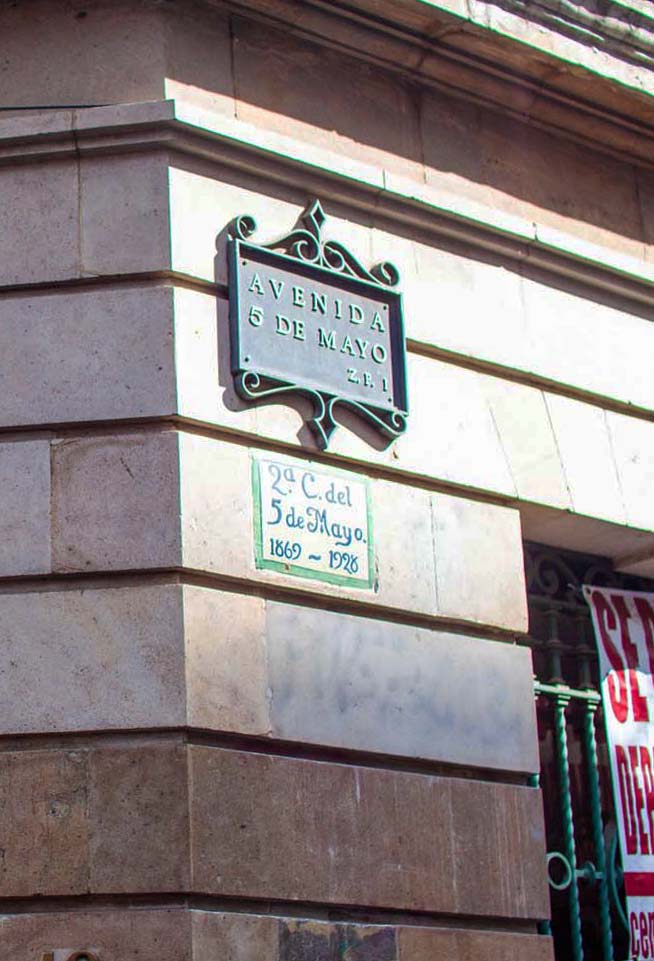
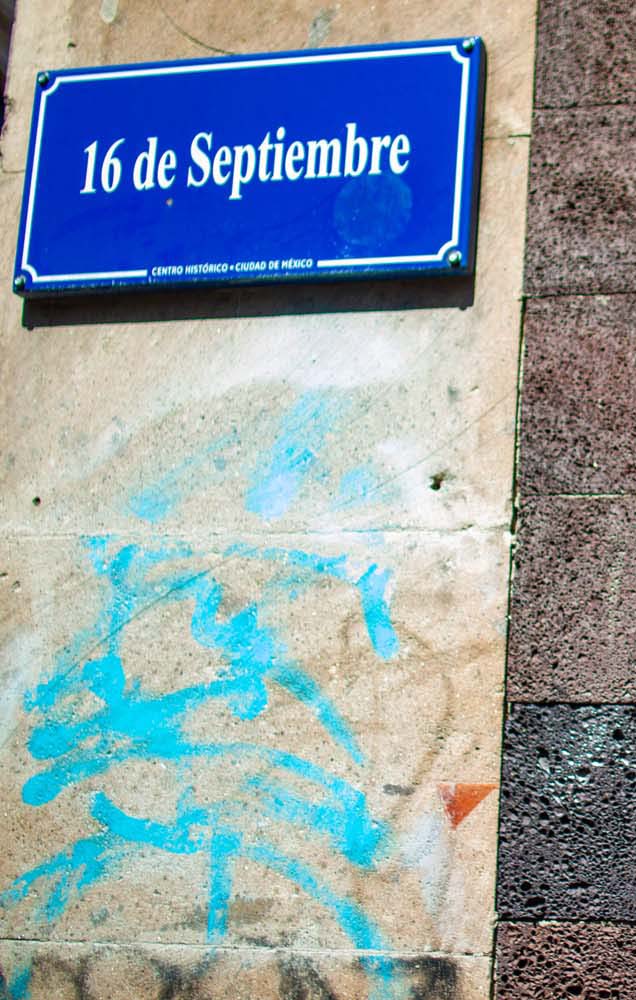
Secretariat of Public Education Main Headquarters
The large building that now houses the Secretariat of Public Education Main Headquarters is spread over an entire city block. The main facade faces out onto Republica de Argentina. This side has a completely different look than the older parts of the building we saw previously facing the Plaza Santo Domingo. This modern extension has a classical Greek design featuring Ionic pilasters and sharp lines. On top there is a large stone sculpture of the Greek gods; Apollo, Minerva, and Dionysus. Beside the greek statues are two sets of Aztec and Spanish-style weapons. The entrance to the building is marked by three large metal grilles with the initials “SER” on the front. This stands for the “Secretariat de Education Publica.“
Diego Rivera Murals
Walk through the iron gates to enter the open-air courtyard. You’ll usually see two armed guards on either side of the doors. Since this is still a government office, they take security seriously. Tell them you are there to visit the Diego Rivera murals. If there aren’t any private events going on inside the courtyard the guards will usually let you right in but might do a quick security check of any bags you might be carrying. Inside the doors, you’ll enter the first of two large adjoining courtyards. Covering the walls of the courtyard are 235 panelled murals painted by none other than Diego Rivera. This was Rivera’s first large-scale painting project.
Rivera and Vasconcelos
Although born in Mexico, Rivera had travelled to Paris and Italy to study under great masters like Pablo Picasso. He returned to Mexico to participate in a new mural program started by the Secretary of Public Education, José Vasconcelos. Vasconcelos thought that art was a powerful tool for education. He went about commissioning large-scale mural projects across the city to bring art to the public. This project took place after the great Mexican Revolution. The air was to use art to help communicate to the people that this new government would guarantee the new life promised by the revolution.
Like many of his contemporaries, Rivera believed that “easel painting” was considered too aristocratic. He and his contemporaries believed that large, public murals could reach a larger, broader audience. Art didn’t need to be hidden away inside stuffy museums or only appreciated by those with a critical eye. Art was for everyone.
Education Mural Themes
Rivera started work on the murals in 1923, and it took the painter five years to complete. Despite the overly Greek-influenced exterior, these murals focused powerfully on the Mexican identity. It followed themes of the Mexican Revolution and the glorification of the dedicated Mexican labourers. His themes are divided by the two courtyards. The larger courtyard focuses on “Labour,”and the smaller courtyard is dedicated to the “Fiesta.” Unlike so much of the European influence covering the colonial parts of the city, these murals focused on the regular Mexican people.
Fiesta Courtyard
The smaller Fiesta Courtyard is the first one you’ll enter. Here there are murals on the ground floor depicting various meaningful events in the Mexican calendar. You’ll see scenes from the Deer Dance, the Day of the Dead, the Corn Fiesta, the Meeting on May 1st, Good Friday and the Ribbon Dance.
Walk up the stairs to the second level, where you can view one of the most important of Rivera’s murals called “The Arsenal.” This massive painting portrays a group of revolutionaries preparing for battle. In the center, you can see the image of a young woman in red wearing the communist star on her shoulder. The woman who posed for this painting is none other than Rivera’s future wife, Frida Kahlo. Hovering above the murals, Rivera painted a sprawling red banner connecting one piece to the other. The text written upon it are words to revolutionary songs called “corridos.”
Labor Courtyard
The larger courtyard surrounds a beautiful green garden full of lush foliage. In this area, you can see scenes depicting Mexican labourers. You’ll find images of mineworkers, sugar mill labourers, craftspeople using looms and dying fabric, smelters working the oven, and busy farmers selling their goods in the marketplace.
On the second floor staircase, are a series of murals highlighting Mexico’s diverse landscape from the bright blue coasts to the dense mountains. The murals on the second level here are dedicated to what Rivera considered the four primary elements of painting. These are light, colours, man and geometry.
Palacio Nacional
To finish off our tour of Diego Rivera’s mural, a visit to the Palacio Nacional (National Palace) is in order. The Palacio Nacional is an enormous museum with so much to see and do. But for our purposes, we are just entering to see the courtyard murals. Once we arrive at the Zocalo, we will speak a little bit more about the grand facade but for the time being, let’s go inside to get a look at the courtyard.
Entrance to the National Palace is free, although there is usually a long lineup to get inside. You need to leave a piece of ID with the guards at the door. Since the Palace is still home to the offices of the Mexican President, security is critical. They need to control the number of people and keep track of exactly who is inside. Entrance to the National Palace can be found on Moneda Street.
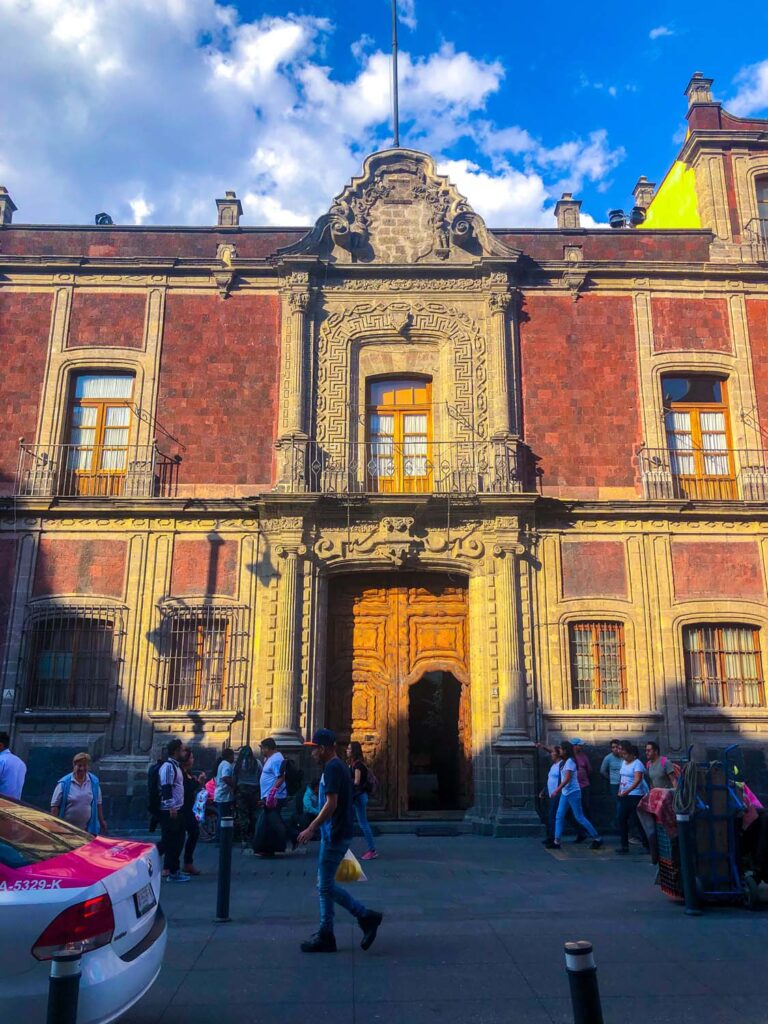
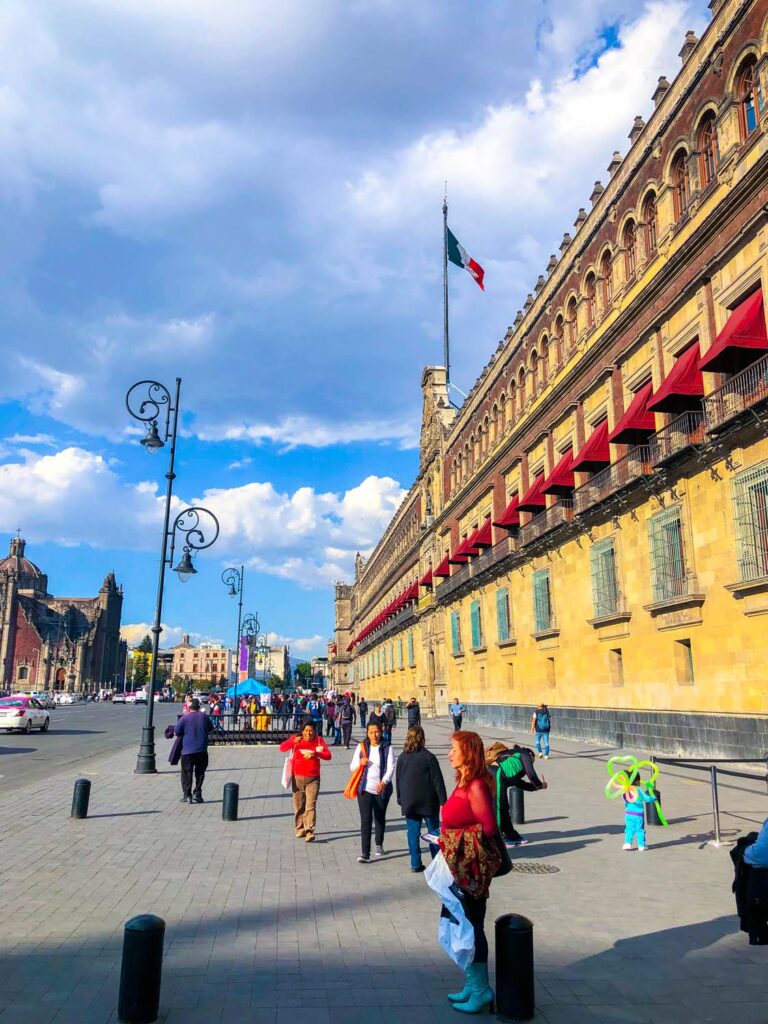
History of the Palace
The site of the building was once home to Moctezuma II’s Palace. His grand residence was built in 1521. When Cortés first visited the Palace, he described it as having a surprising array of riches. The walls were made of marble, and the facade contained a carved shield of Mexico’s iconic eagle with the snake in its claws. Inside, the building was very modern, with sanitary facilities, fountains, gardens, bedrooms with rich tapestries of rabbit fur and feathers. In addition to being a royal residence for the rulers of the Aztec city, it was also a meeting place for the elder tribe members. Here disputes and discussions would take place to ensure the wealth and happiness of their people.
Sadly, after the invasion by the Spanish, Cortés seized the residence from the Aztecs and used it as his own home. Passing it down to his son in later years. The Palace suffered a devastating fire in 1692 that destroyed much of the original structure. Many of the original stones that could be recovered were used in the reconstruction efforts. However, the design of the new Palace was a much different style. This one was styled in the Baroque fashion of the time. It seemed that over time, every generation added their own touch to the building. And now, it looks more like a patchwork quilt of the ages.
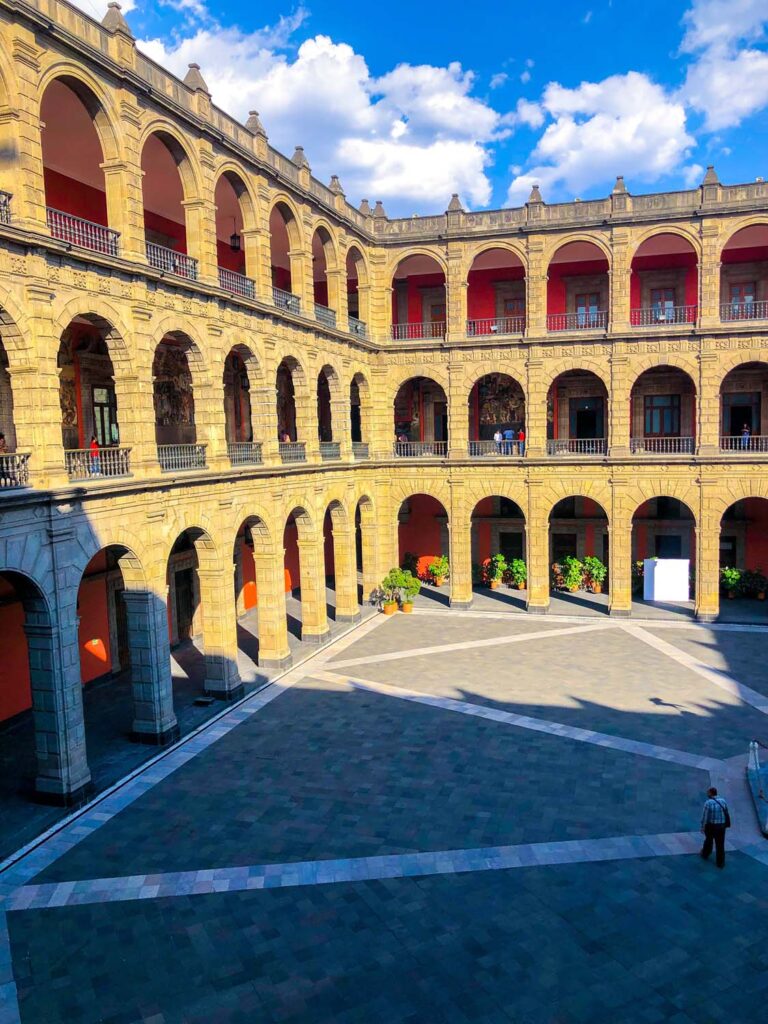
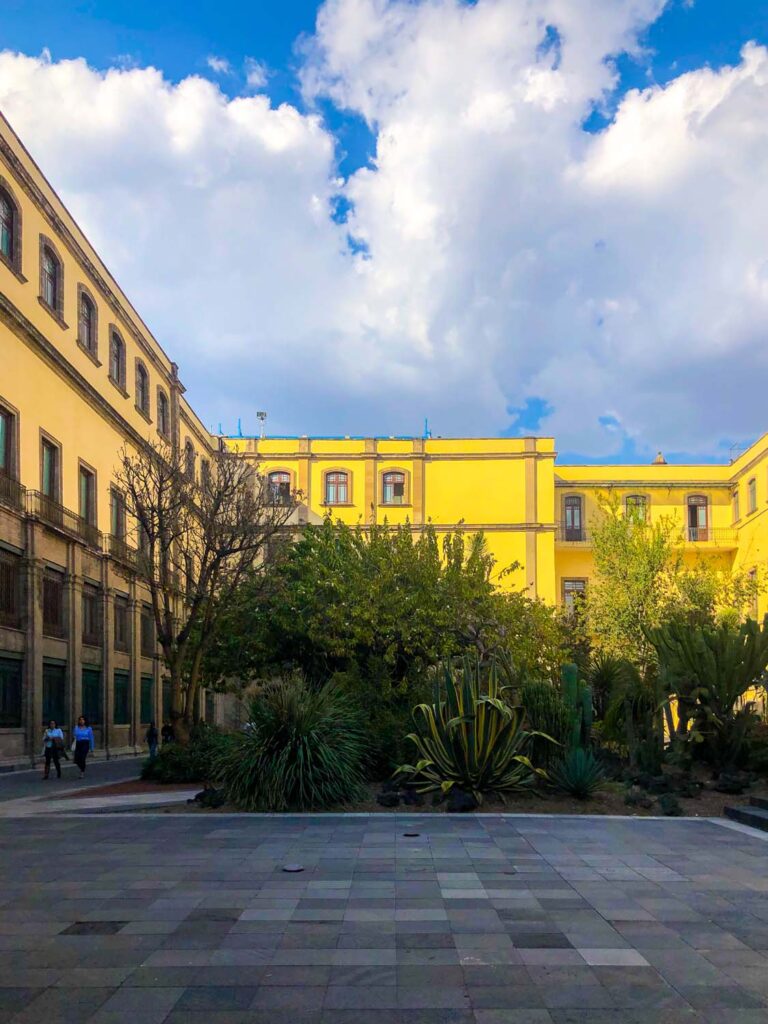
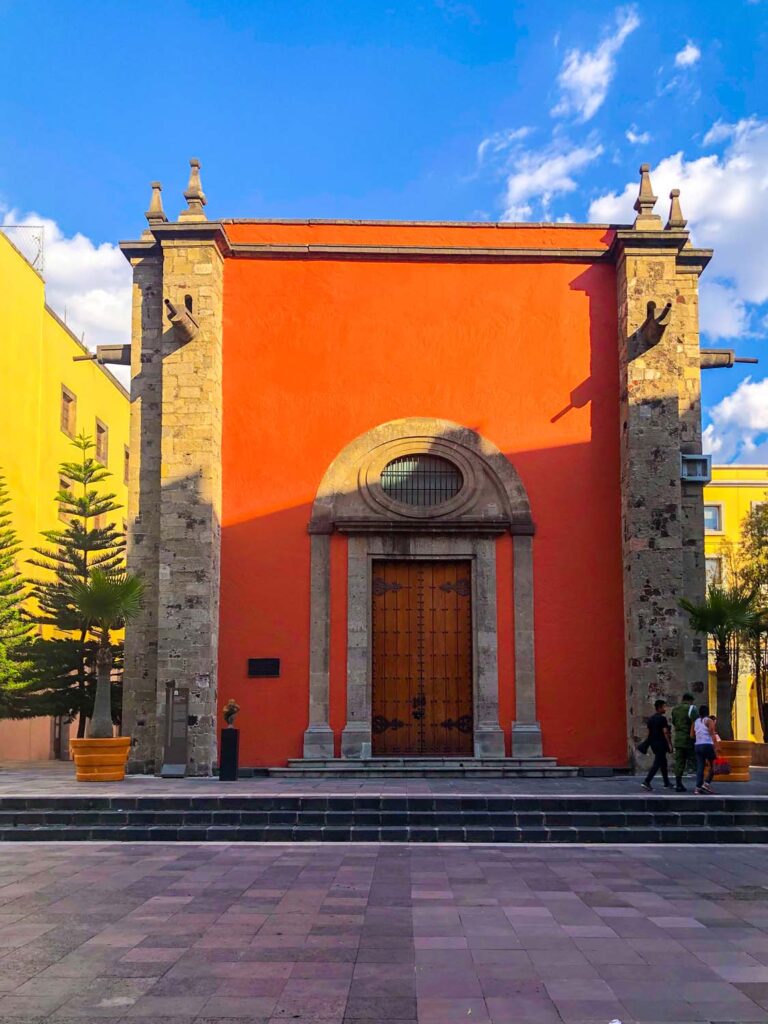
History of Mexico Mural
Walking inside the National Palace, follow the signs for the ‘History of Mexico Murals.’ These can be found within the great courtyard, surrounded by Baroque arches. Walk up to the main stairwell, where you’ll immediately be struck by this immense masterpiece. The mural depicts the history of Mexico from the dawn of human existence through to the 1920s. Rivera started work on this mural in 1929, many years after his first mural project. The precision and confidence in his technical skills and expressive style are evident in this work of art. Rivera was decisive in using his art to communicate his ideologies about communism and the decisive rejection of the colonizers. He wanted to bring the crimes of the part clearly into the people’s minds to ensure these atrocities were never forgotten.
The main message of the mural surrounds the indigenous Mexican people’s struggles to preserve their culture, National identity and country against the brutal colonizers. Standing at the base of the stairwell, take a minute to appreciate the sheer grandeur of the entire piece. So much of the story is a sad one—a classic tale of good vs. evil. The goodly indigenous Mexicans had one of the most vibrant cultures. Yet, they were practically wiped out by the evil, invading Europeans.
If you squint and look at the entire piece as a whole, the bright colours and expressive shapes look powerful, hopeful and strong, just like the Mexican people. Despite the horrors of the past, the post-revolution population believed in the future of their country. Especially as it became an independent nation. And that their strength and perseverance over the years was what would conquer evil and allow their great country to prosper.
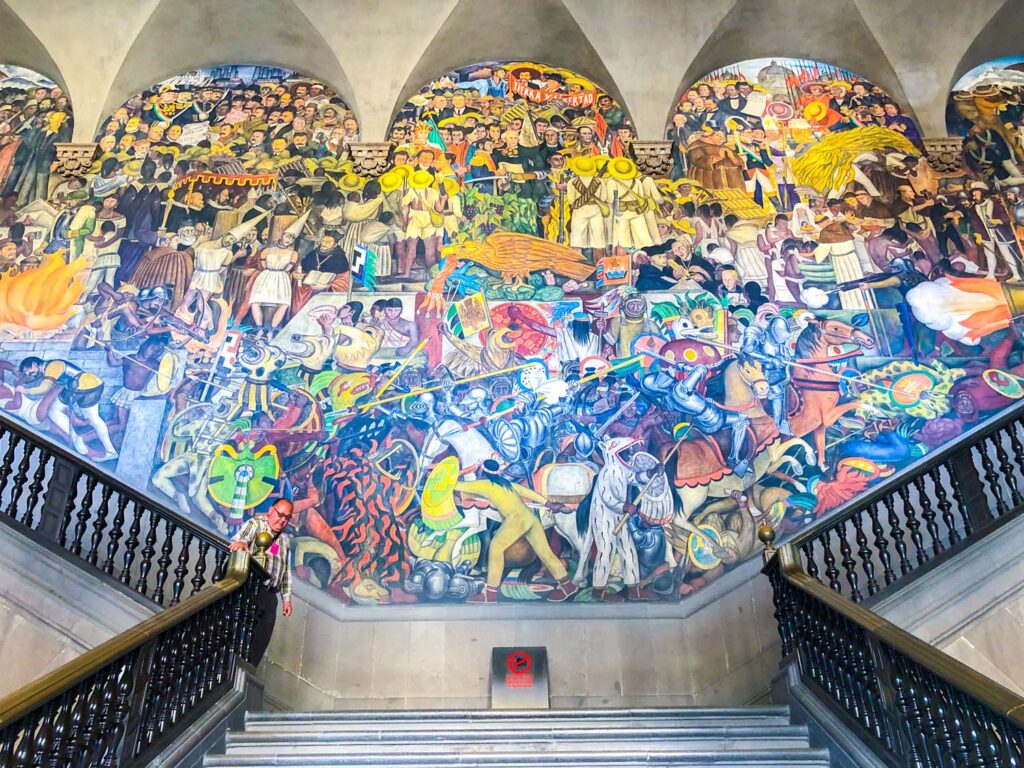
North Wall
Walk up the stairs to the landing in the center, and look up at the left side, or North Wall. This part of the mural depicts the indigenous Mexican’s long before the arrival of the Spaniards. They are surrounded by the fantastical Mexican landscape all around them. The blue is almost heavenly above—the large bright sunshine above, casting all of them in celestial light. The Aztecs believed in the sun god, as can be seen in the all-seeing eyes painted onto the sun’s face. Just below the sun, you can also see an erupting volcano with Xiuhtecuhtli‘s “the Lord of Fire” exploding from the mouth of the volcano. In the sky flies Quetzalcoatl, the Feathered Serpent deity and god of the wind and the rain.
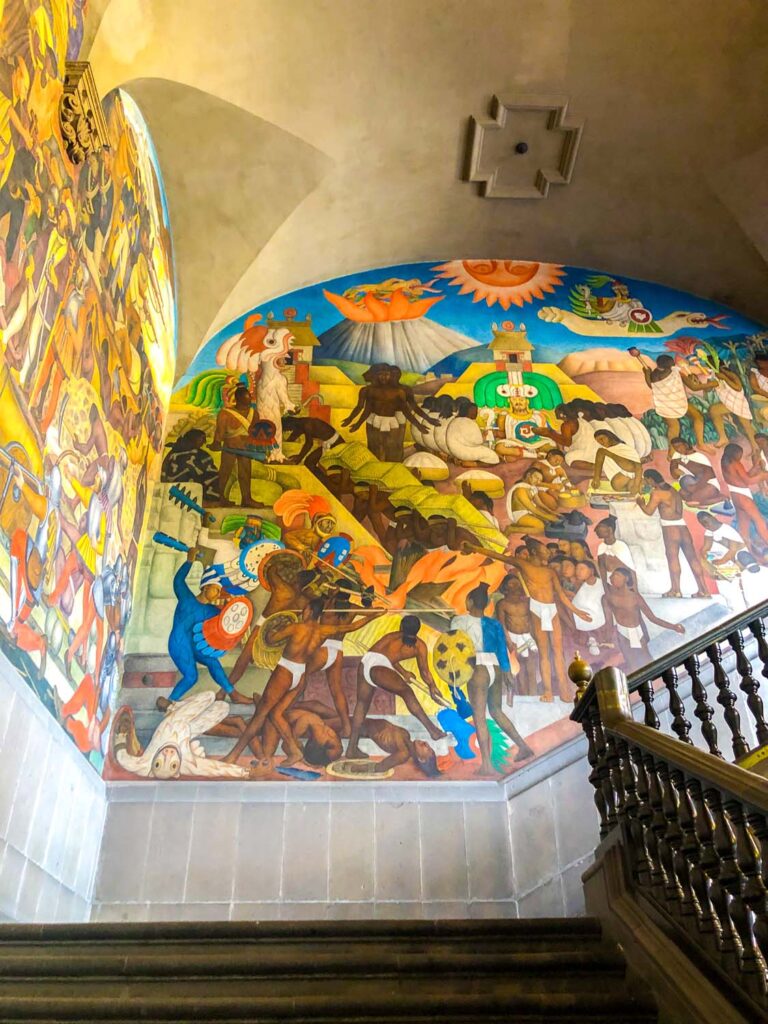
The Valley of Mexico is spread out along the horizon, with its amazing pyramids towering above the people. Standing in front of the pyramids are the Aztec leaders, guiding and looking after their citizens. In the left corner, you can see a small battle scene between two tribes. This violence was a common occurrence in any civilization but the cultural costumes worn by the different tribes is what makes this little vignette so interesting.
Farmers are tending to vivid corn crops, almost as bright as gold. Craftspeople in the lower right-hand side of the mural are busy weaving, making pottery, playing music, painting and writing on scrolls. This just shows what a modern civilization they had full of technology, art and even science! They were the farthest thing from “savages” as was reported by the violent Spanish colonizers.
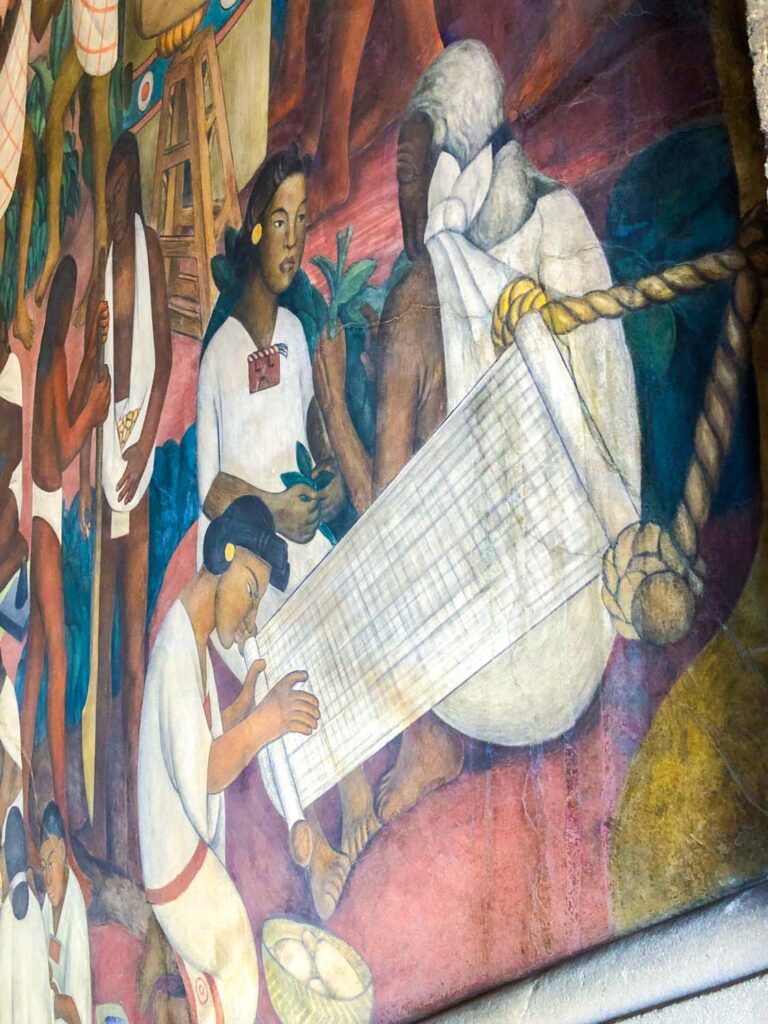
West Side, Main Wall
We move from the north wall’s idyllic memories to the densely packed and violent images of the west wall. This is the mural straight ahead as you walk up the main stairs. It is the battle of the Mexican people against their oppressors. A story of hatred and war, woven into the fabric Mexico’s history.
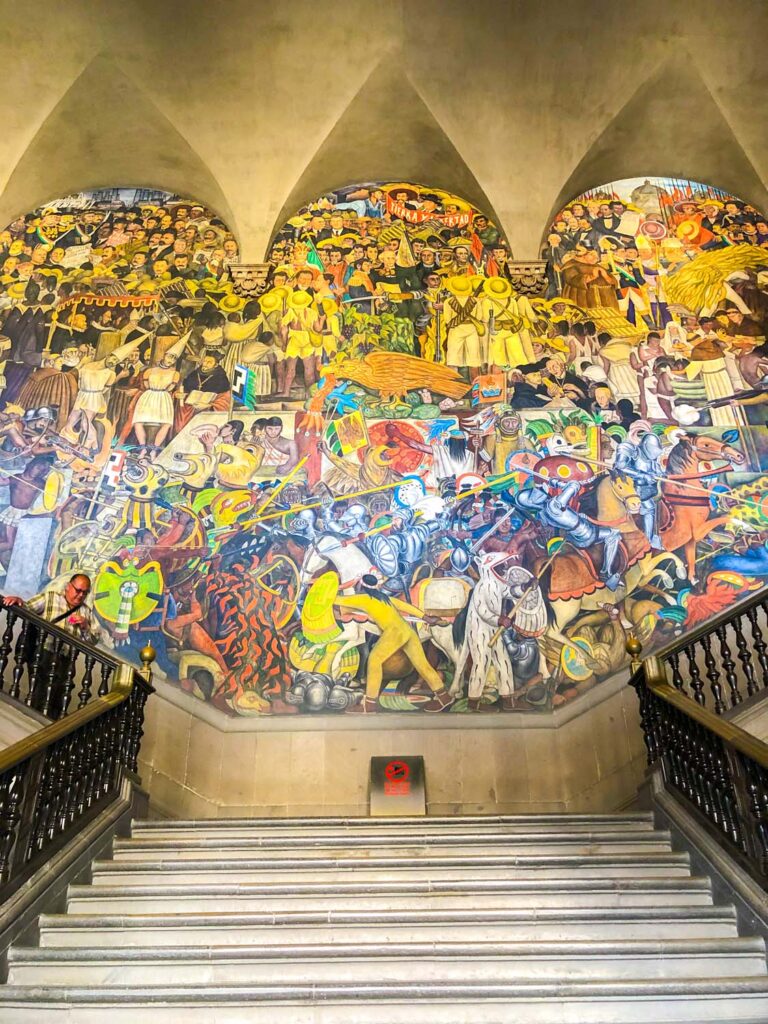
Lower Level Depictions
The lower part of the mural is riddled with images of Mexicans and Indians clamouring to fight against the heavily armoured calvary of the Spanish and French attackers. The beautiful and bright feathered costumes of the Aztec leaders, crushed and fallen under the feet of their enemies. Cortez himself can be seen in the middle of the painting, as he is the only mounted soldier with his face exposed. The rest of the attacker’s helmets are closed but Rivera paints Cortez with his helmet raised so his actions are not anonymous.
Cortez’s armies have modern weaponry making their defeat of the Aztecs a foregone conclusion. Despite them being outgunned and outnumbered, the Aztecs fought valiantly against the Spanish as seen on the right and let corners. All the while, the Aztecs are being watched over by a great golden eagle in the center. The eagle sits perched atop a cactus with a serpent in its mouth. The design of this symbol is rooted in the legend that the Aztec people would build their great city in the spot where they found an eagle eating a snake on top of a cactus. They called that place Tenochtitlan (Mexico City), and to them, it was worth fighting for.
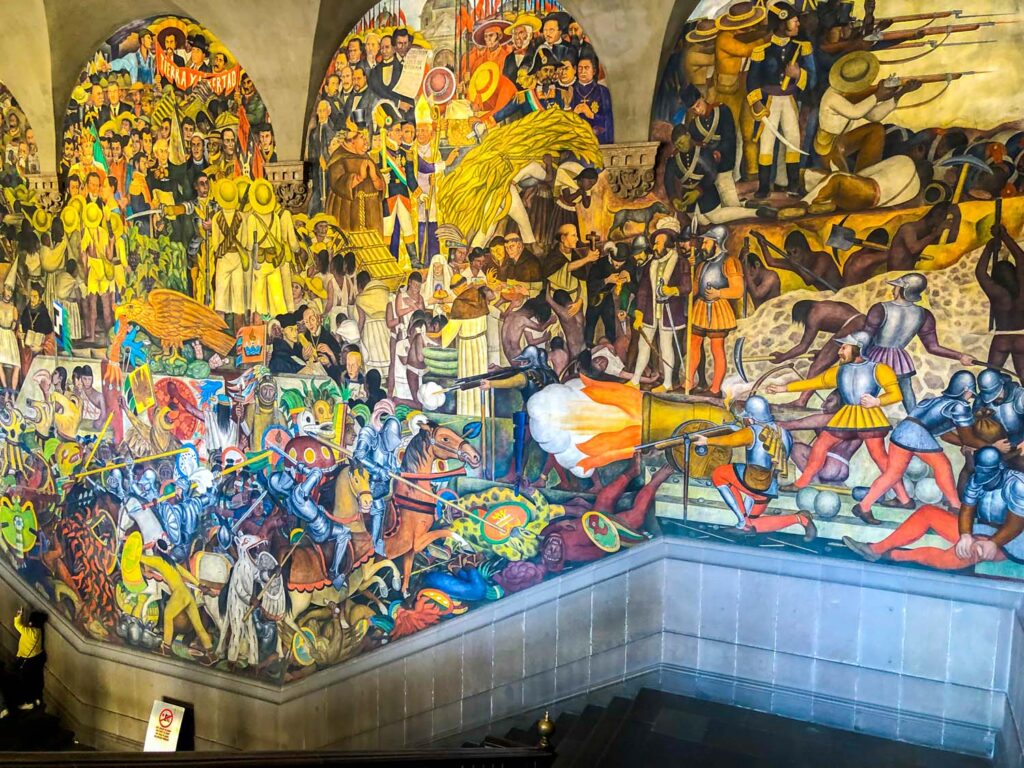
Middle Depictions
In the middle of the mural, we see the horrors brought to Mexico by the Spaniards. Not only did they want to conquer the land, but they also wanted to abolish the Aztec religion. The Inquisition went about burning sacred books and religious imagery. You can see these fires burst out across the wall. Priests on the left-hand side can be seen forcefully converting the indigenous people to their new religion of Chrsitiniarity. The Spanish turned many natives into slaves, and it was these hard-working people who were the actual creators of this “new world.”
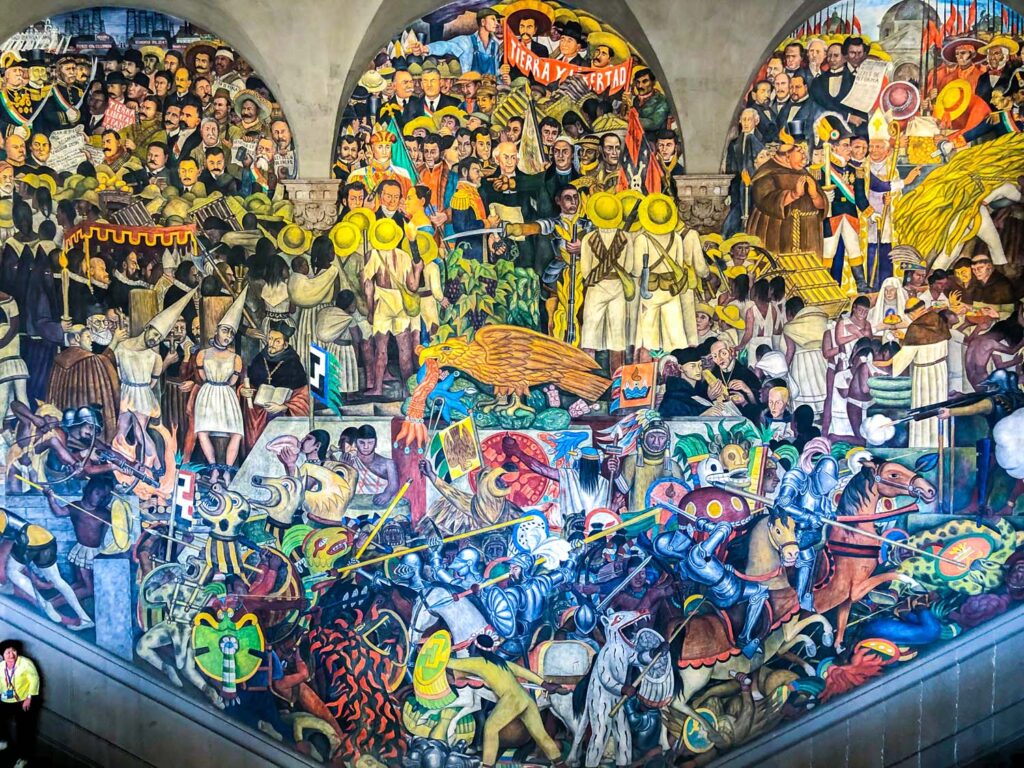
Upper Arch Depictions
Under the five arches at the top of the wall are the various rulers of Mexico. Interesting to note is Rivera’s use of non-hierarchical representation. No one man is larger than the other. While some people think makes the mural more challenging to interpret or read, it is part of Rivera’s communist ideologies of equality.
Starting from the left, we see the French Rule and execution of Austrian Emperor Maximilian in 1867. Next to that, we see images of the Porfirian Era. This era was coloured with a brutal dictatorial rule accomplished through a combination of consensus and repression. In the central arch, we see depictions of Independence and the Mexican Revolution. At the very top of the frame, you can see a man with a mustache carrying a large red banner. This is revolutionary Emiliano Zapata, who was one of the leading men in the Revolution. The red flag says “Tierra y Libertad,” which means “Land and Liberty.”
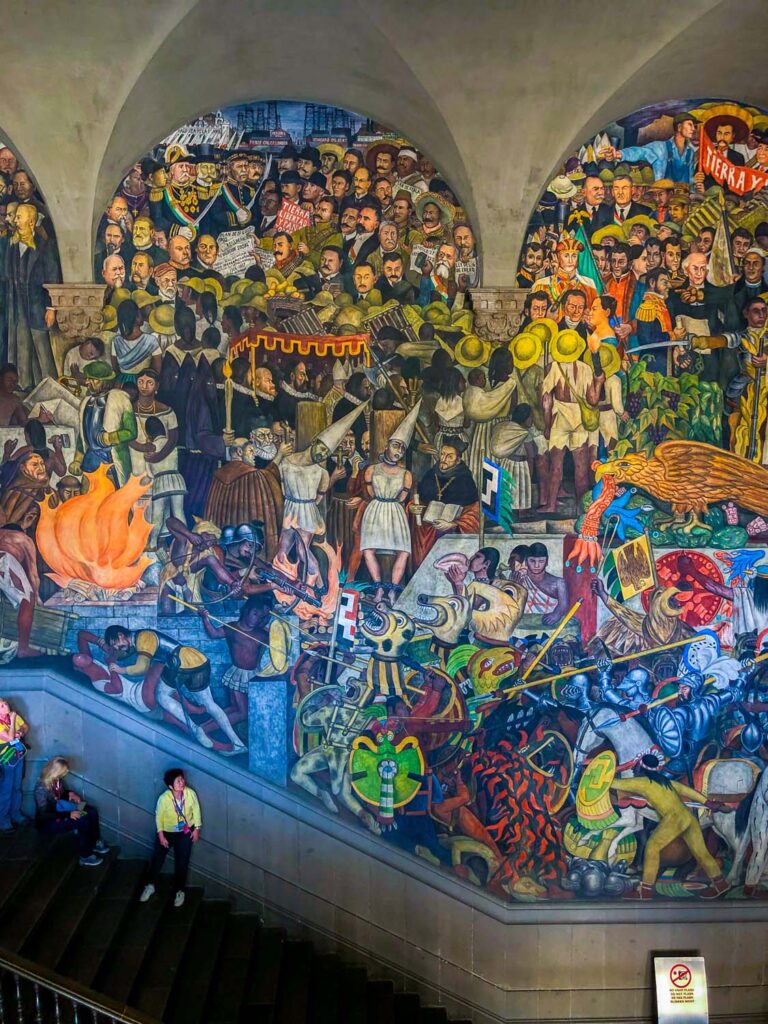
To the right we see images from the Reform and Juarez era. Benito Juarez was Mexico’s only Indigenous president and considered the founder of the new Mexican nation. Finally, on the far right, we have the invasion of Mexico by the US. Aabove the invading US army is the great eagle flying down to attack.

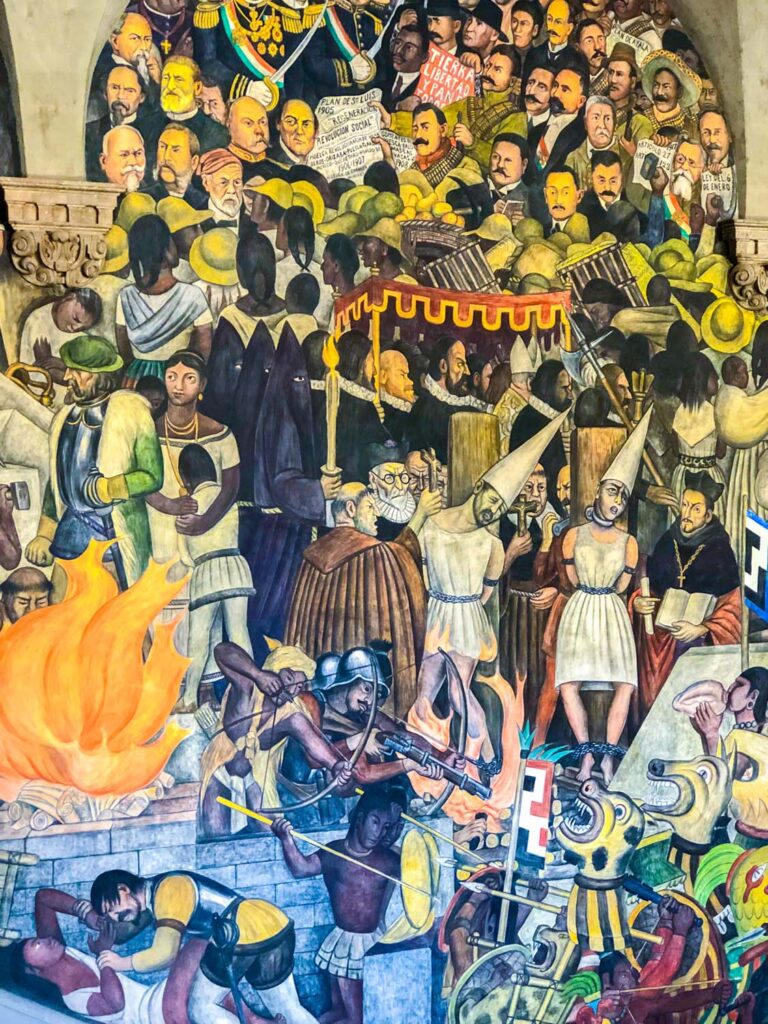
South Wall
The south wall to the left of the main stairwell depicts the future of the Mexican people. The imagery represents the ideals of progress, prosperity and hope for a better future. At the top of the mural is the image of Karl Marx holding his great Communist Manifesto on a large scroll. To the right of this is a man flying the Soviet flag. When the mural was painted, the Mexican people and Rivera himself had solid socialist tendencies and the Soviet flag can be seen throughout imagery from this era.
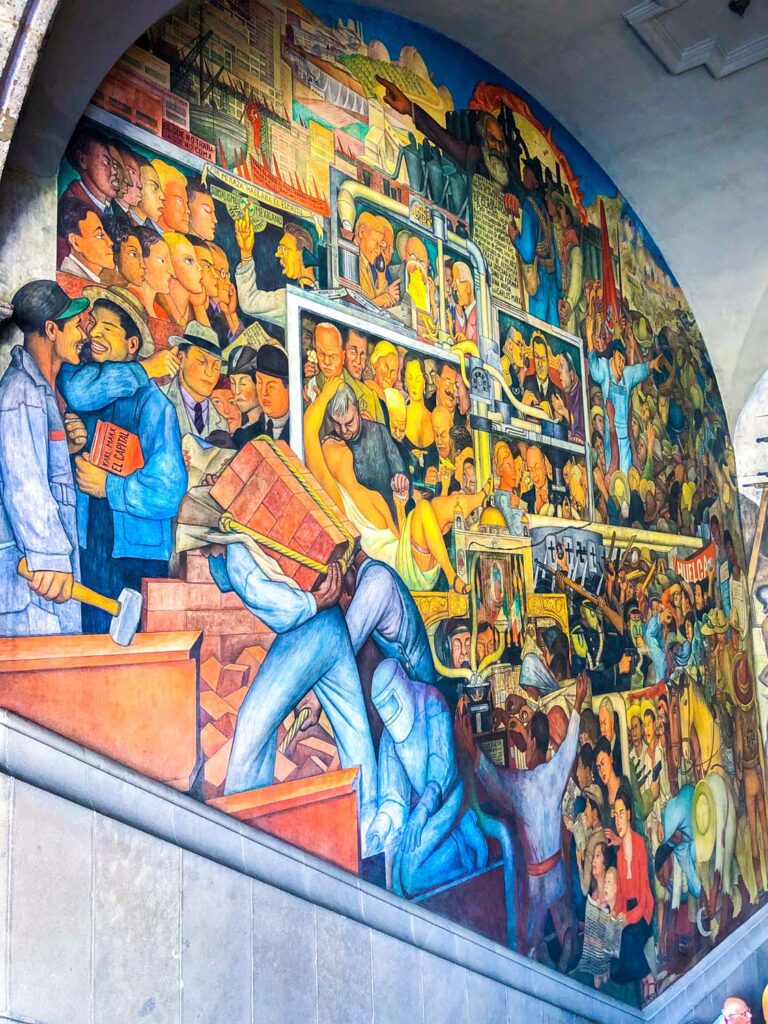
To the right of Karl is a scene of Mexican workers. They are being attacked and oppressed by a group of police wearing large gas masks. This scene takes place in front of the silhouette of Mexico City’s skyline. While the other two murals are more fluid in their collage-like design, this mural is framed in harsh geometric, metal beams. Inside these almost cage-looking rectangles are pictorial representations of what Rivera saw as negatives social forces in high society.
At the bottom of the painting, is the image of a woman dressed in bright red. Look closely at her face to see if you can recognize the model. It is none other than his wife, Frida Kahlo. Frida holds in her hands a copy of the Marxist manifesto and is engaged in a political rally. Very similar to her real-life political activism. Above her is another similar-looking woman. This is Frida’s sister Cristina, with whom Rivera had an affair during his marriage to Frida.
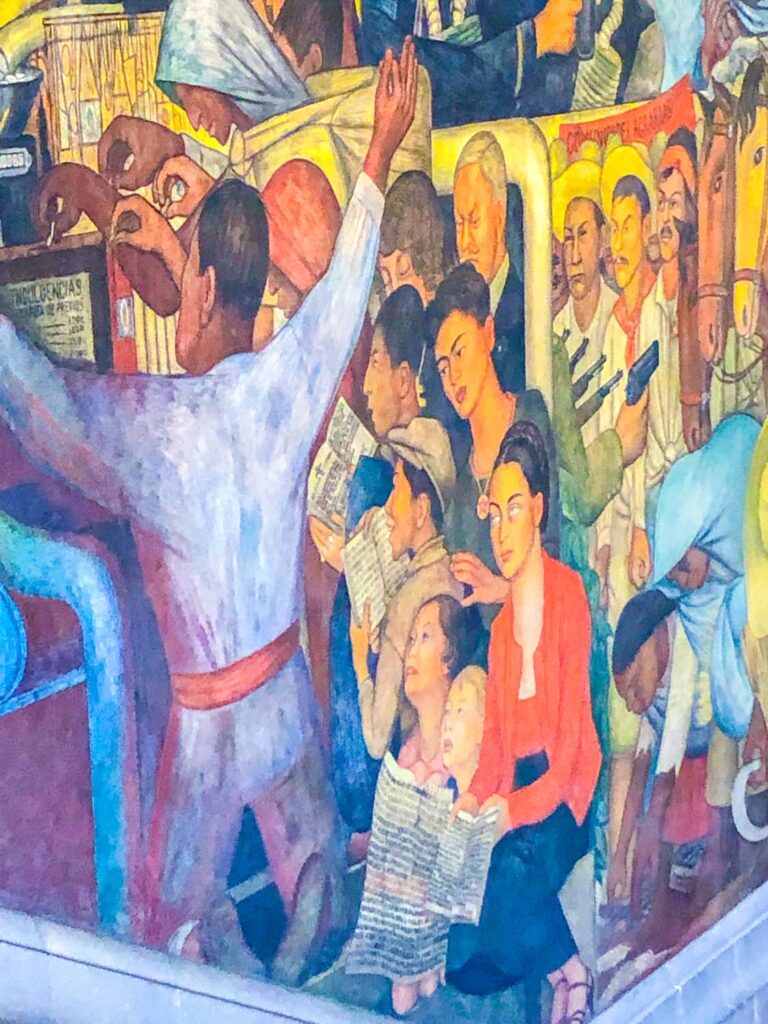
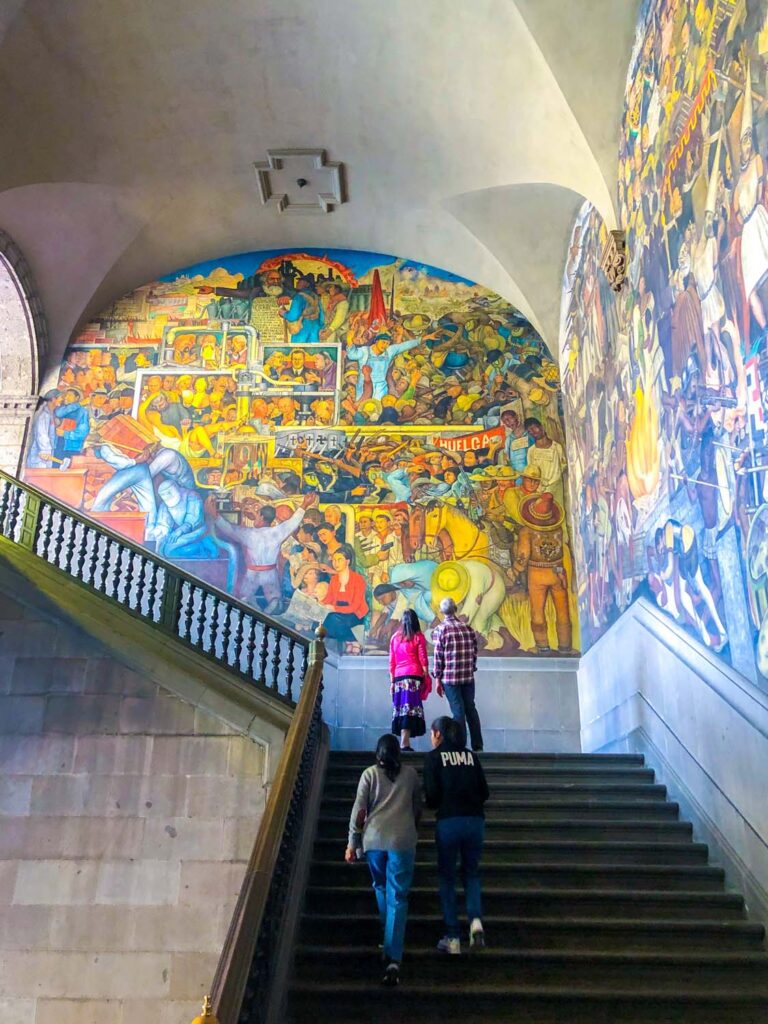
Second Level
On the second level of the courtyard patio are 11 additional murals painted by Rivera. These are continuations of the history but highlight particular scenes that Rivera found to be important during the pre-Hispanic era. These murals were not finished, and it’s interesting to see them as works in progress captured in time.
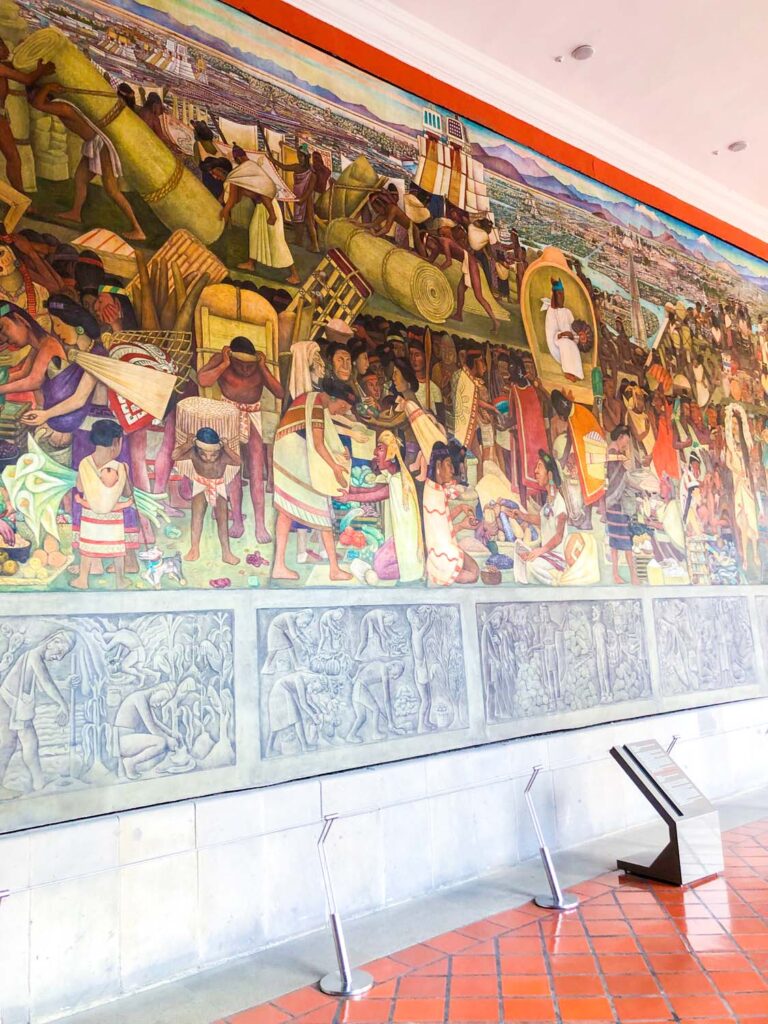
La Casa de las Sirenas
It’s time to go and grab something to eat to power us up for the rest of the day. Exit the National Palace the way you came and turn left along Moneda Street and then north up Seminario. This street leads right up to the entrance of historic Restaurante, La Casa de las Sirenas. If you look up this restaurant on Google, it will send you to the wrong address. Be sure to come directly to the building on República de Guatemala at #32. The best part of this restaurant is its incredible view of the Templo Mayor and the National Palace, as it sits in the shadow of the great Metropolitan Cathedral. If you can request reservations in advance, be sure to ask for a seat on the terrace as the view from there is unbeatable.
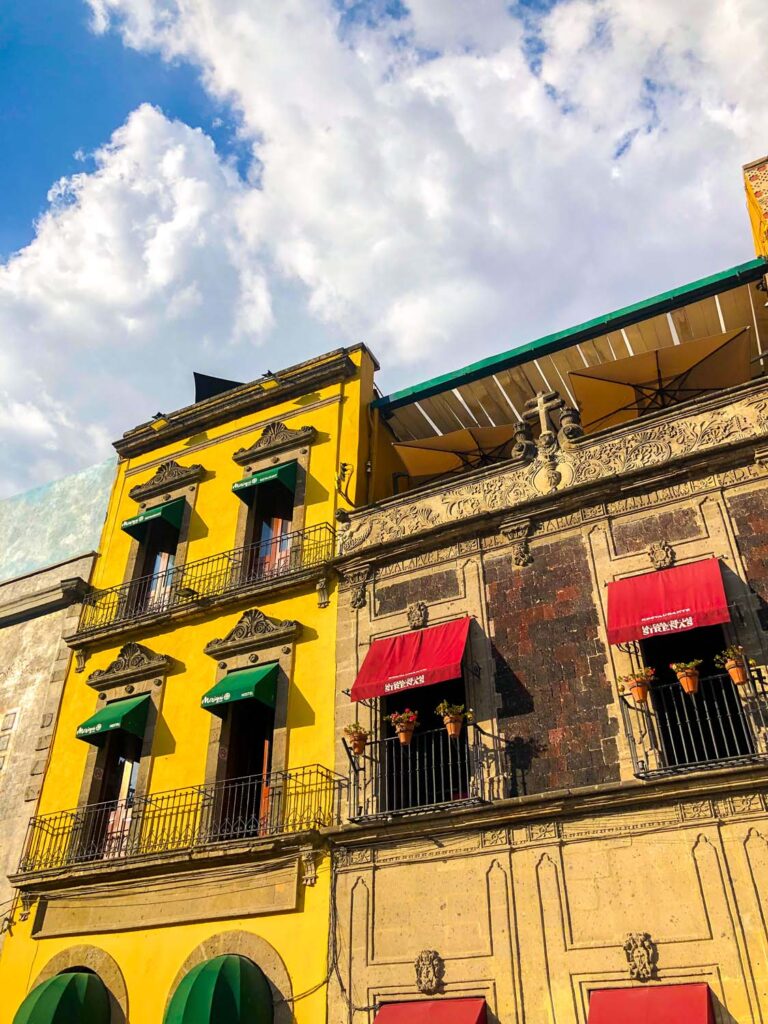
History of the Casa de las Sirenas
The other reason to eat here? Over 500 years of history steeped within the walls. The buildings along this street, initially named “Calzada a Tlacopan,” were some of the first lots handed out by Hernán Cortés to new Spanish landlords. The buildings were constructed using stones from the old Aztec pyramids, which were destroyed after the Spanish invasion. You can still see those dark-red volcanic stones embedded in the facade. On either side of the incredibly detailed frieze on the terrace are carvings of two mermaids. They sit proud, with their tails unfurled, giving the house the name “Casa de las Sirenas.” In 1994 the house was established as a restaurant and the owner and architect Nicolás Salas Villagómez went about restoring all the original details of the house.
The menu consists of traditional ingredients and classic recipes. That being said, it’s clear the menu is geared more towards tourists. The selection felt a little simplified, mostly like to suit a foreign palette. But nonetheless, it was all delicious! If you’ve never had traditional mole before, the one here is superb. But what you really come here for is the atmosphere, the good food is just a plus!
Taquería Tlaquepaque
If you’re looking for a cheaper alternative for lunch, make a quick detour over to Taquería Tlaquepaque. Taquería Tlaquepaque is your best budget option. This street taco establishment serves up plenty of options. But the very best one, in my opinion, is the tacos Al Pastor served with onions and pineapples atop a pile of roasted pork. Such a perfect sweet and salty combination.
Templo Mayor Museum
Directly across from the restaurant are the remains of the ancient Templo Mayor. Over the years, after many successful excavations and archeological digs, much of this historic site has been uncovered. It is now able to be viewed once more by the public inside the Templo Mayor Museum. The museum is definitely worth visiting as it displays some of the most significant treasures and relics of the great Aztec people. I would advise returning here on another day as a proper walk-through takes about 2-4 hours to explore. For our tour, the most exciting details of the ruins can be viewed from the street without going inside.
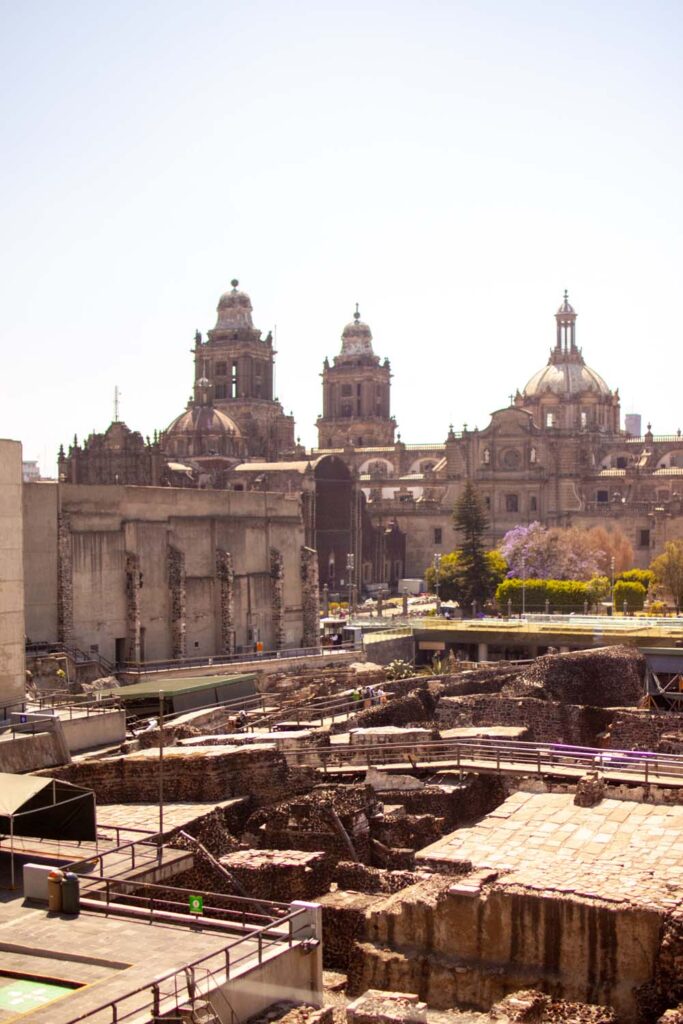
History of the Temple
The entire modern metropolis of Mexico City was built atop the ruins of the ancient Aztec city of Tenochtitlan. In the center of Tenochtitlan was the Templo Mayor, the city’s primary temple complex. The temple’s original name, in the native Nahuatl language, was Huēyi Teōcalli. According to legend, the temple was located where the god Huitzilopochtli gave the Mexican people the sign that they had reached the promised land. This sign was that iconic image of an eagle on a cactus with a snake in its mouth.
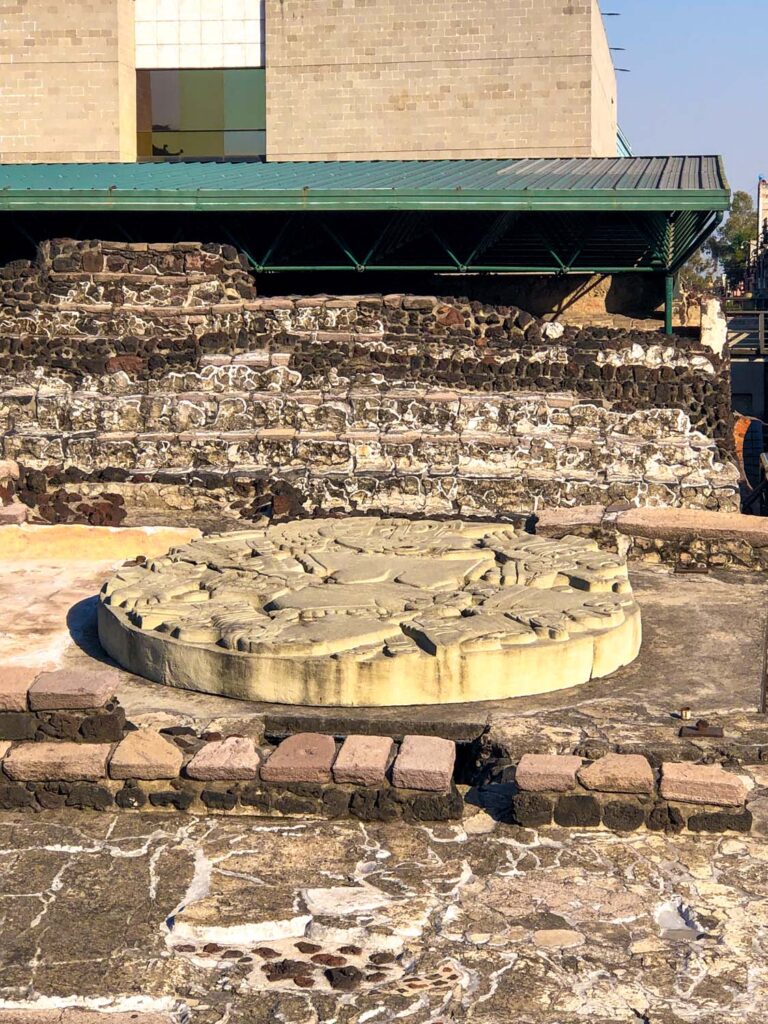
This great pyramidal temple was first built in 1325. Unlike Egyptian pyramids, which were primarily large tombs meant only for the Pharaohs, these pyramids were a big part of the life of the city. They were composed of four slopped terraces with secret passages inside. On the top of the pyramid was a flat platform where two temples were located. These were dedicated to Huitzilopochtli, god of war, and Tlaloc, god of rain and agriculture.
Inside the temple were the large idols of each god. They were made of amaranth seeds which was a traditional sculptural material in the pre-hispanic era. The seeds were stuck together with honey and even human blood to form the shape of the god. The blood was always given by willing human sacrifices as they wanted to donate a part of themselves to the god. These human sacrifices shocked Cortés when he first visited Tecnochiland. It was one of the events which added to his disdain of their beliefs and led him to think they were a “savage” culture.
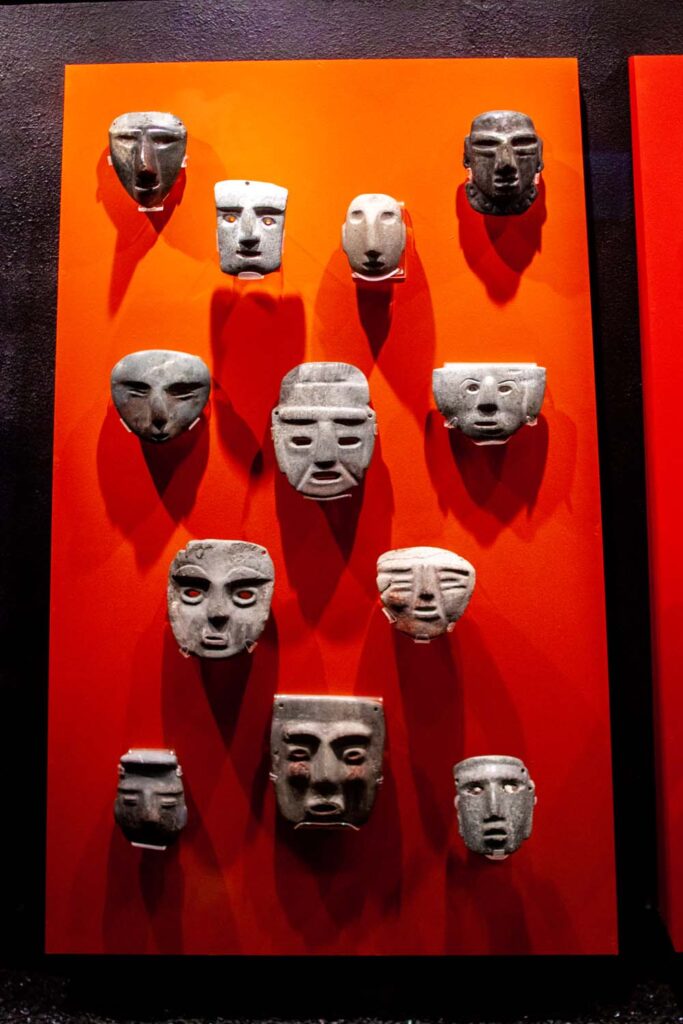
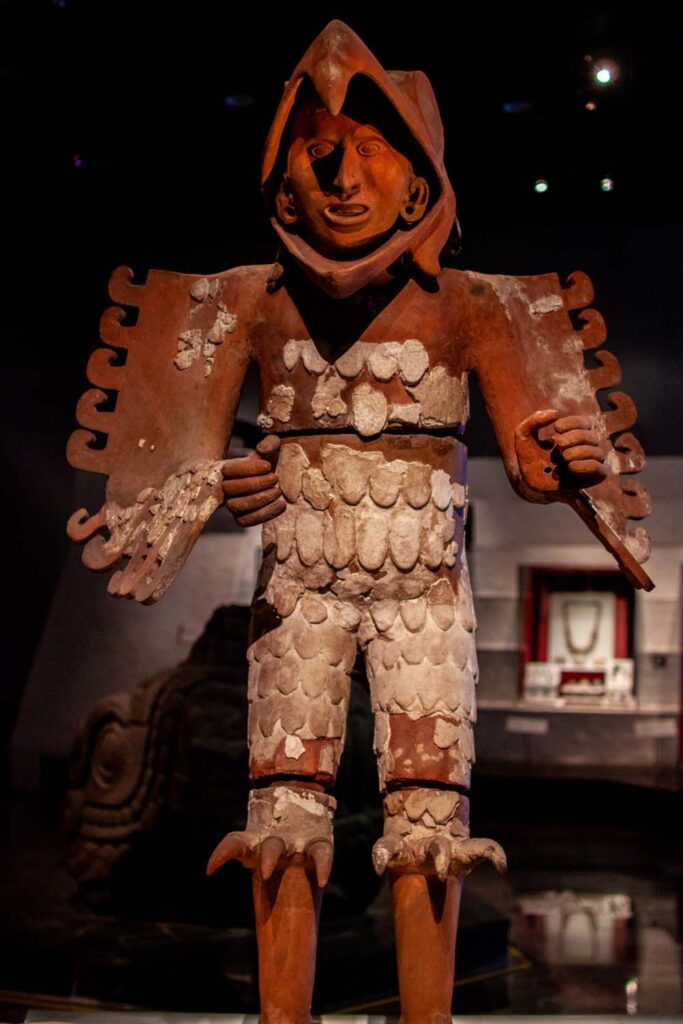

The Discovery of the Temple
In 1521, after the invasion of the Spanish, the temple and the rest of the Aztec buildings were destroyed. The Spanish used the site as a spot for their new Cathedral. Hundreds of years past and many people completely forgot about it until it was nothing more than legend. But in 1978, when an electric company was undertaking some excavation work in the area, they discovered these incredible ruins underground. Back then, 19th-century colonial buildings covered the plot of land under which the ruins were hiding. The government of the time thankfully saw the importance of the archaeological site to be of far greater significance than the colonial buildings. They were demolished, and a massive undertaking began, working to uncover the ruins and preserving the treasure found within.
The parts of the temple we can see today are elements of the base of the pyramid and the slope upon which the rest of the pyramid would have travelled. Large sculptures of the gods jut out from the base of the temple. Still to this day, even after being buried underground, you can make out the bright colours that they were painted with when they were first created. These Aztec towns were a rainbow-hued metropolis and a sight to see to be sure.
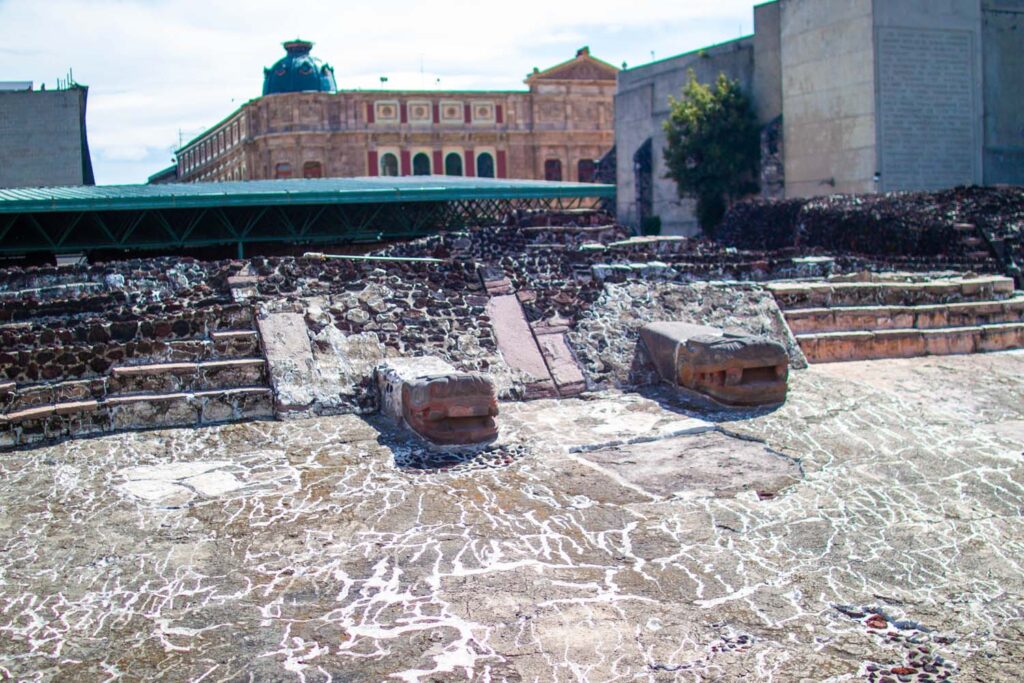

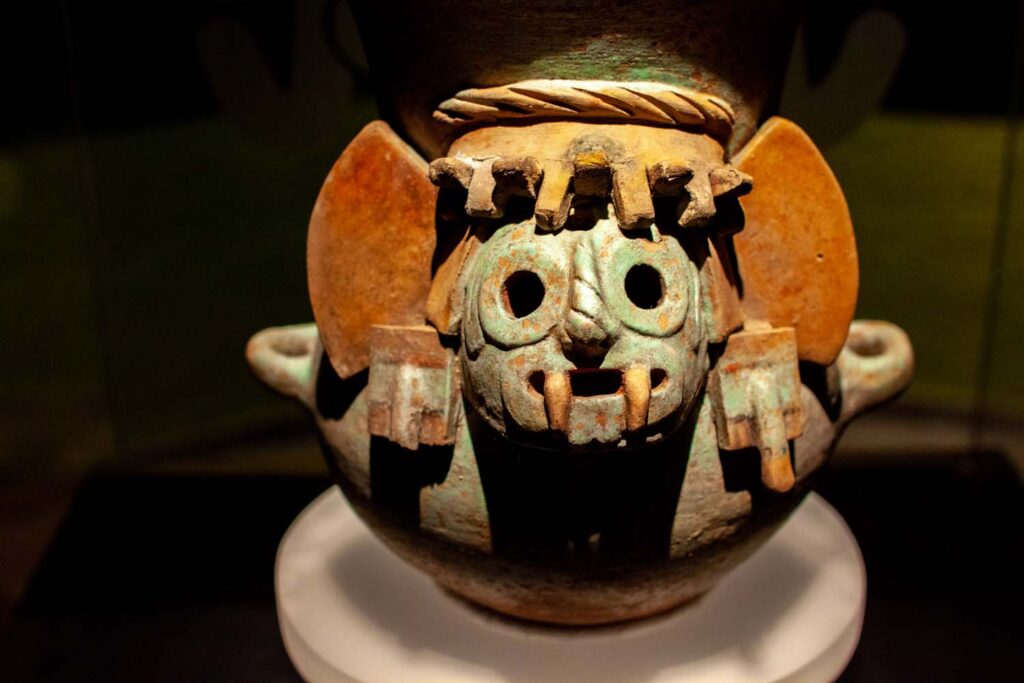
Mexico City Cathedral Metropolitan
The crowning glory of the Historic Center of Mexico City is the enormous Cathedral of the Assumption of the Most Blessed Virgin Mary into Heavens. The stone monument dominates the border of the huge Plaza del Zócalo. While its full name is “Cathedral of the Assumption of the Most Blessed Virgin Mary into Heavens,” it also goes by the much shorter nickname “Metropolitan Cathedral” or “Mexico City Cathedral.” The enormous church has stood here for over 400 years, being constructed from the literal bones (or stones) of the Templo Mayor.

The towering ornate church is considered one of the masterpieces of Mexican architecture and is Latin America’s largest and oldest cathedral. If you’re visiting Mexico City, you absolutely need to make a stop inside! Explore the interiors and wonder at the amazing monuments, chapels, architecture and incredible atmosphere found inside the Mexico City Cathedral. I have an entire guided tour of the Cathedral to help you better understand all the different aspects of its history and architecture. It’s pretty in-depth since I truly think it is one of the most spectacular places to visit. But if churches aren’t your thing (which I totally get), you can just poke your head inside and head back out to the Zocalo.
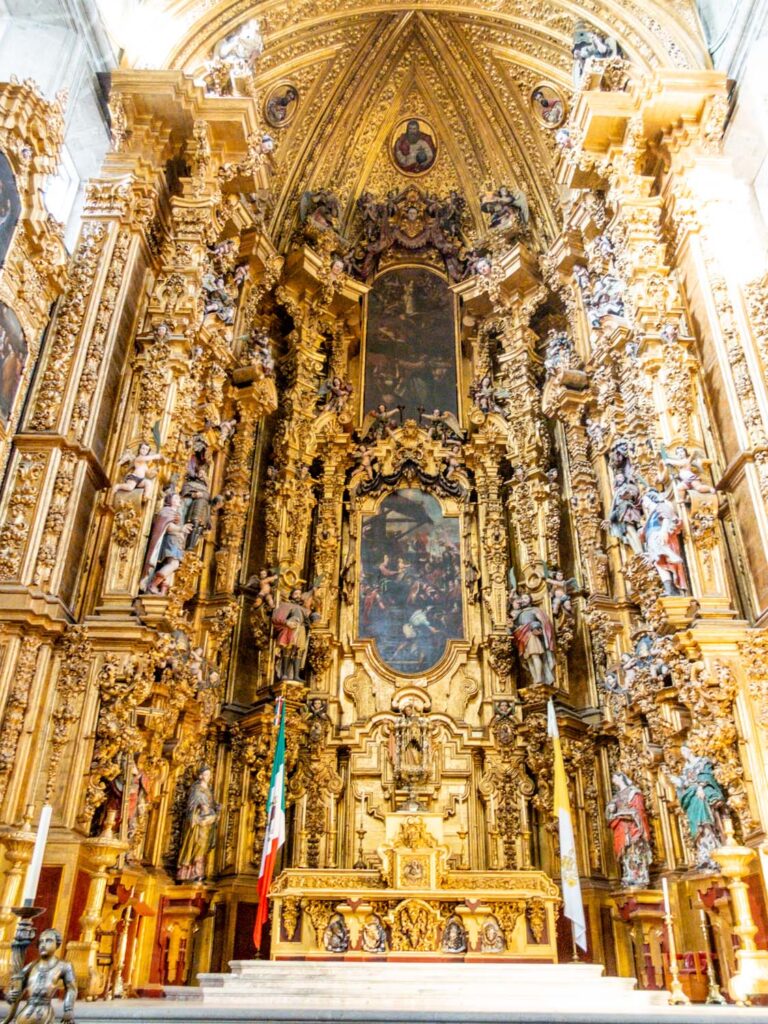
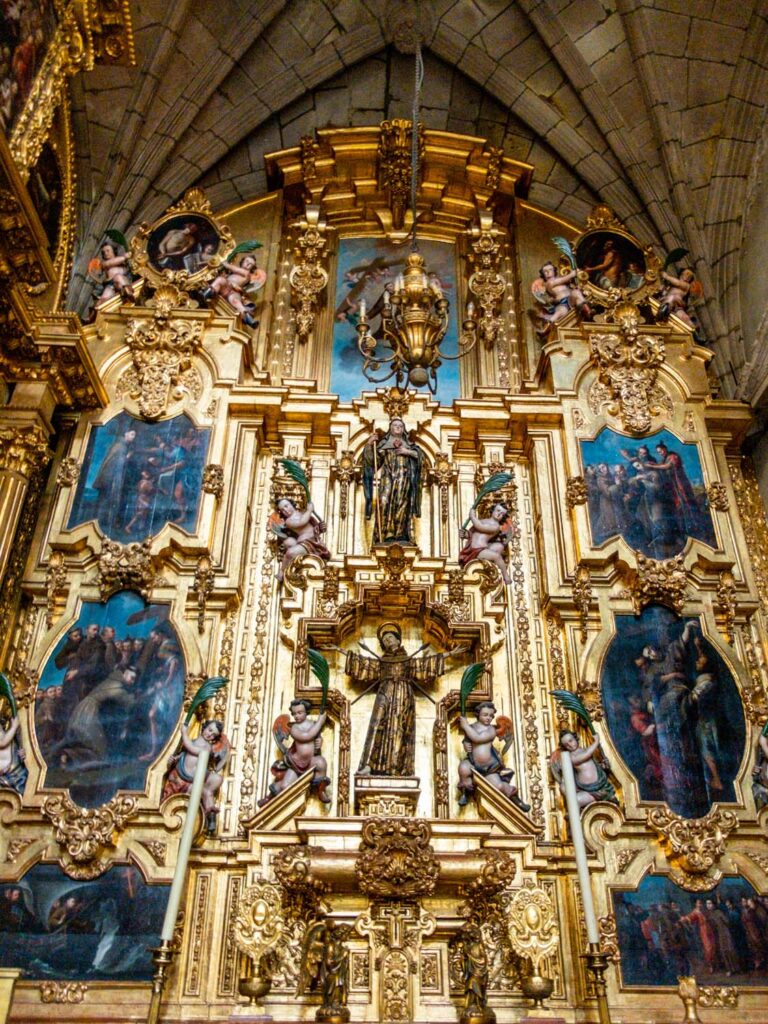
Zócalo
Across the Cathedral is the huge public square, called the Zócalo or Plaza de la Constitución. Every great city has got to have their triumphant main square. Whether it’s St Mark’s in Venice or the Red Square in Russia, you need to have a large central meeting place for your citizens and annual celebrations. The word “Zócalo” means “plinth” or “base.” When the square was first built, there was plans for a large monument to be installed in the center. But only the plinth was ever built. So it began to go by that nickname. The nickname Zocalo caught on for all future public squares around Mexico despite them having no connection to an actual plinth on site.
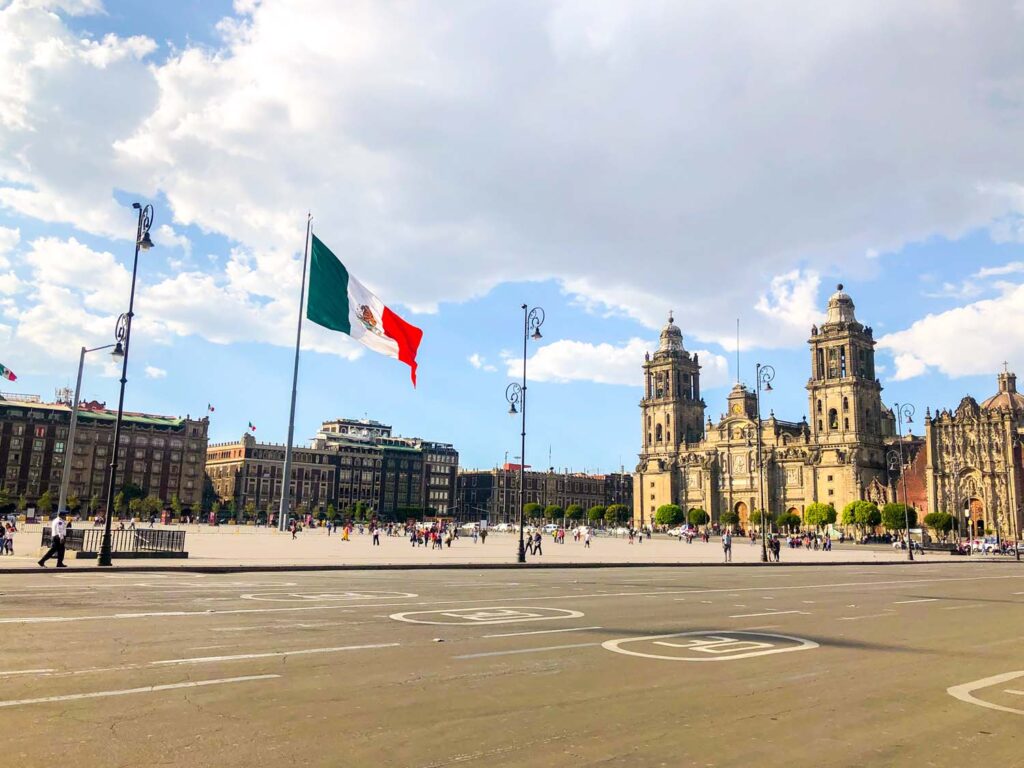
The Aztec Zocalo
Before the Spanish conquest, the square was used by the Aztec people just as they use it today. As an open space for the people. Back then it was surrounded by Moctezuma II’s Palace to the east and the great Templo Mayor to the north. It sat in the center of what was when the intersection of all the roads that met in the middle of Tenochtitlan.
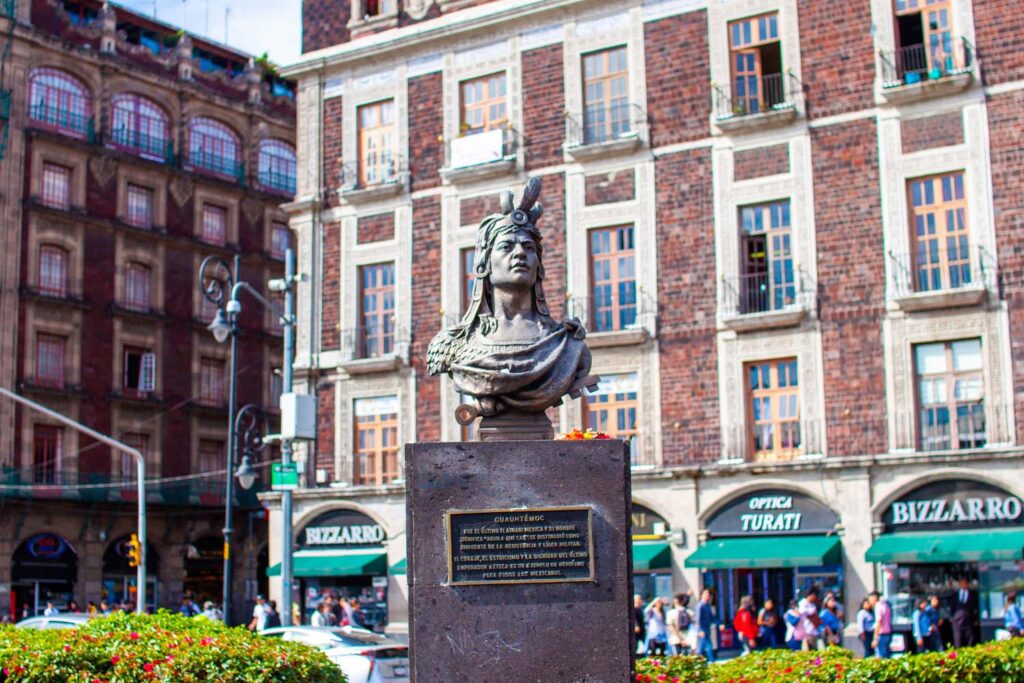
The Spanish Zocalo
Shortly after the invasion in 1521, the Spanish immediately went about transforming the area around the square. But for the most part, they left the Zocalo much unchanged as open-air squares were already famous in Europe and a necessity for big cities. Over the years, market stalls began to pop up around the square. Although I think the idea of a colossal square bustling with vendors sounds exciting, historian Francisco Sedano thought the spectacle was ugly and unsightly. He claimed it was, “very difficult to walk around here at the time because of its uneven pavement, mud in the rainy season, aggressive street dogs, mounds of trash and human excrement tossed among the corn husks and other discarded wrappings.“
Insisting the “unsightly” local vendors should be removed, the government installed a “Parián” in the southwest part of the square. The Parián was a small, stone warehouse where international products, brought in through trade, were sold. This new warehouse meant that local produce and crafts were pushed by the wayside in exchange for foreign products that outweighed the importance of the indigenous Mexican economy. During the Mexican Wars of Independence, the Parián was seen as another symbol of the colonizers. It was target #1 and destroyed during a large riot in 1828.
Celebrations, Rallies and Riots
As the square sits right in front of local government building, it is a popular spot for protests and rallies. But it is equally a place for expression and celebration. Festival de México is an annual event with programs dedicated to Mexican art held in the Zócalo. During the Day of the Dead celebrations, this square becomes filled with orange decorations, colourful floats, music stages, and more!
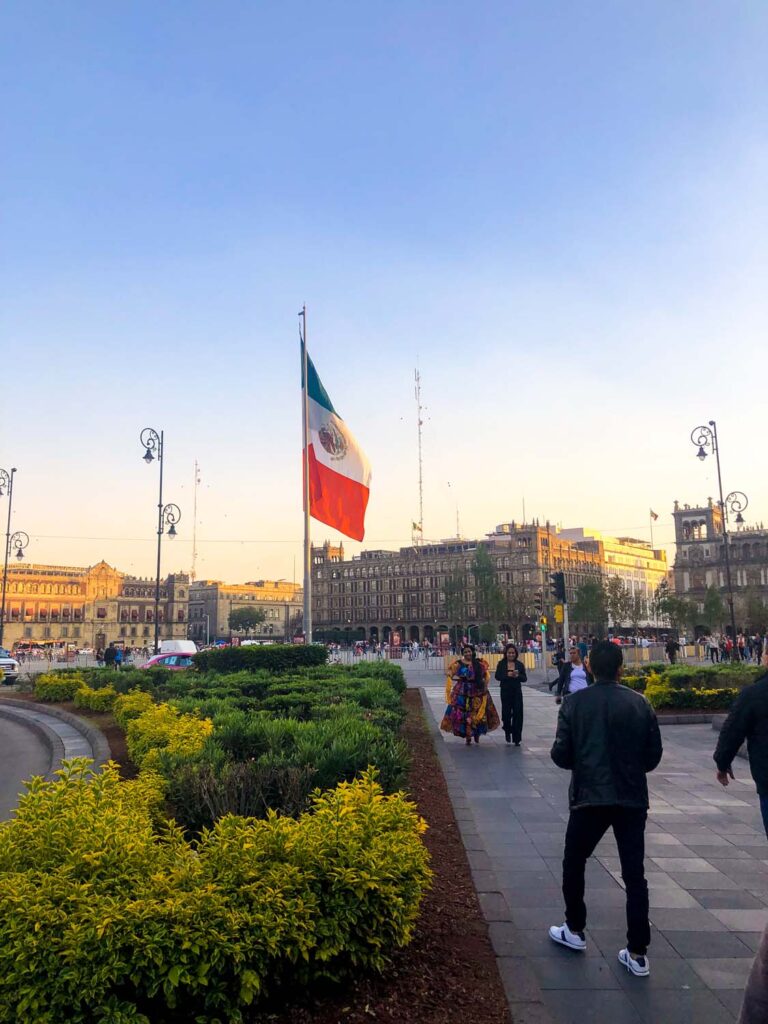
Grito de Dolores
Walk over to the east side of the square to look up at the facade of the Palacio National, which flanks this side of the square. It is here, every year on September 16th, better known as Independence Day, that celebrations start in Mexico City begin. Since 1821, the President of Mexico will walk out onto the balcony on the National Palace facing the square filled with crowds of people.
Once outside, he will ring the bell, which hangs in a small niche above the doorway. This bell once marked the first call to arms during the Mexican War for Independence and it still serves as a call to the people today. The president will then shout out to the people in the square, “Viva Mexico!” A cry echoed throughout the jam-packed Zocalo. This is called the “Grito de Dolores” or”the Cry of Dolores”. While it was once a rallying cry for the end of Spanish rule, today it is a cry for racial equality and the redistribution of indigenous land
The niche above the bell is topped by a great carving of the Mexican Coat of arms. The niche is flanked on either side by images of an Aztec eagle knight and his Spanish counterpart. Symbols of the ruling dynasties which once occupied the Palacio.
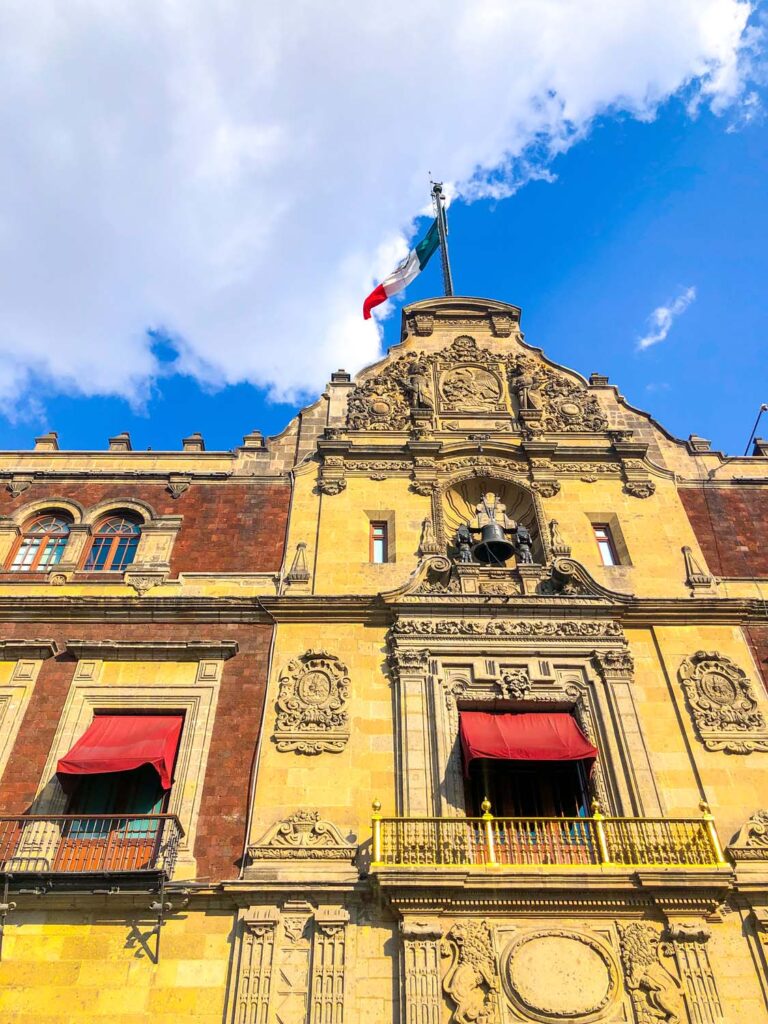
The Old Government Buildings
Looking south of the Zocalo, two identical buildings sit across facing the square. These are the official Government Administration buildings. The one on the right is the Old Town Hall (Palacio de Ayuntamiento) and one on the left is just called the Government Building (or Edificio De Gobierno). The Old Town Hall is much more bejewelled in its baroque architecture, while the Government Building is a simple, neoclassical design. While the Old Town Hall’s foundations dates back to the 16th century, the Government Building was a 20th-century invention. It was designed as a mirror image to the Old Town Hall, creating a wonderfully symmetrical appearance to that side of the square.
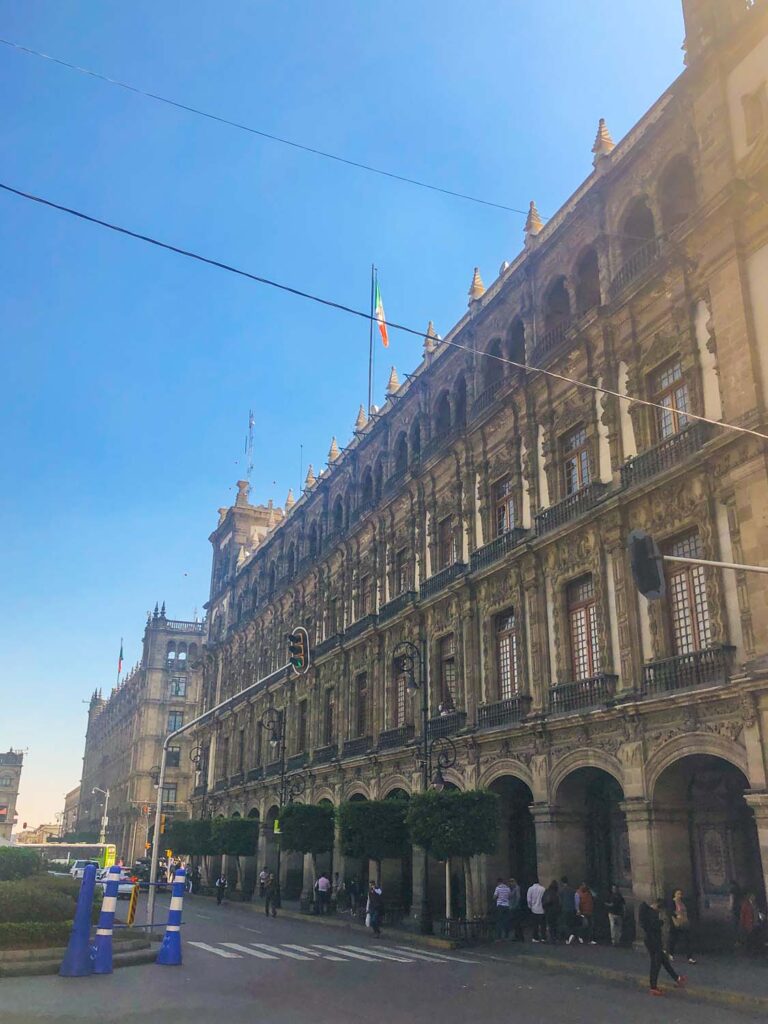

Palacio de Ayuntamiento
When Hernán Cortés took power in Mexico City, he wanted to immediately install a series of large governmental buildings surrounding the Zocalo. This was a sign of his dominance over the country. He also thought this would prevent indigenous people from building up around this central hub. The Old Town Hall would be located on the south side of the Zocalo. Construction was finished in 1527 under master architects Pedro de Arrieta and José Miguel Álvarez. But the first incarnation of the building was destroyed during the riots and fires of the 17th century uprising.
The new design we see today follows the baroque and neoclassical styles popular at the time. On the lower level, there is a series of wide arches for pedestrians to pass under. Floral carvings twirl around the architectural elements creating a highly textured facade. Walk under the arches of the Old Town Hall to admire the brightly coloured Talavera tile which wrap around the building. In the center of some of the tiles are painted murals depicting scenes of the founding of the city.
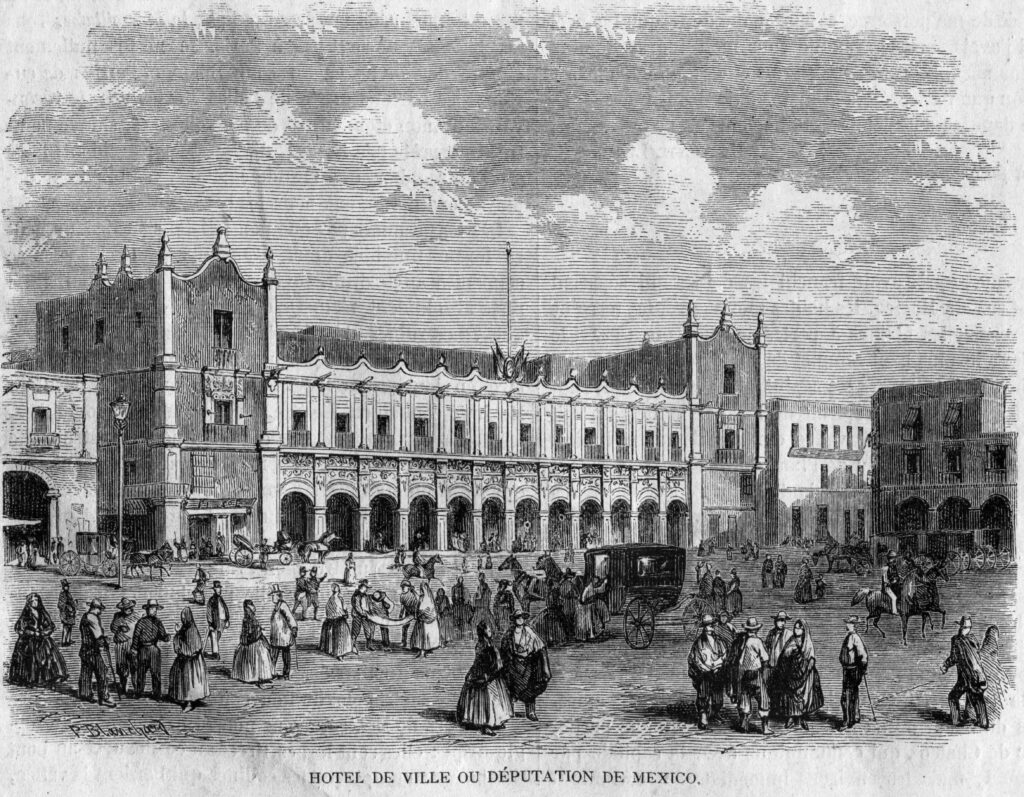
Edificio De Gobierno
The Edificio De Gobierno follows the same overall design, but the heavy ornamentation has been omitted. Instead, we see a more simplistic, neo-classical style. Both buildings have a series of Doric, Ionic and Corinthian columns repeating along each level. Many of these design choices can be seen in the surrounding buildings in the Zocalo. But this isn’t just a coincidence or even just a common thread. This uniform look of the square was a government-mandated directive implemented in the 19th century. The government hoped that by enforcing this neocolonial style of architecture, the square would have a more unified and cohesive appearance.
Old Portal de Mercaderes
Continue along under the archway under the government building towards the west until you reach the southwest parkette in the corner of the Zocalo. Across the street, facing the west side of the square is the Old Portal de Mercaderes or Old Merchant Portal. From the earliest days of the Zolcalo, vendors occupied the area selling food, silks, fruits, medicinal herbs, and other merchandise. These vendors rented the space from the landowner Don Rodrigo de Albornoz, the Count of Santiago, and secretary to King Carlos V.
Flooding throughout the years around the Zocalo meant much of the original buildings were destroyed. They were thereafter reconstructed in the mid 17th and 18th centuries by the Albornoz family. Despite modern reconstructions, the buildings continued to use the traditional red volcanic tezontle stones and cantera marble. This meant the building’s facade was still in keeping with the rest of the Zocalo’s buildings. The street-level arcade operates to this day as a famous shopping street. The area is better known as the Centro Joyero or the Jeweler Center as it has become a hub for the cities most popular goldsmiths.
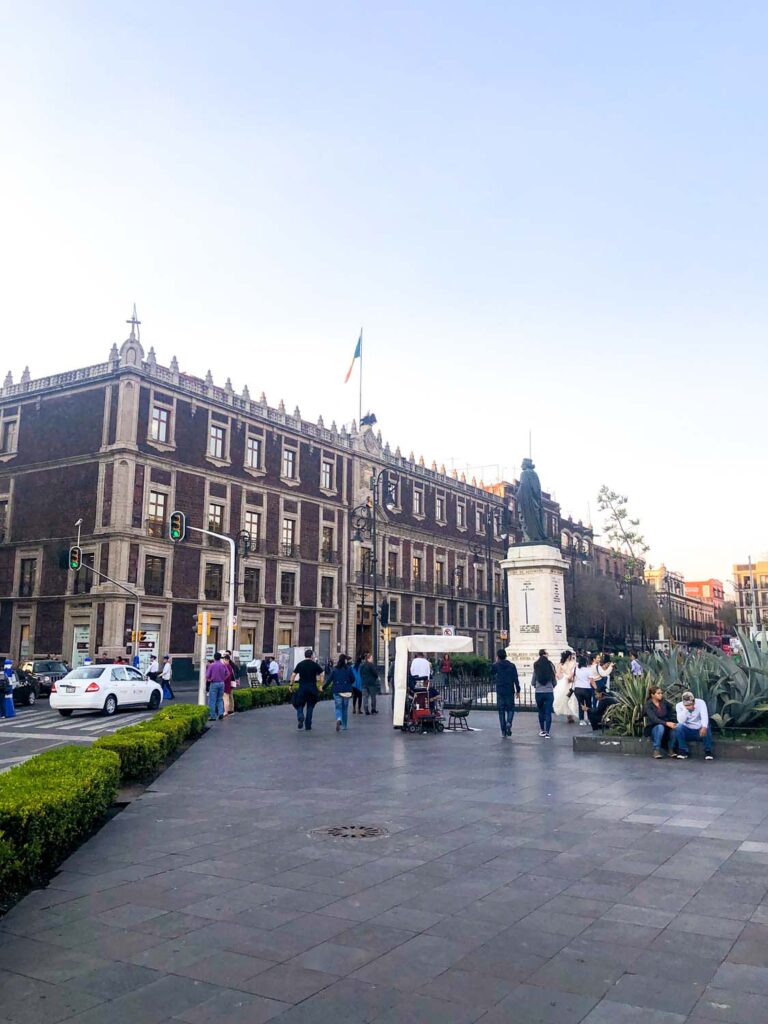
Gran Hotel Ciudad de México
Find your way to 16 de Septiembre Street and walk along, past a few shops, until you find the entrance to Gran Hotel Ciudad de México. Although I don’t generally recommend staying in the Historical Center (mainly because it feels more like staying inside the tourist hub), if you have your heart set on this area of town, THIS is the hotel you MUST choose. The rooms are pretty standard, but you get to stay in this gorgeous piece of history. If you get a room with a view out to the Zocalo, you can’t beat it for people-watching opportunities. The rates are shockingly affordable, so it’s well worth checking out.
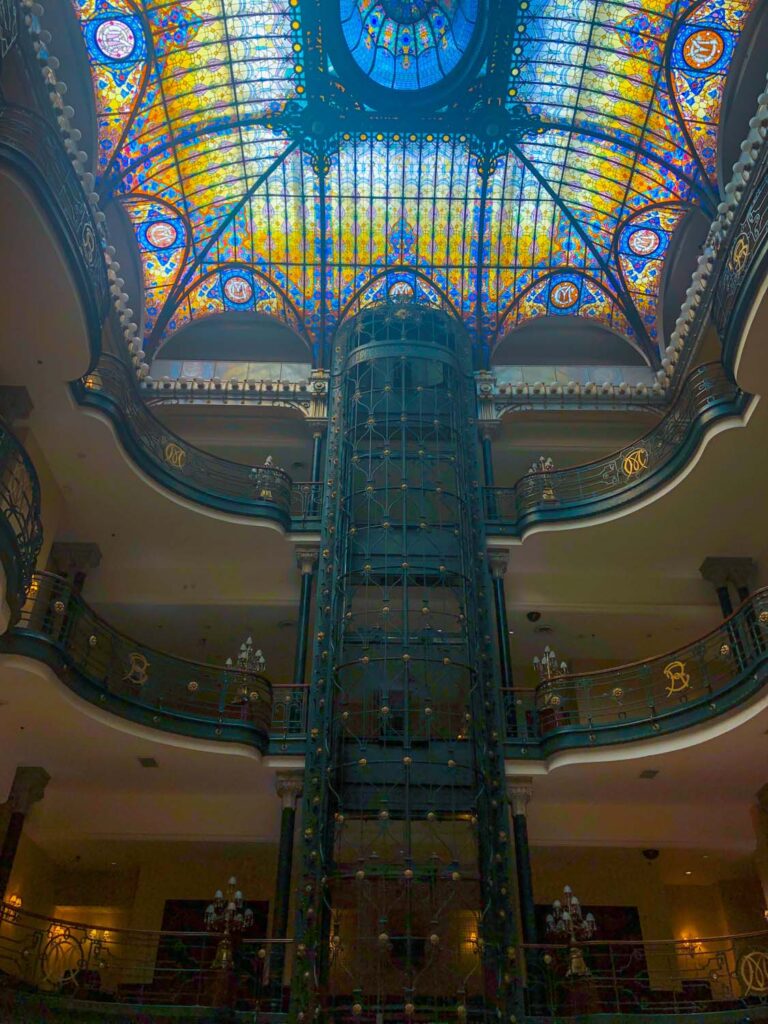
While the hotel is adjoined to the larger Old Portal de Mercaderes building, its facade is unique to its location along Septiembre street. The high neoclassical style was preserved along with their iconic green wrought-iron balconies. The origins of the building date back to 1526. Back then, the building was constructed as a residence for the Royal Accountant, Rodrigo de Albornoz. It passed hands a few times through the ages, and in 1895, it was purchased by Frenchman Sebastian Robert. Robert’s had the idea to modernized Mexico City’s shopping scene and built its first large-scale department store right here in 1899.
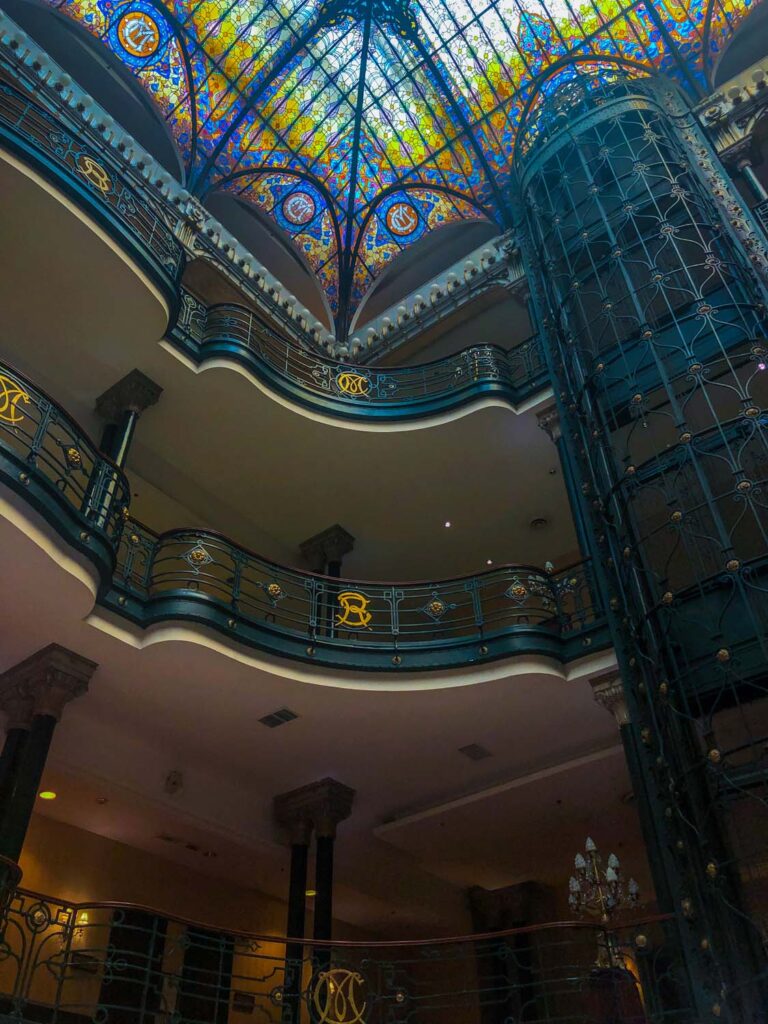

Centro Mercantil
In this modern department store, named the ‘Centro Mercantil,’ wealthy aristocrats could come and buy everything in one convenient location. Everything from luxurious fabrics, custom hats, expensive jewelry or imported perfumes. The European trend of “high tea” was also brought to Mexico City around this time. Visitors to the Centro Mercantil could enjoy this new trend right there in the opulent lobby cafe. The creme-de-la-cream of Mexico City would be seen walking through the doors, everyone from writers to composers, poets and of course, politicians. It was the who’s who of high society.
Back then, shopping malls weren’t the characterless places they are today. Back then, to draw in affluent customers, department store were lavishly decorated works of art. Robert’s designed the interior in the fashionable Art Nouveau style. Walking inside is like walking into a jewellery box. Hanging above your head as you walk up the stairs is the enormous Louis XV-style chandelier. Its crystals gently tinkling in the wind from the open doorways.
On either side of you, as you emerge from the staircase into the foyer, are two ornate gold canary cages decorated with brightly coloured flowers. But they aren’t just for display, they still hold canaries to this day. Standing in the center of the lobby is the cage-like elevator. This was the first panoramic elevator ever installed in Mexico.
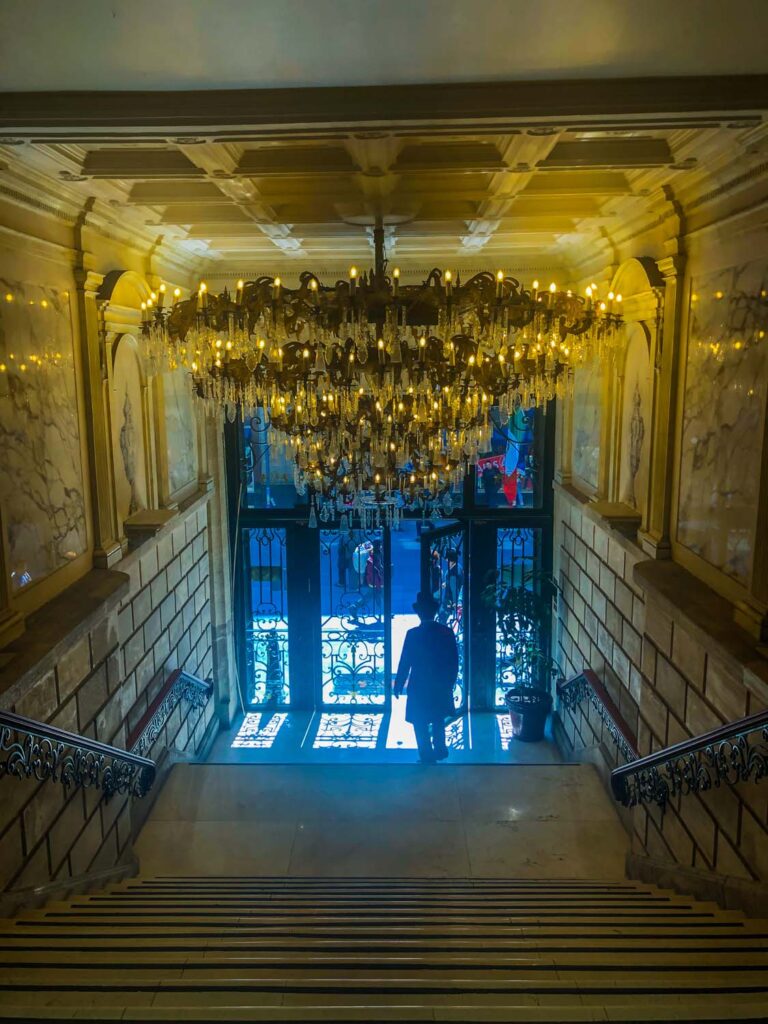

Tiffany Glass Dome
The room absolutely beams with light descending down from the incredible stained-glass dome towering above you. The ceiling was designed by French artisan Jacques Grüber using the illusive Tiffany glass. This is actually one of the four largest Tiffany glass pieces which remain anywhere in the world! Over 20,000 pieces of vibrantly tinted glass were made to create this masterpiece.
Interior
The beautiful wrought-iron railings on the first three floors swell around the lobby like a wave. The use of iron to create the room’s structure was called “Chicago style.” The Centro Mercantil was the first building in Latin American to use the technique. These undulating designs were a replica of the ones inside the famous Au Bon Marché department store in Paris. Au Bon Marché is now lost to time, so the fact we can still see a piece of it today, preserved in this architecture is a real treat. Along the railings, you’ll see the monogram “CM” and “SR” repeated. The “SR” stands for Sebastian Robert, the store owner and the “CM” of course stands for the “Centro Mercantil.”
Conversion to Hotel
The Centro Mercantil officially closed its doors in 1958. It wasn’t converted into a hotel until 1968. 1968 was one of the most famous eras in Mexico City’s modern history when the Summer Olympics came to the country. The Olympics meant thousands of new visitors to the city. To accommodate the crowds, more hotels needed to be built. These hotels were meant to create a positive impression on the international tourists. The city went about finding artful and iconic buildings that could be converted to wow the visiting athletes.
Avenue Francisco I. Madero
Exit the hotel and head along Calle de la Palma until you reach the pedestrian street Avenue Francisco I. Madero. While today the street is very touristy with many international chains dotting the shop fronts, there are still many historical buildings to see along the way. You just need to know where to look. The street is named after the great Francisco Ignacio Madero González. Madero was a Mexican revolutionary, writer, statesman and the 37th president of Mexico. Sadly, Madera was assassinated in 1913, only two years into his Presidency.
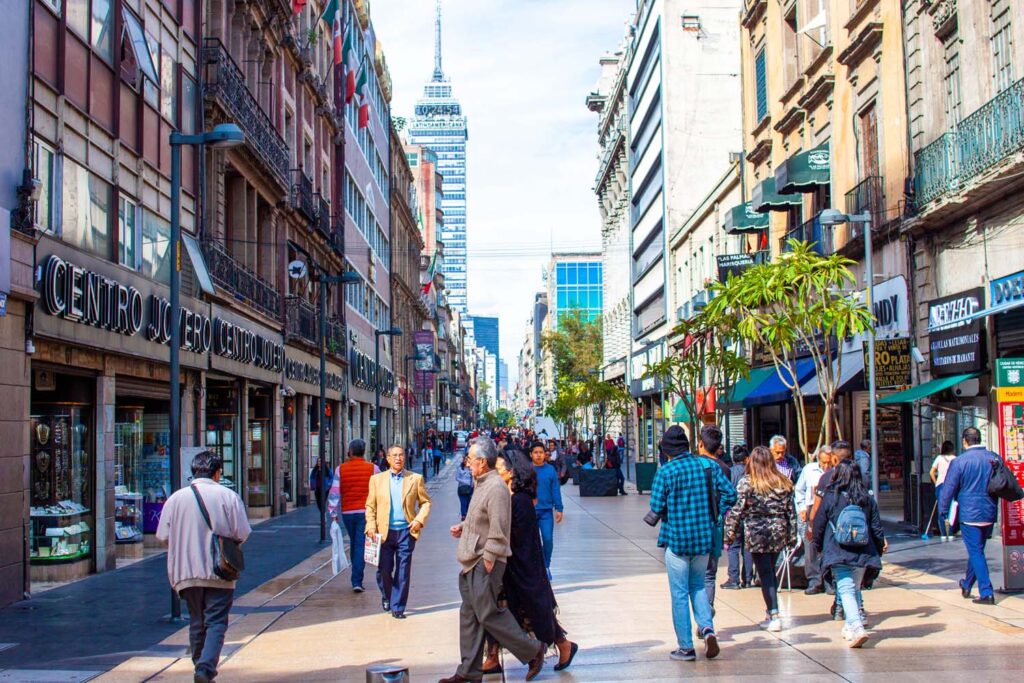
Templo de San Felipe Neri La Profesa
One block down the street, on your right, you’ll find the La Iglesia de la Casa Profesa or more commonly “La Profesa.” The church was the first Jesuit building in Mexico City, established in 1578. Sadly, much of the original design was demolished during the great flood of 1629. The current building is nonetheless impressive, dating back to 1714. Its architecture style marks the beginning of the ultra-baroque trend of the 18th century which exploded throughout Mexico City.
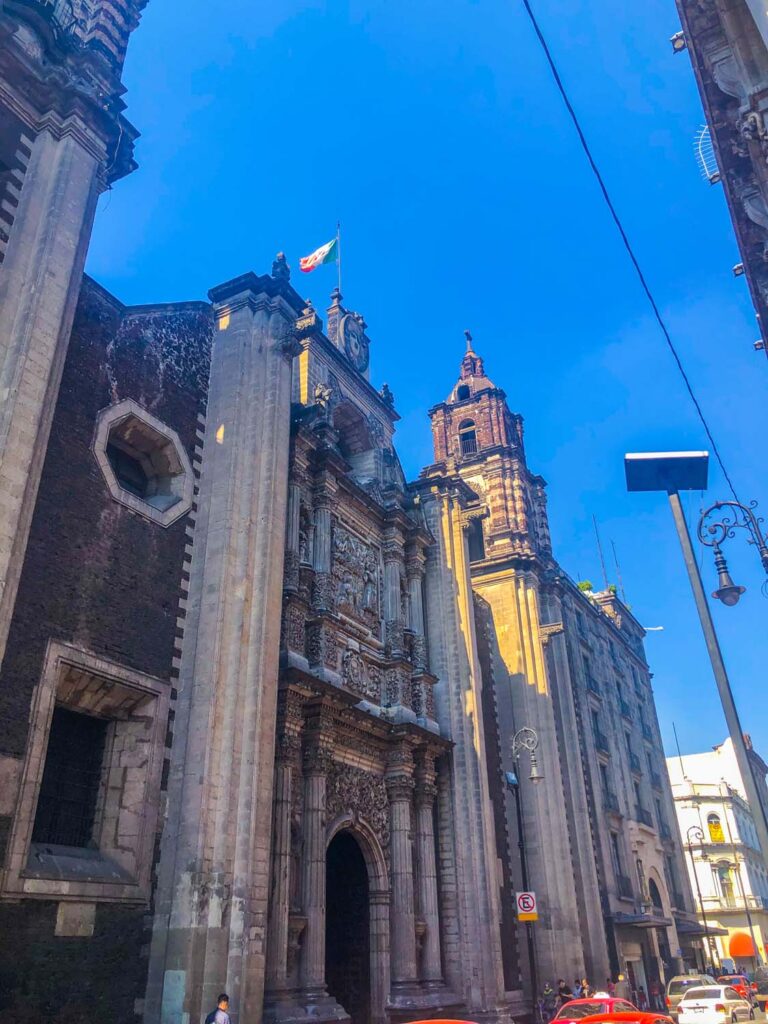
Art Collection
Stepping inside, take some time to admire the paintings on the walls. The church is home to one of the largest collections of colonial-era religious images. On display inside the church, see if you can find the painting of “The Virgin of the Pópulo” by Juan Correa, Baltasar de Echave Orio‘s depiction of “The Pentecost”, and best of all “the Crucifixion” by José Juárez above the altar. They have such an extensive collection of art that there is even an adjoining art gallery where the remainder of their collection is on view.
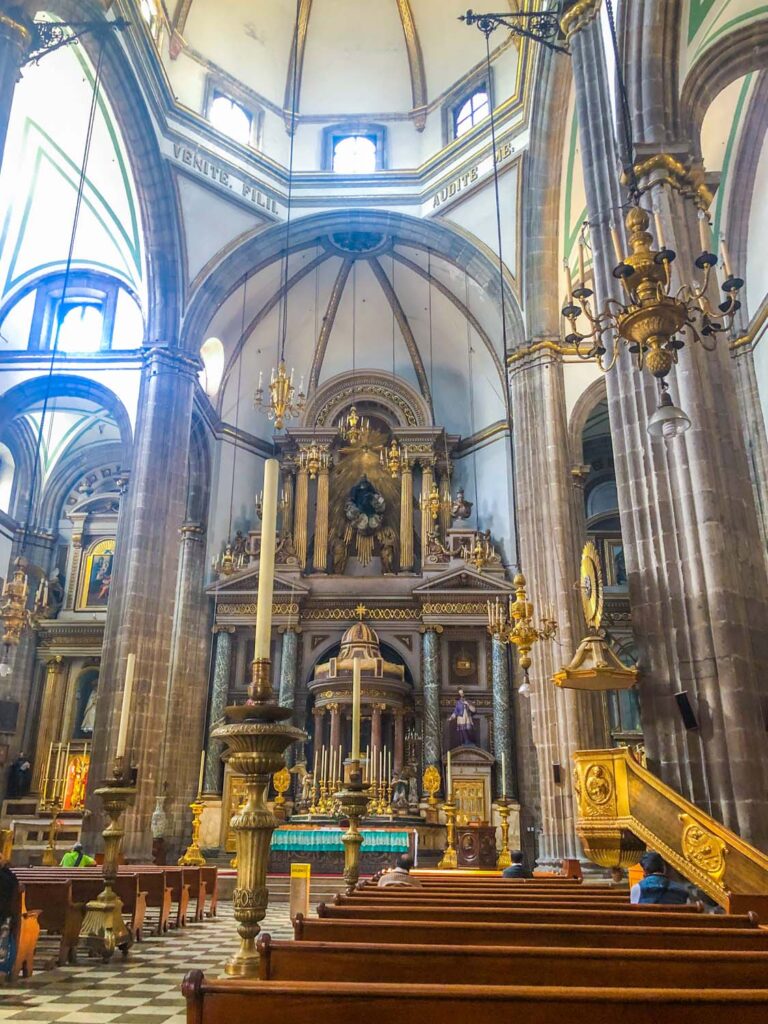


The Political Side of La Profesora
While a church might not seem like a place where political plots were cultivated, this church has served over the years as the location for many an uprising. During the Mexican War of Independence, “La Profesa Conspiracy” took shape inside these walls. Perhaps the church acted as a place of sanctuary where the rebels felt they would be safe from attack. It was here that those who opposed the republican government and supported Agustín de Iturbide met and discussed their plans to make him the emperor of Mexico. In recent years, it was here that the discussions around the beatification of Juan Diego also began.
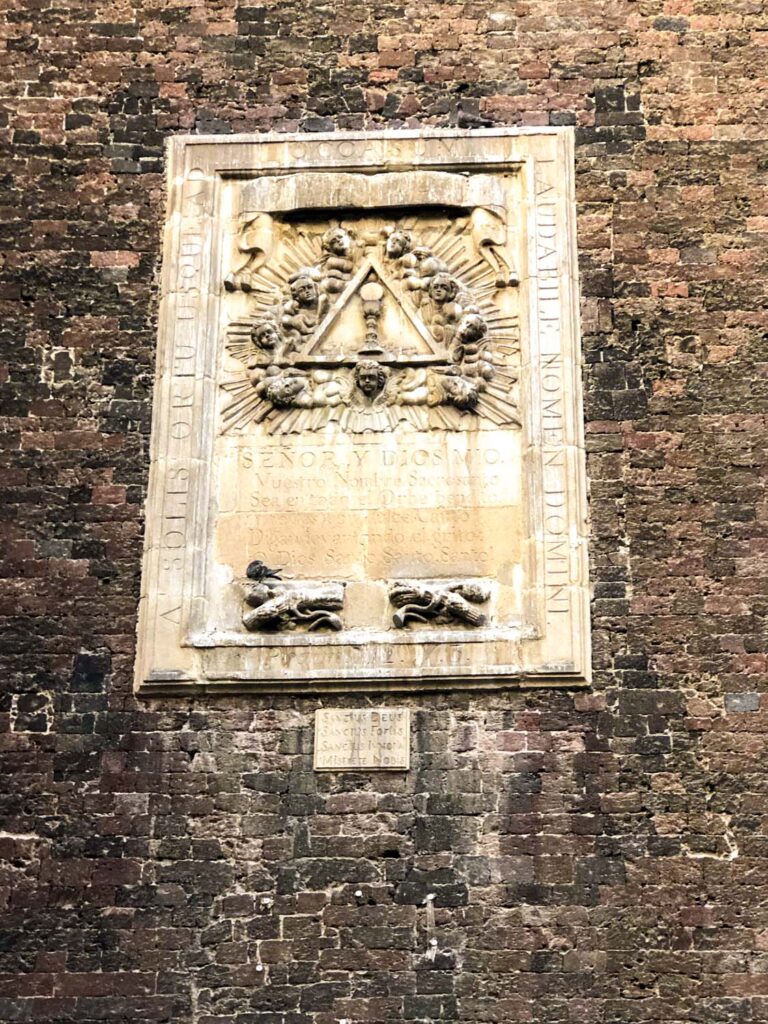

Dulcería de Celaya
Make a quick stop up the street at Dulcería de Celaya where you can grab yourself some delicious Mexican candies. Dulcería de Celaya is a tiny, old shop selling traditional Mexican candies and sweets since 1874. Walking into the shop, it feels like nothing has changed in over 100 years. When the family-run shop first started selling candy, it was made in a small, improvised factory using wooden shovels, copper saucepans and a minature oven. They could only produce so much per day, often only one tray of candy. But the sweets were so popular that they would sell out day after day. As the demand rose, they managed to expand their production to meet the needs of the city.
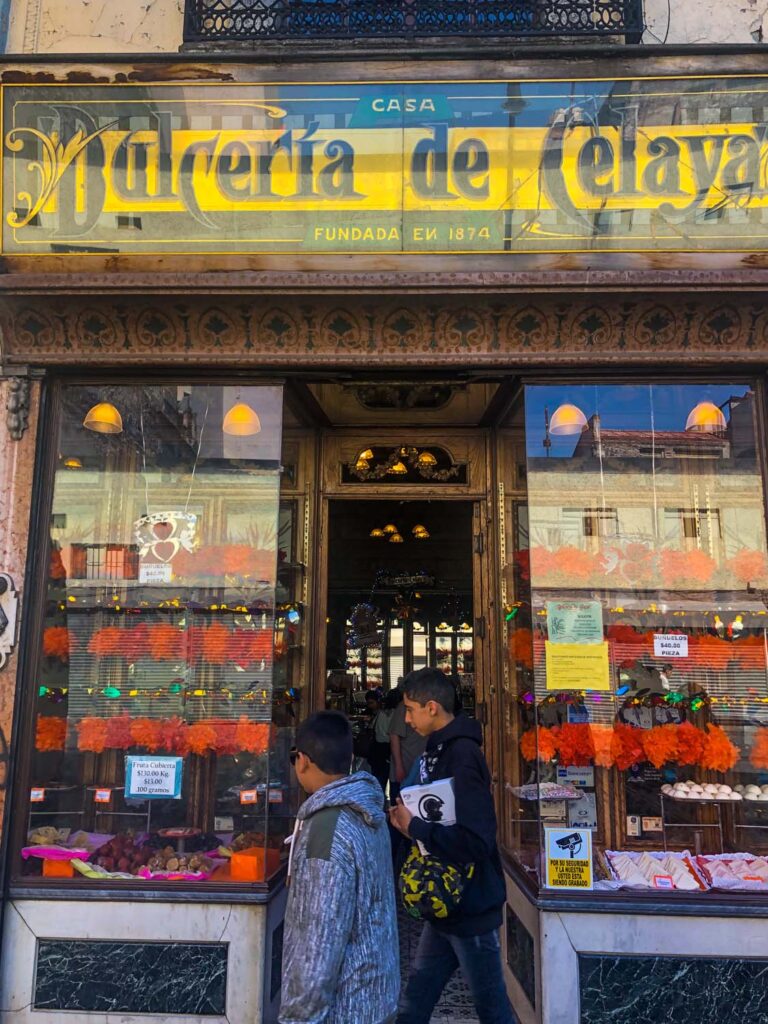
Even today, they produce candy in much the same way as it was made in the beginning, still out of that tiny kitchen. When you walk in the doors, the smell of fresh pineapples, strawberries, guavas and coconut fills the air. It’s intoxicating. The candy is very well priced, so even if you don’t’ recognize anything, just let the smells guide you and try whatever your eye is drawn to.
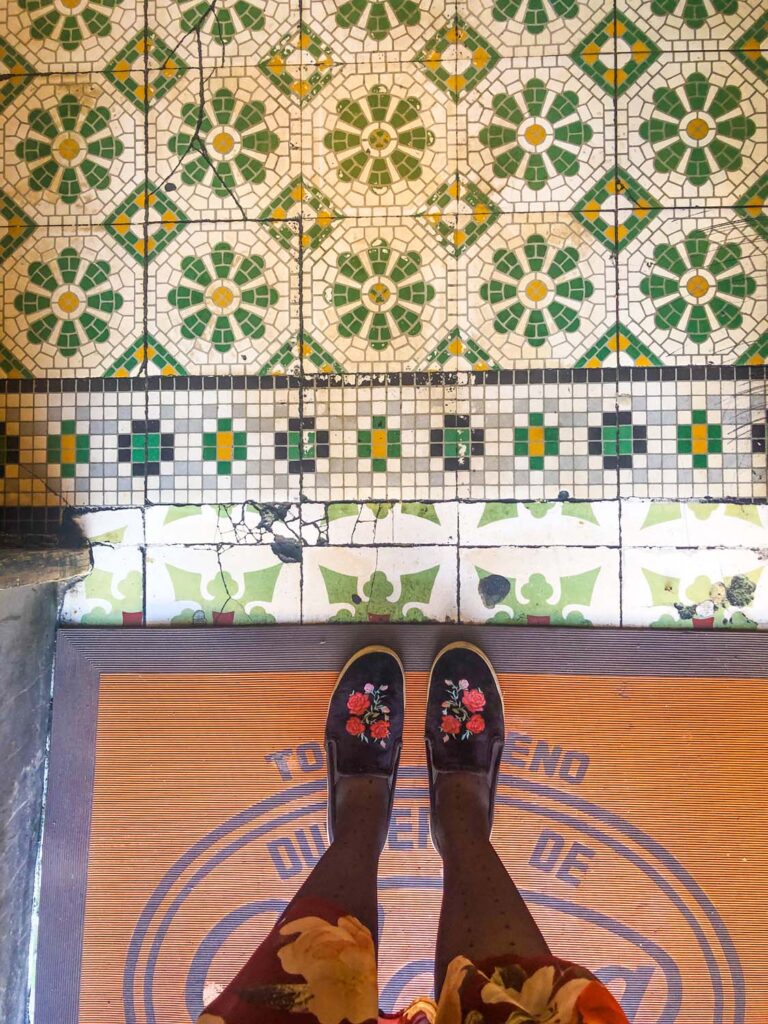
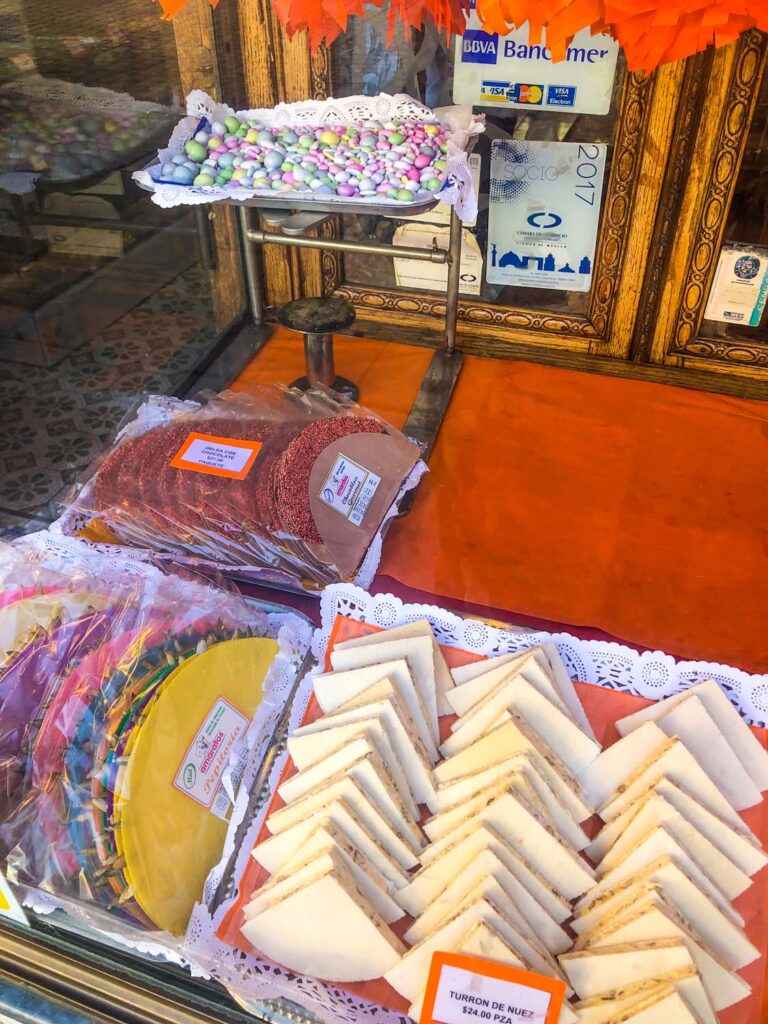
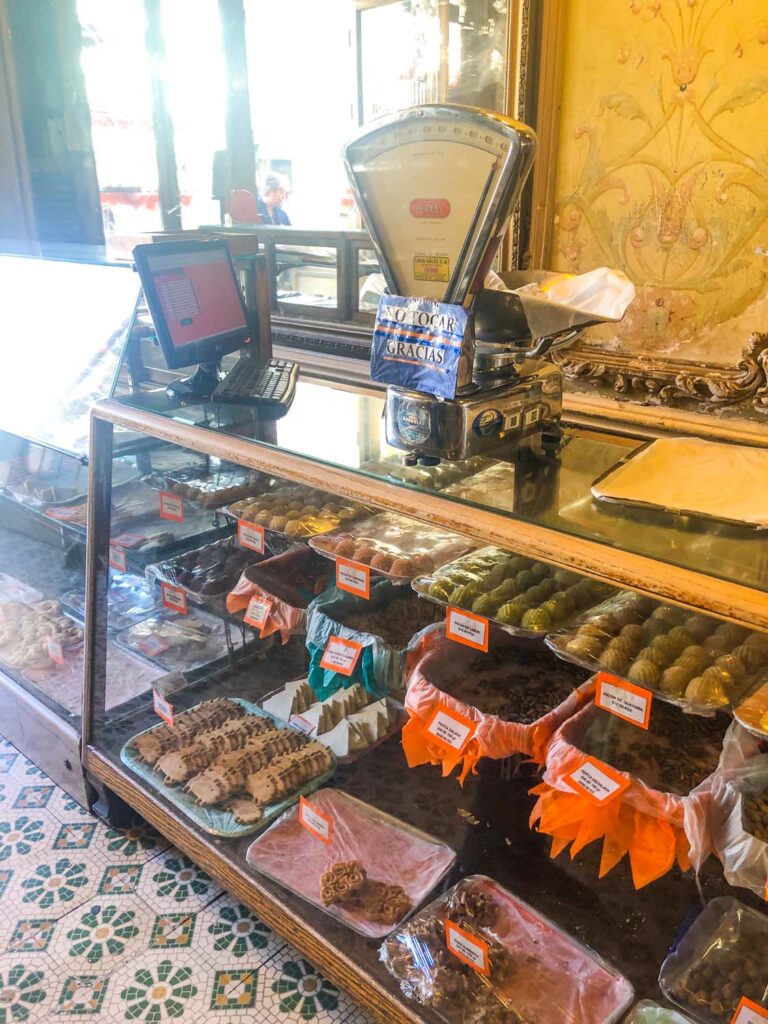
Palacio de Iturbide
Head back down to Madera street until you reach the Palacio de Iturbide, just before the Calle de Filomeno Mata. Surrounded on either side by modern buildings, this ancient structure really stands out. The Palace was built in 1779 as a wedding gift from Count of San Mateo Valparaíso to his daughter. Apparently, the Count was worried his daughter’s new husband was going to squander his daughter’s dowry. So instead, the Count built the house using the entirety of the dowry to ensure the new husband wouldn’t be able to lose it.
Agustín de Iturbide, the Mexican army general and politician, lived here during the Mexican War of Independence from Spain. And it was actually inside the Palace where he accepted the crown of the First Mexican Empire. Because of this seminal moment, the building earned the nickname the “Palace of Iturbide“. The building is made out of that iconically Mexican tezontle and cantera stone. The facade was designed in a high gothic style featuring organic and geometric motifs such as flowers, vines, leaves, and even a mermaid. On either side of the entrance are two graceful male figures that look almost as though they are holding up the balcony above.
Church of San Francisco
Further along the street, on your left, is the large stone archway and steps leading down into the Church of San Francisco. The Church of San Francisco or the Iglesia de San Francisco was the original headquarters of the Franciscan friars. When Cortez first came to Mexico City, this spot was where he found Moctezuma II’s royal zoo. After the colonization, the zoo destroyed and the land used to build the largest and most influential monasteries in Mexico City. Initially, the church and its monasteries spread out over 32,224 square meters! This would have taken up almost the entirety of the city block around the area.
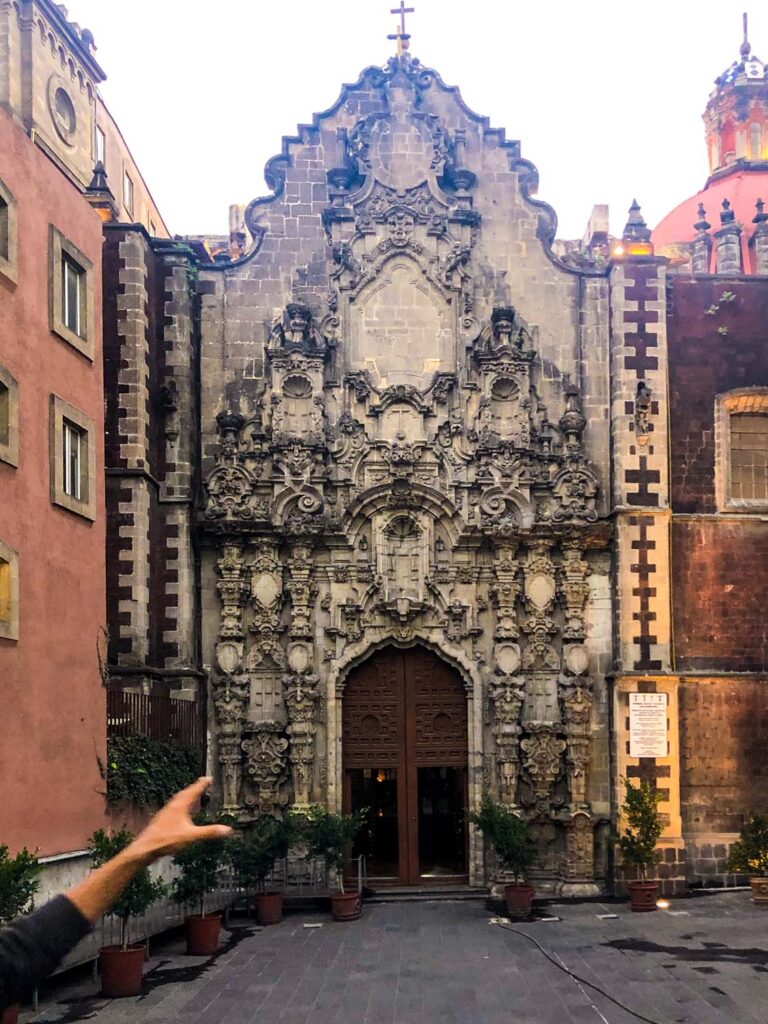
Balvanera Chapel
Today, the only remnant of the original complex is this small church built in 1710. The reason for the steps down into the church is because, like the rest of Mexico City, the building is sinking. You can’t even walk in through the original entrance as that has been walled up. Today, the direct access to the church is through the Balvanera side Chapel. The chapel’s facade was given a facelift by Lorenzo Rodríguez, who also designed the front for the Metropolitan Cathedral’s Tabernacle.
Walking inside, the most impressive feature of the chapel is the sizeable gilded altarpiece dedicated to the Virgin of Guadalupe. Her faded image is placed in the center of the golden altar. Walking up a few steps into the central part of the church, you are greeted by another great gilded altarpiece. A few of the little elements inside that I love are the stained glass windows with the red cross in the center. Although they aren’t highly sophisticated, I love the very stark imagery of that repetitive red cross illuminating the clerestory.
While the chapel walls are relatively plain, hung to decorate the large expanses of stone are these vast paintings. These paintings depict scenes from the life of San Francisco de Assísi, for whom the church and the Franciscan order are named. Each one of the paintings highlights one of Saint Francisco’s greatest virtues. See if you can spot them all.
Casa de Los Azulejos
Directly across from the church, you’ll immediately be drawn to the blue and white tiles of the Casa de Los Azulejos or The House of Tiles. Madero Street was once the most highly sought-after real estate in Mexico City. The original residence was built for the wealthy Count of the Valle de Orizaba in the 16th century.
But the now-iconic colourful tiles weren’t added until 1737. After the Count’s death, the Countess decided to return from her home in Puebla to the capital city. Wanting to feel at home, she brought a large amount of the famous Puebla Talavera tiles with her. Puebla tiles were each handmade, and the sheer number of tiles on the facade was a way of showing off the family’s immense wealth, even after the Count’s death. It was a means of showing that Countess was still a power player and didn’t need her husband to run the show.
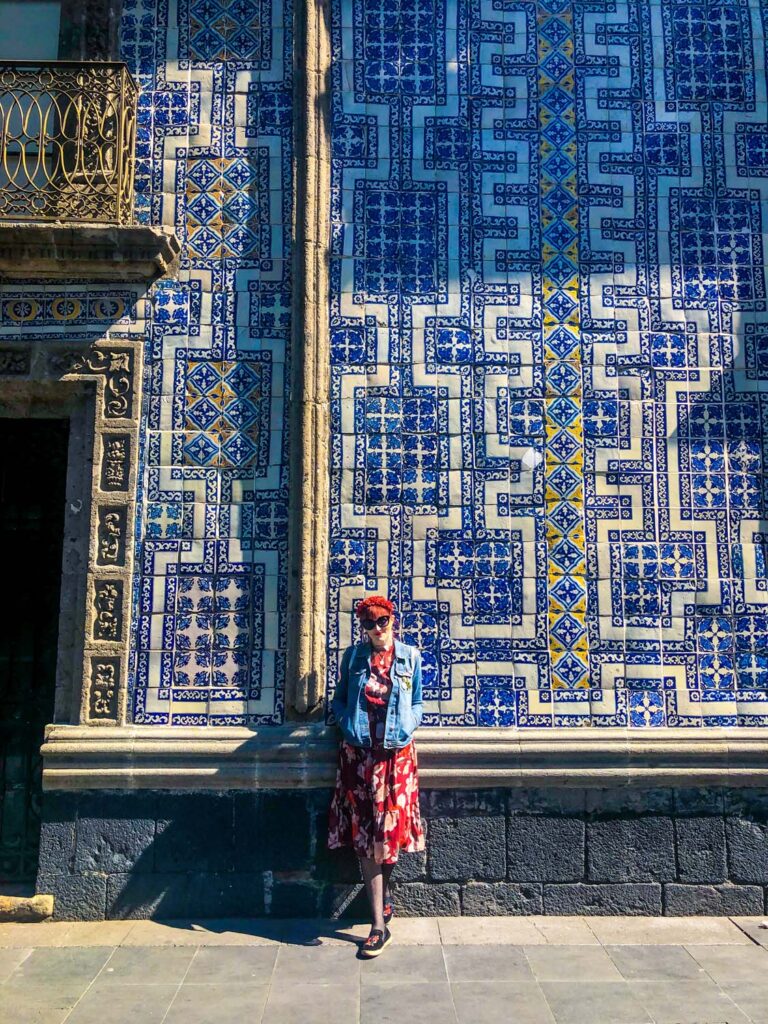
Talavera Tile
Talavera was a craft brought to Mexico by the Spanish. The Spanish established their workshop in Puebla in the 16th century. They chose Puebla as their industrial hub as it was an excellent location to nearby clay mines used to create the tiles. The colourful tiles were a popular feature inside monasteries and churches. Usually, only the most wealthy homes could afford to decorate their houses with them. While some Puebla tiles were painted with images of animals, birds and flowers, the most commons variety contained simple geometric patterns.
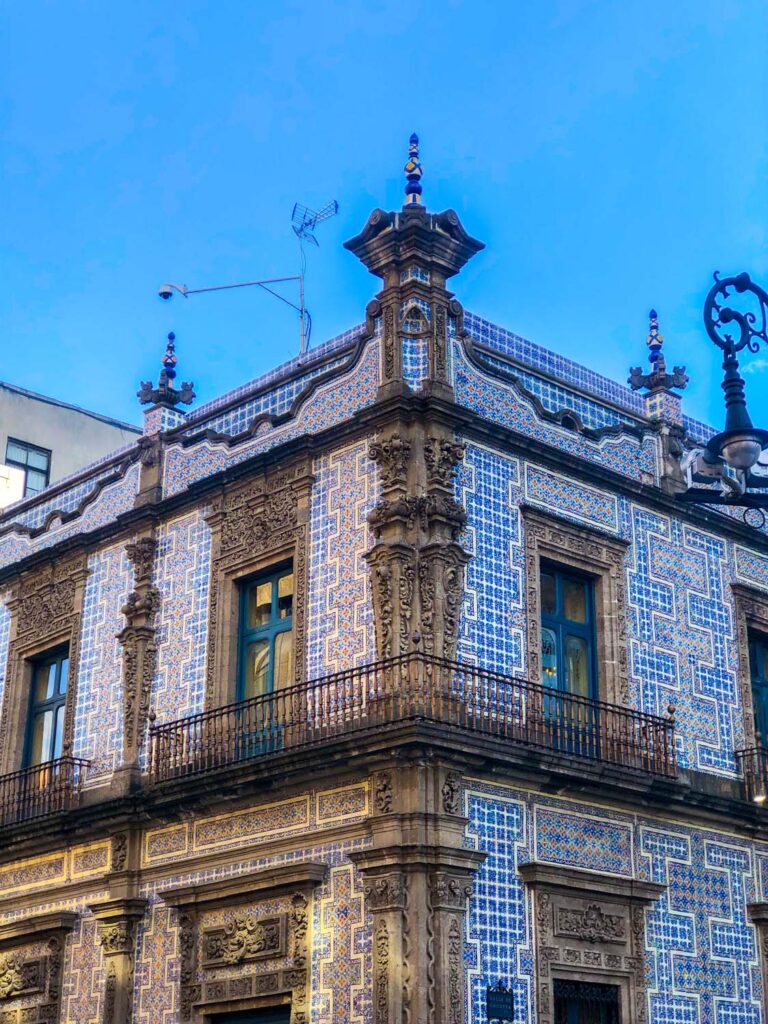

Sanborns
Florid stone carvings decorated the windows, doorways and balconies around the rest of the building. Carved into the stones are French porcelain crowns to denote the status of the house as a royal residence. The Count’s family eventually sold off the property in the 20th century. It was purchased by Frank Sanborn and his brother Walter. It was there that they would open their first soda fountain shop and drugstore. They named it the ‘Sanborns American Pharmacy,’ which opened in 1917. Sanborns transformed the residential interior open-air courtyard into a restaurant with a large stained-glass roof overhead. Customers could dine inside the inner courtyard and enjoy the gorgeous antique murals that cover the walls, remnants of the 17th-century home.
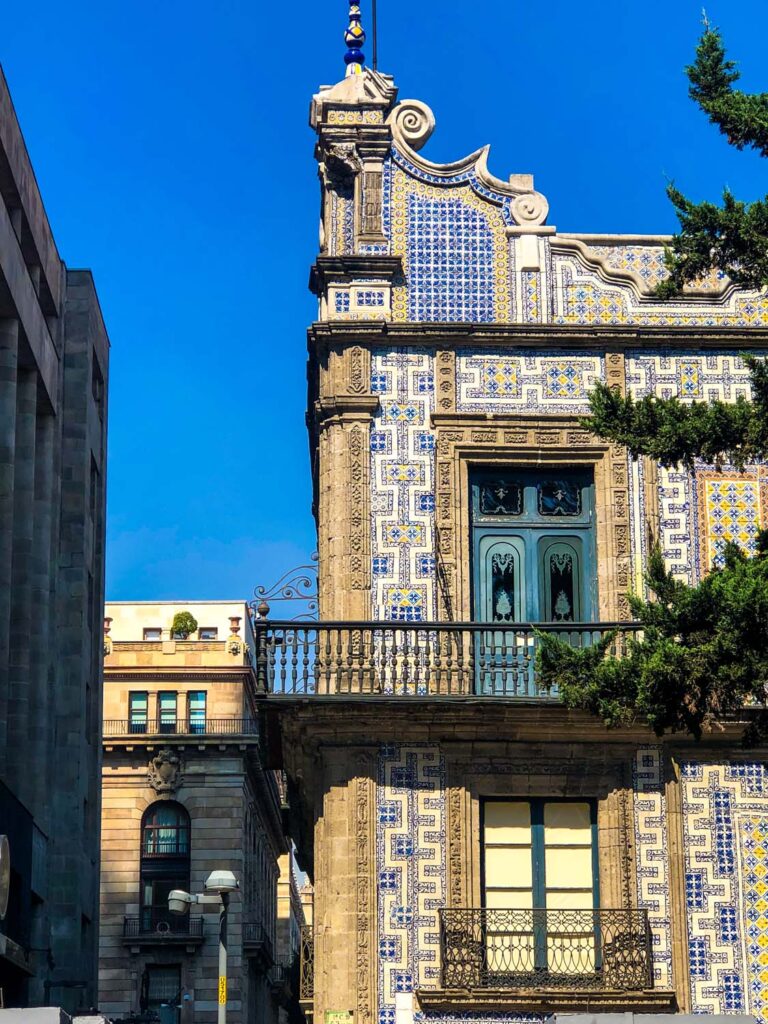
One of the best places to get a great photo-op is along the tiled exterior is on Condesa Street. This less busy side street has tiles that stretch along the entire passage and provide an unobstructed view of the building. The food inside the restaurant isn’t anything to write home about but it is definitely worth going inside to take a look at the interior courtyard. Sanborn’s is still a small shop, so you can also go inside to buy yourself a little souvenir or bottle of water to give yourself an excuse to tour the interior.
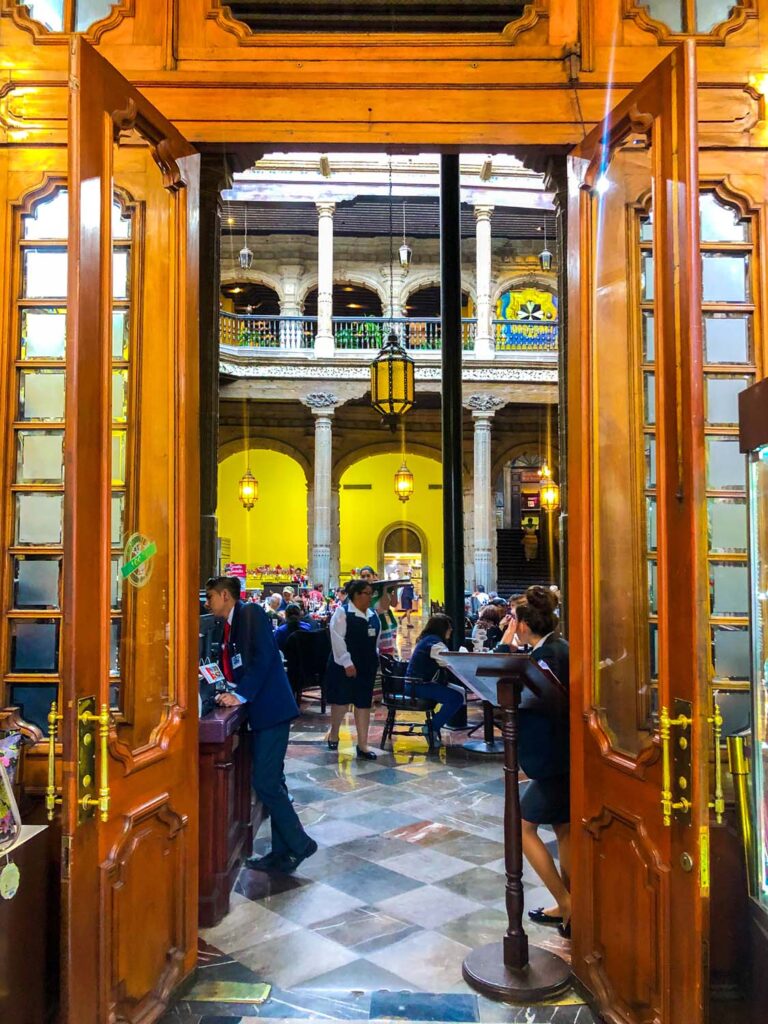

Torre Latinoamericana
At the end of Madero street is the great Torre Latinoamericana. This enormous skyscraper looks down over the Historic Center like its great protector. While the skyscraper might seem pretty modern for a stop on the “Historical” neighbourhood tour, the view you get from the top is really what makes visiting this place worthwhile. The Torre Latinoamericana stretches 166 meters (545 ft) up to the sky. The building was designed by some of the countries best engineers to ensure it could withstand the seismic activity that is prevalent in the area. It stood the test of time in 1985 when the building withstood the 8.1 magnitude earthquake that brought such immense damage to the rest of the Historic District.
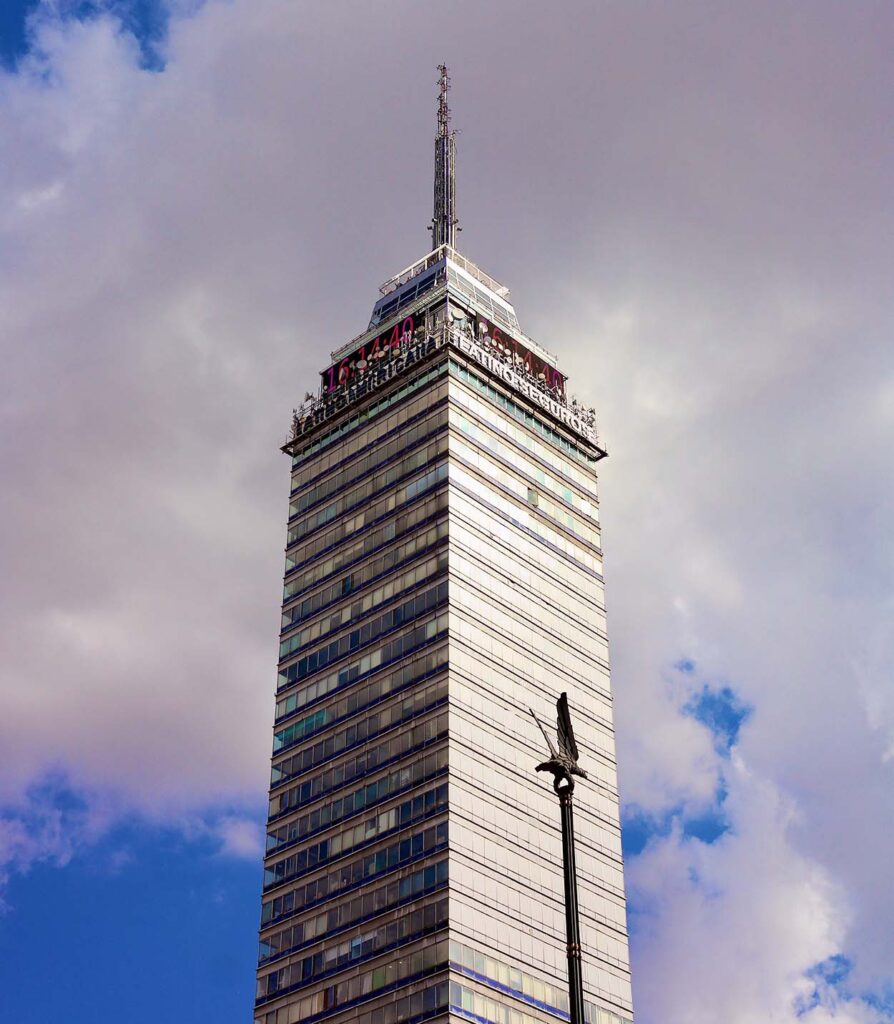
The building opened to the public in 1956 as Mexico’s tallest building and remained as such until 1982. Back then, skyscrapers were really architectural miracles. The other historic buildings in the neighbourhood were immediately looked over by locals and visitors in favour of the steel and glass tower. Today, it almost feels like the opposite. Most of us live in steel forests and are clamouring to see more of the baroque stone structure of the past.
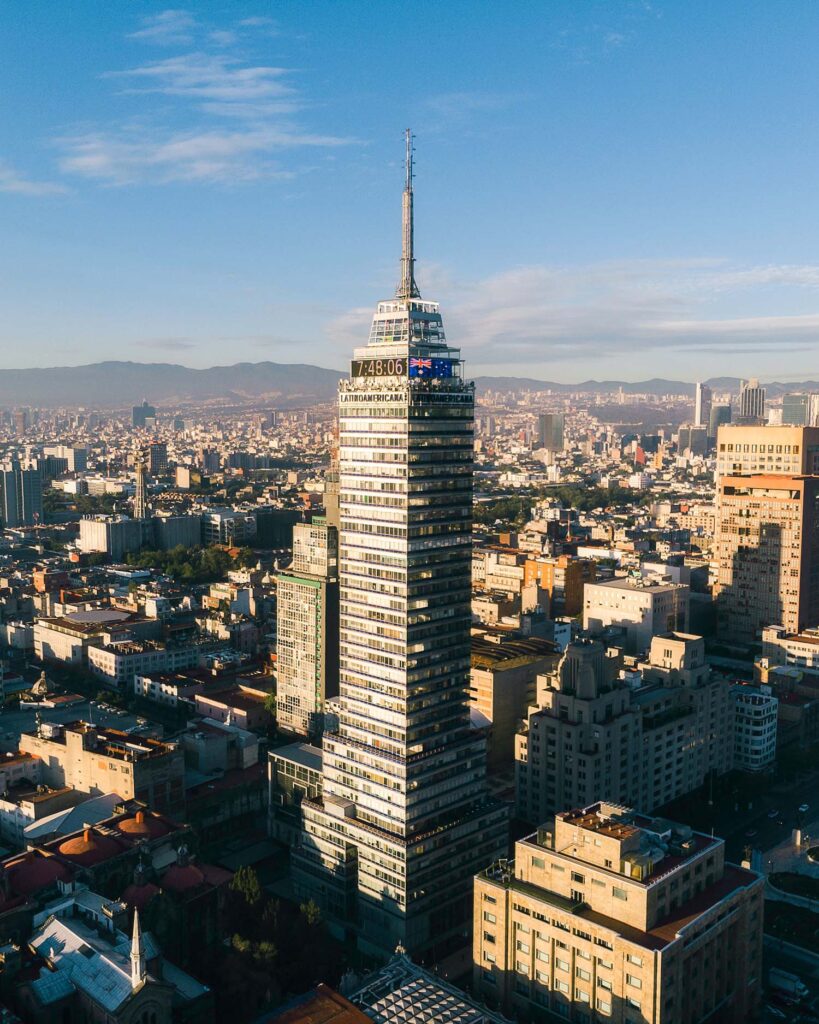
Observation Deck
You have the option to travel up the tower to experience the fantastic views all across Mexico City. The building’s 44th floor is home to a large open-air observation deck. On a clear day, you can see all across the city and even over to the snow-capped volcanoes of Iztaccíhuatl and Popocatépetl. From up above, you can really see how Mexico City is indeed located in a valley. Ticket to go up the tower cost 150 pesos (7 USD) per person.
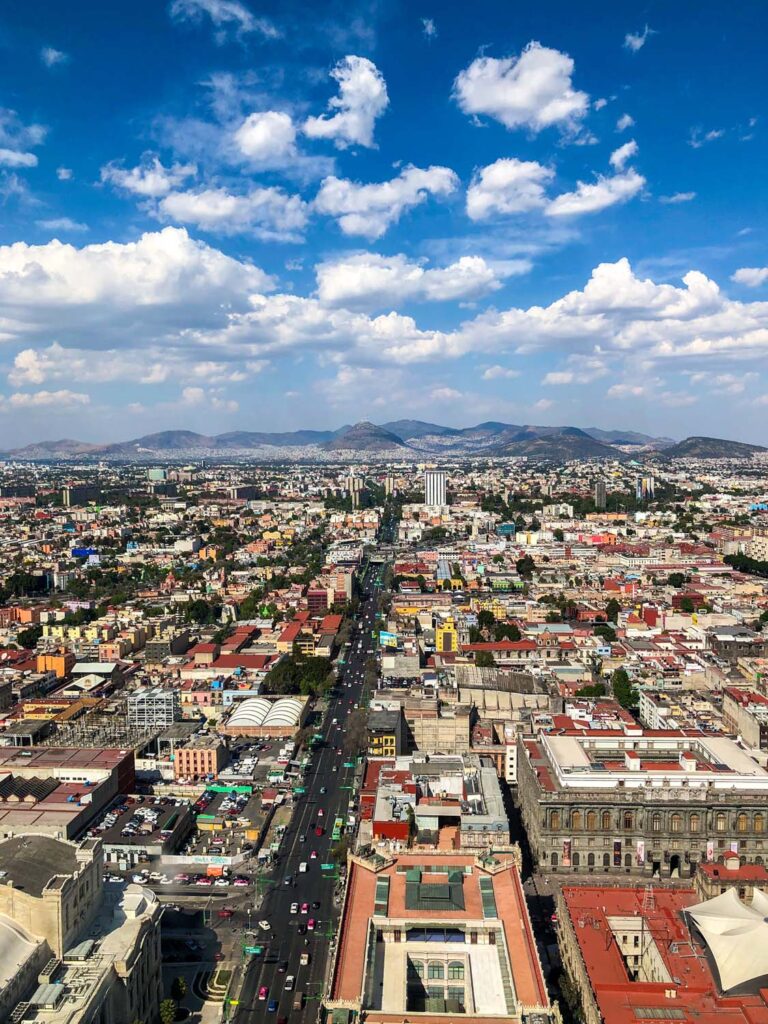
Miralto Restaurant
If you are interested in getting a view without paying to go the observation deck you have the option of dining at the Miralto restaurant, located inside the tower. The restaurant has just as spectacular of a view, albeit without the open-air part. But for those of us who don’t love heights, this option might even be bette. The menu is pretty basic, but the food we did order was really delicious and shockingly well priced for being in such a spectacular location. My advice would be to head up to the tower to enjoy a small appetizer and fancy cocktail to paur with the gorgeous view. If you visit at the end of the day, you’ll also be able to enjoy a magnificent sunset!

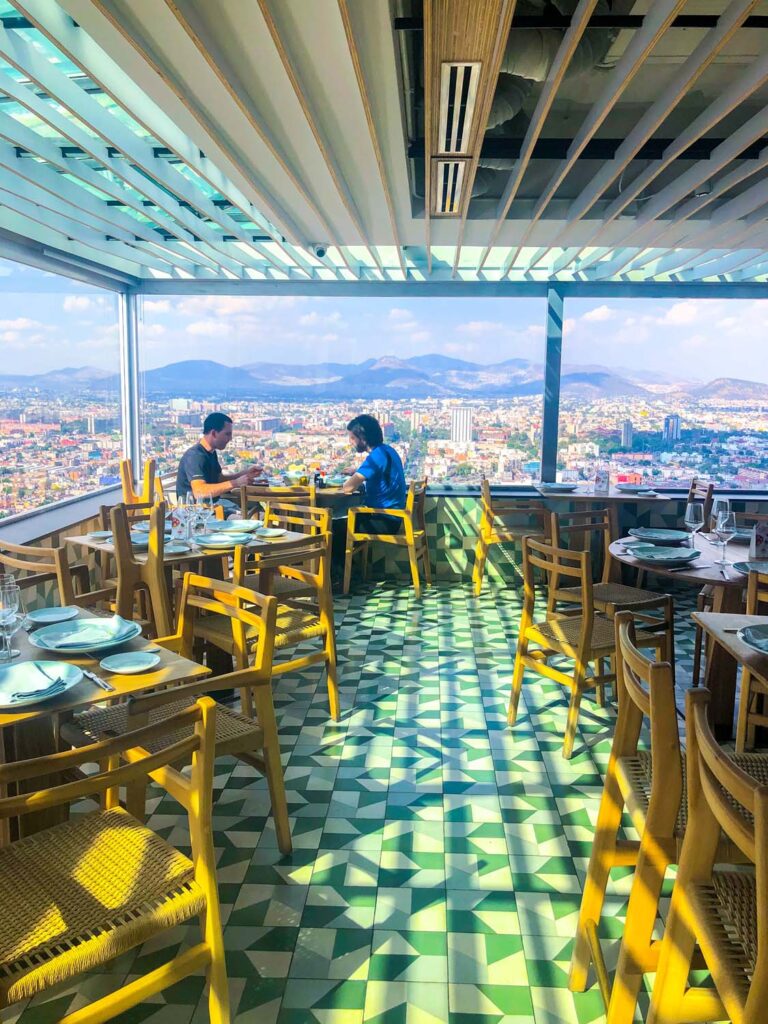
La Opera Bar
If you’re looking to fill up for real, the Historic Centre has a ton of fantastic options for you. For a mid-price table service restaurant with such historic flair, La Ópera Bar is an excellent choice. The restaurant and bar have been here since 1870, serving locals and tourists alike. There is a definitely European flare to the place with their richly polished woods, tiled floor and filigree wood-carved ceilings.
Azul Historico
But my all-time favourite option has got to be Azul Historico. It’s an upscale option but still super reasonably priced considering the quality of the food and the beautiful ambiance. The restaurant is located inside a gorgeous open-air colonial courtyard. You sit amongst the trees while dining on authentic and yet modern Mexican cuisine. The presentation and service is absolutely unparalleled and eating here feels like such a visually sensation experience.
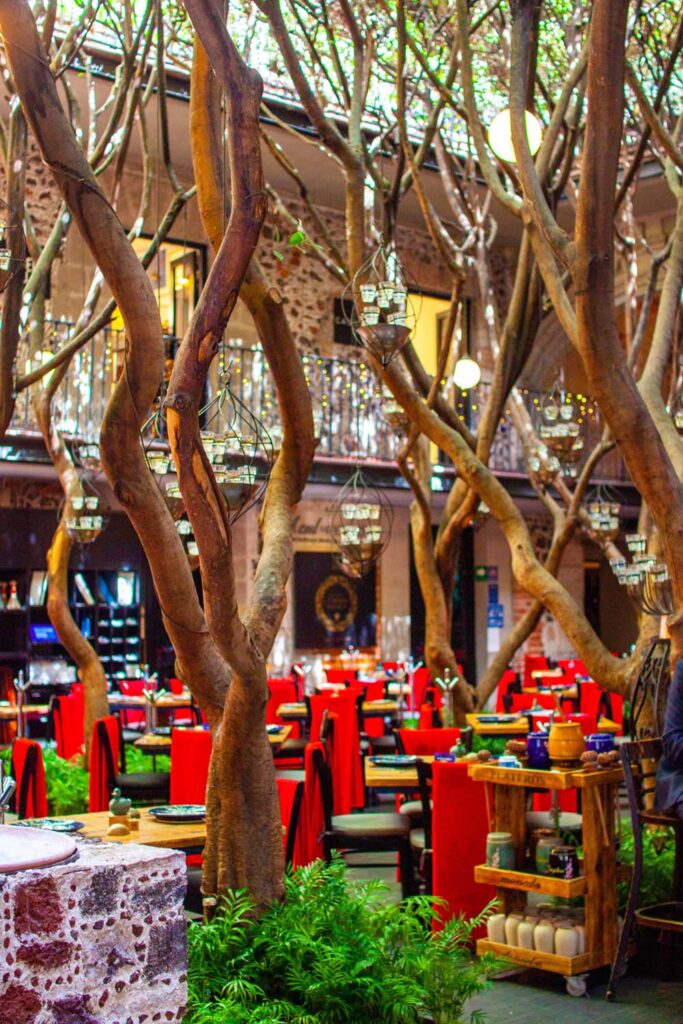
The entire menu is fantastic but one of my favourite hidden gems, that many people might not realize or skip over, is their hot chocolate. Hot chocolate originated in Mexico so ordering it here feels like getting to try the most authentic version of the drink. If you order a hot chocolate, they’ll bring the hot chocolate cart to your table. There, a waiter mixes up your personalized drink. Almost like ordering a fancy cocktail. You get to choose the type of chocolate and even some additives. Then they use these traditional wooden mixers to serve up the cup of warm cocoa right there in front of you! Just one more example of their stupendous service! You really must make it out here!
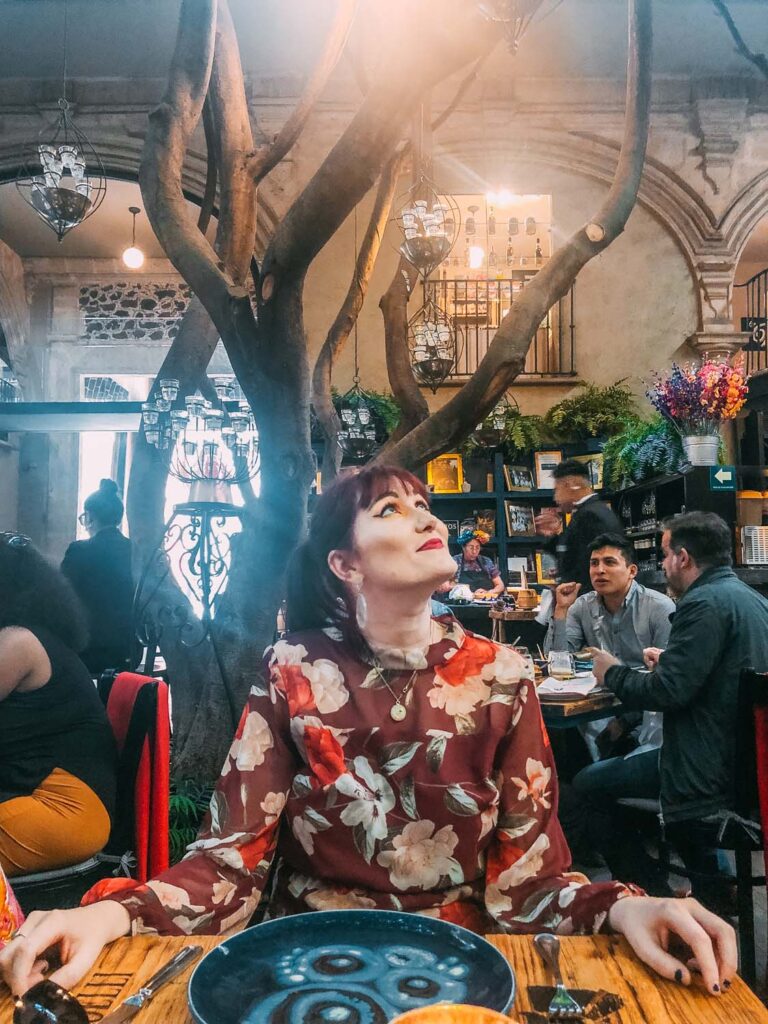
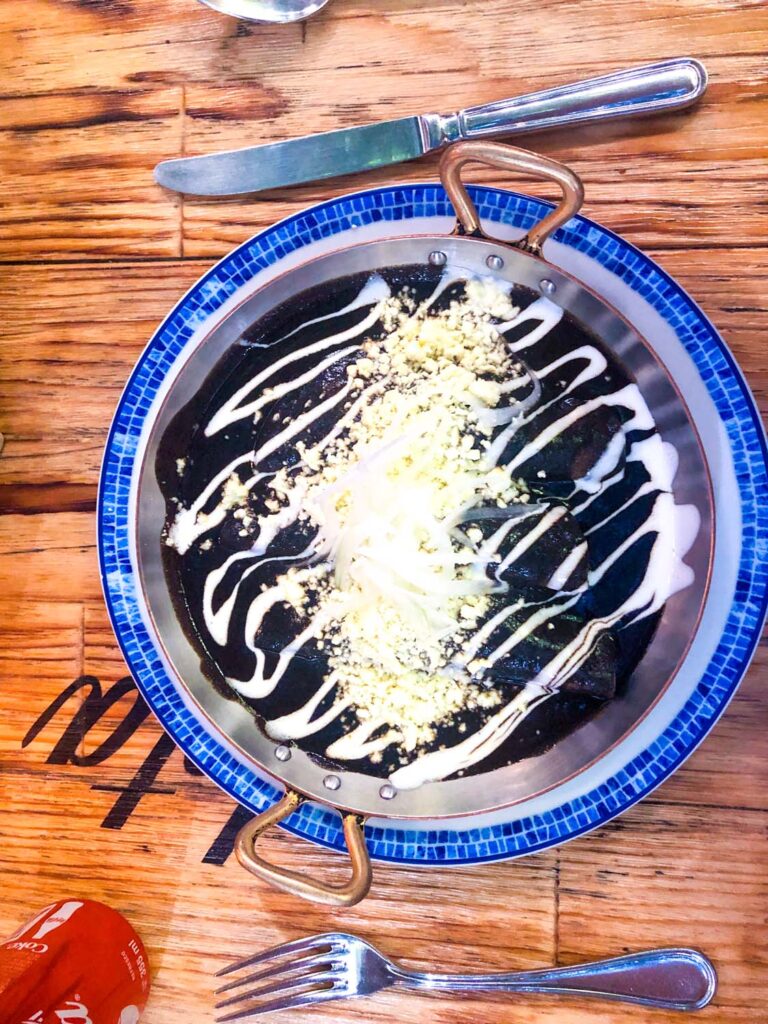
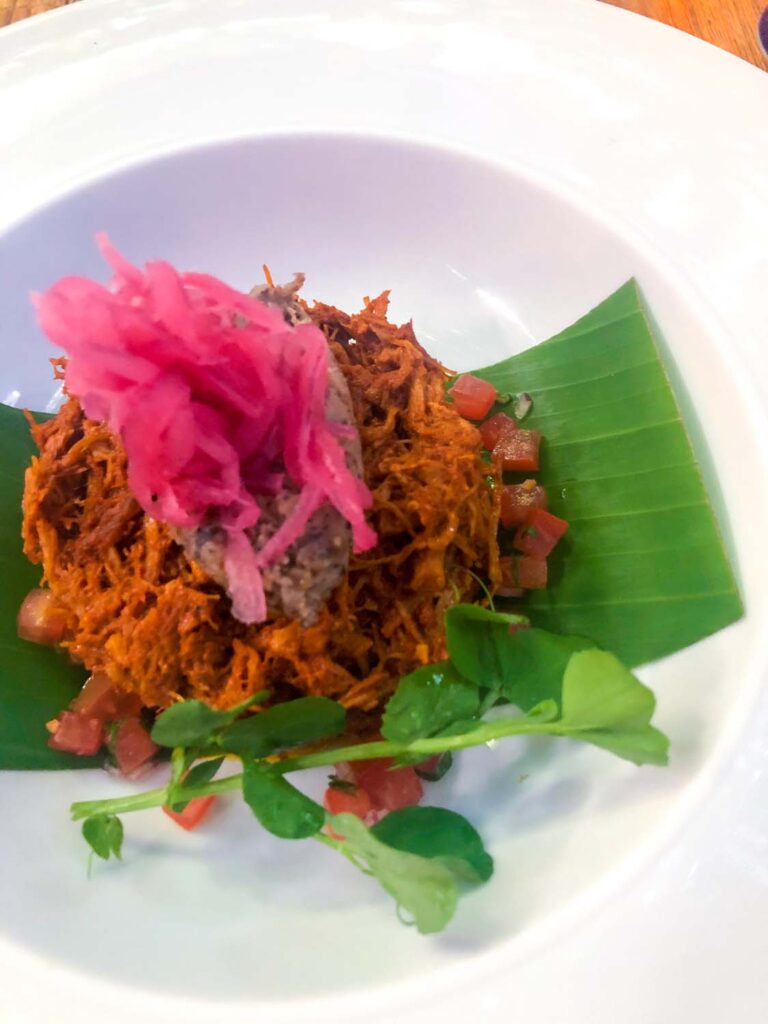
Pastelería Ideal
If you are still hankering something sweet to eat for dessert head over to the Pastelería Ideal. This bakery is one of the most popular shops in the district. In fact, you might have even seen their colossal blue and white boxes all over the city as it’s a popular spot for cafes to buy their sweets from. The bakery was founded in 1927 and has been opened in this very spot ever since. They have since opened up three other locations, but this is the original. The building in which it is located was actually once a part of the old Franciscan monastery we visited eariler! You can still see details of the original walls of the De Profundis Room inside the upper floors of the bakery.
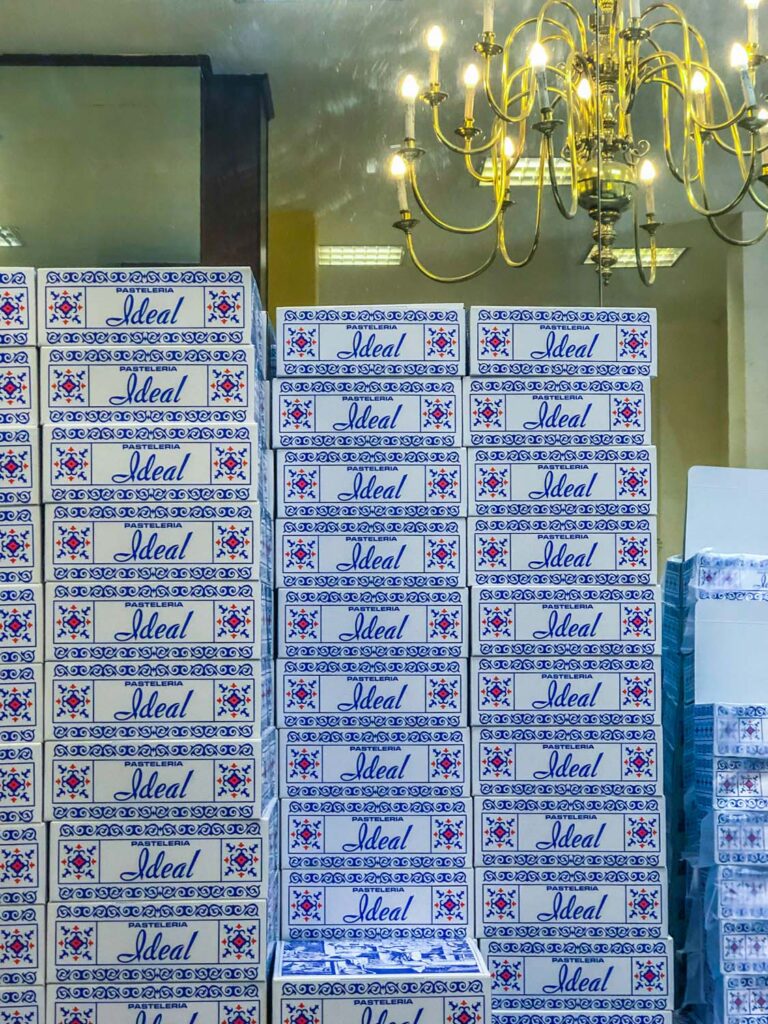
This bakery has everything from traditional Mexican bread and pastries, cakes and cookies to Parisian puff pastry, viennoiseries, and more! All of this is served up on huge platters towering with treats. Just grab a try and use the tongs provided to serve yourself up some pastries. Once you’re done piling up (they make great breakfast pastries, too), take your collection to the counter. There they will pack them up for you and give you a ticket to pay. After you’ve paid, they’ll delivery you your baked good, all perfectly wrapped up to go. Enjoy them back at your hotel or back in Alameda Park to round out the tour.
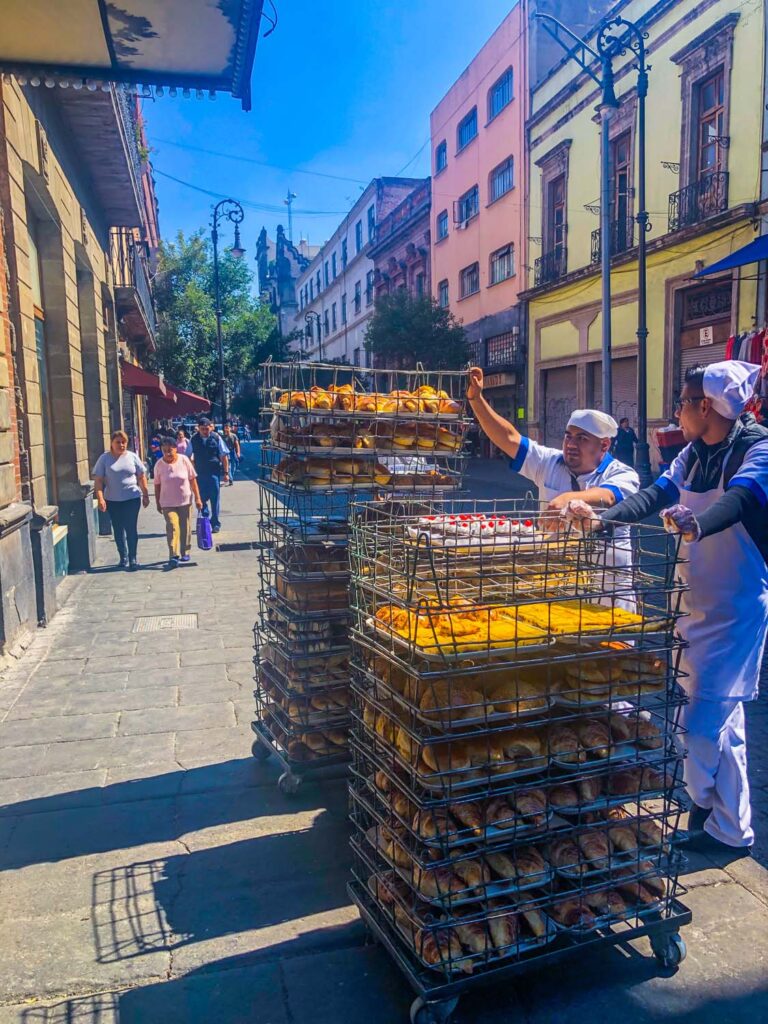


Mexico City’s Historic Centre is a must-see destination for anyone visiting the city. It has so much significance with regard to the history of Mexico. It’s one of the most exciting areas to visit and the museums provide a dozen more reasons to come back! I hope you enjoyed our very thorough tour, time to head home, put your feet up and enjoy a cold Cerveza!
Happy Travels, Adventurers!
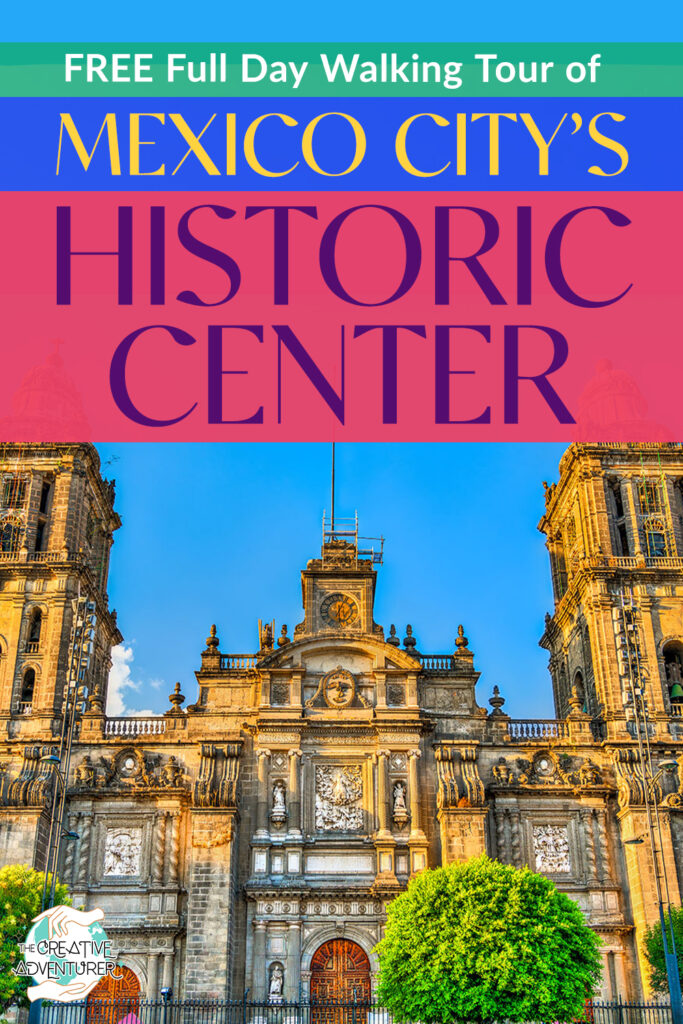





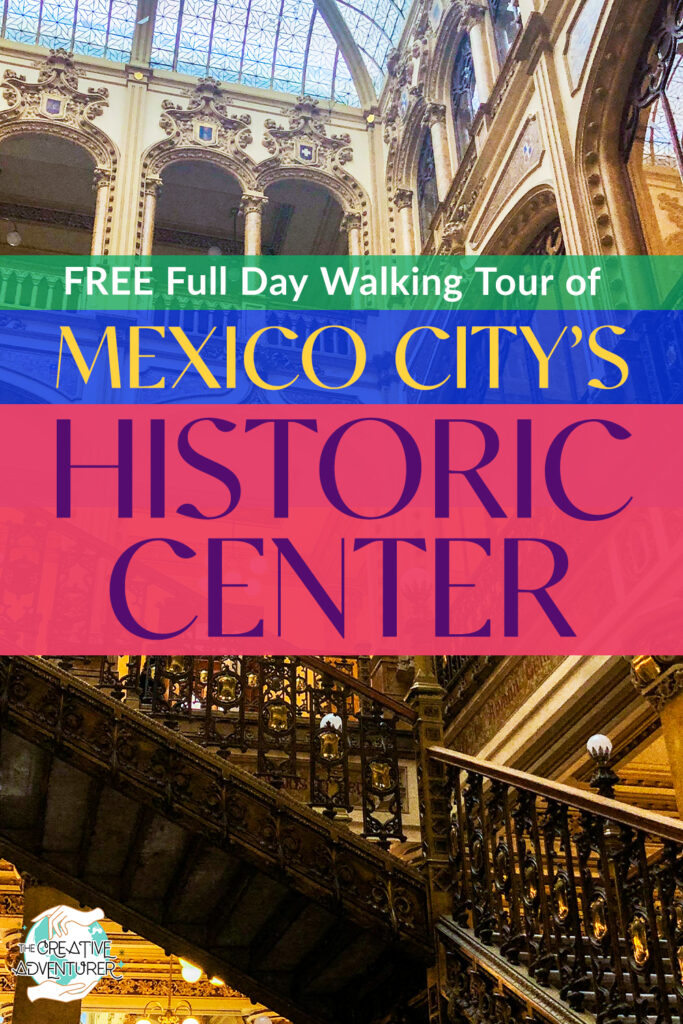




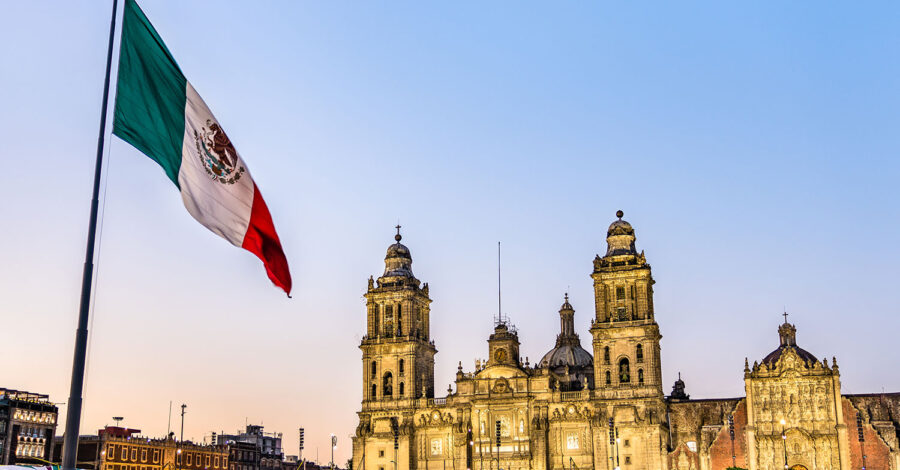
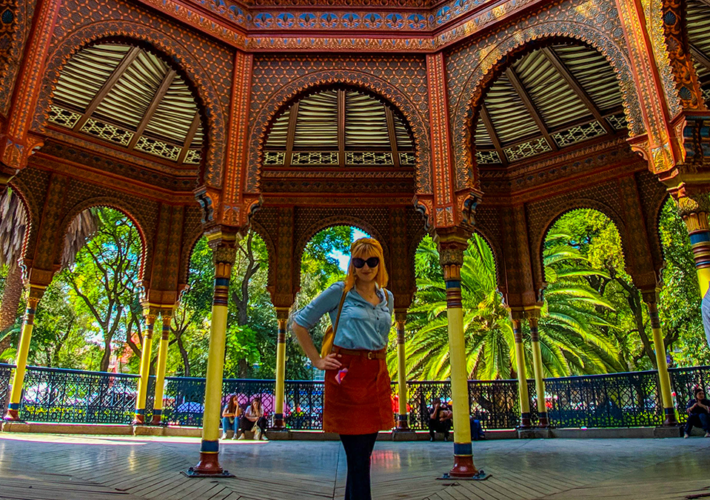
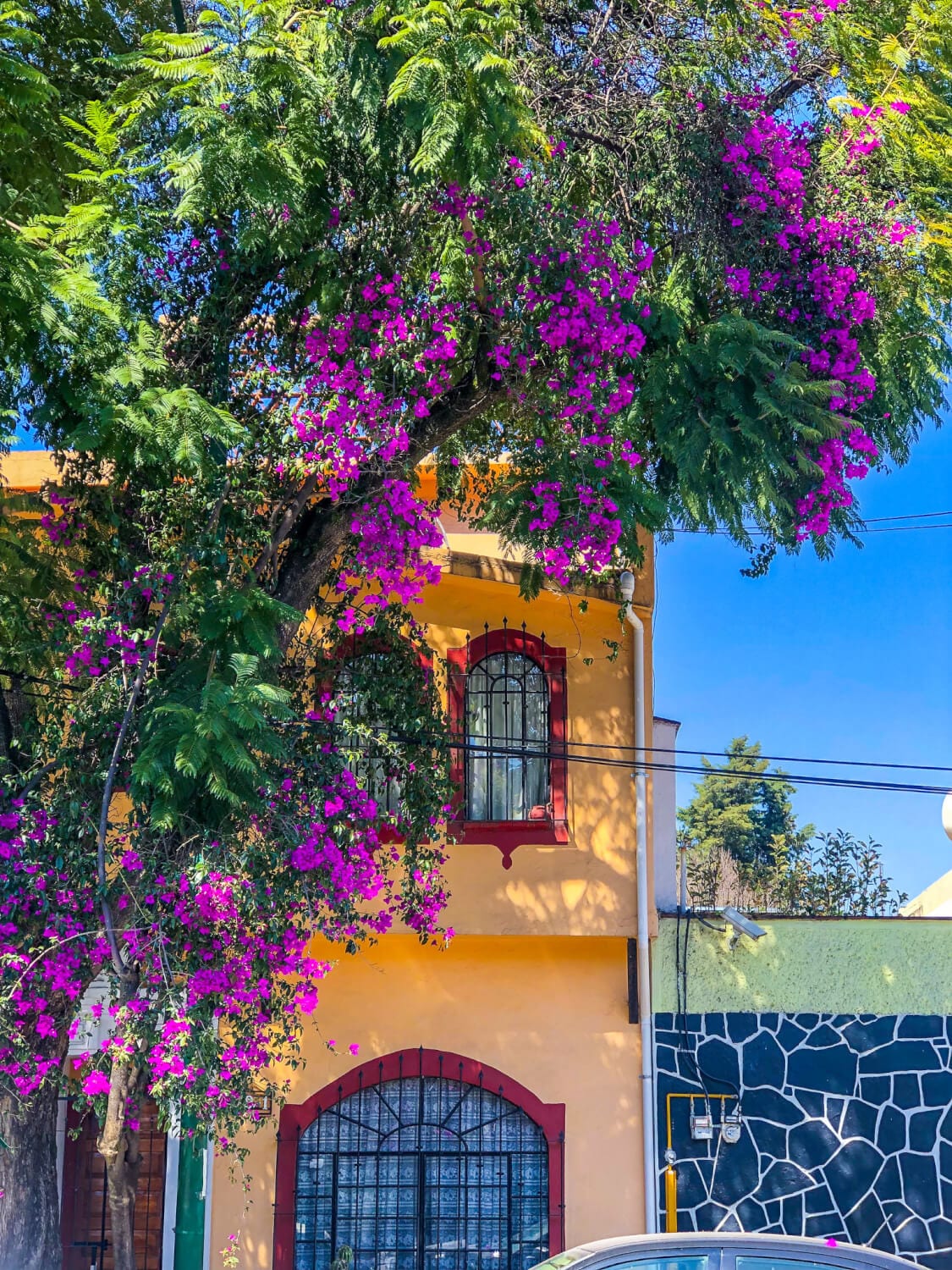
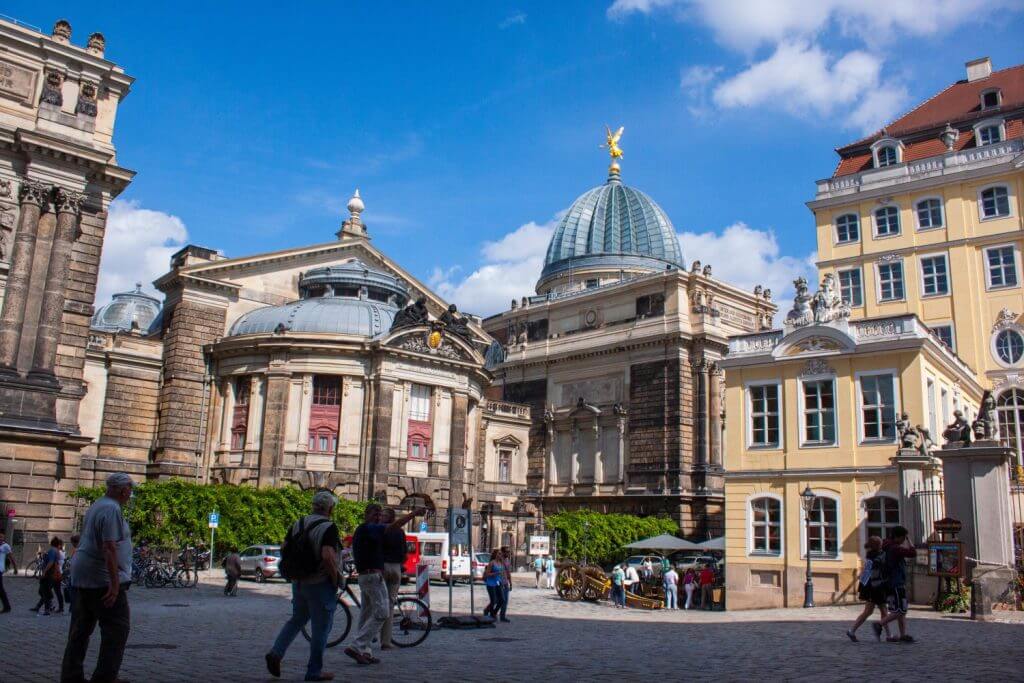

9 COMMENTS
Martin Robert
2 years agoVraiment le meilleur guide gratuit disponible. Très apprécié. Merci !
The Creative Adventurer
2 years ago AUTHORThank you so much Martin! I truly appreciate the feedback. I hope you have an amazing time in Mexico City. Let me know if I can help out any with your travel plans.
Dr. Keith A. Thorp
2 years agoA very extensive and largely well-done overview of much of the Centro Historico. It is a wealth of information. However, there are a few errors in the text that you may wish to correct –
1-Cinco de Mayo has nothing to do with Mexican Independence Day. It is the commemoration of the Battle of Pueblo in 1862 (forty years after independence) when the French triumphed briefly over the French.
2-The streets named after international cities are not in Roma Norte, but in Colonia Juarez. In Roma Norte the streets are named after Mexican cities and states. The streets named after rivers are in Colonia Cuauhtémoc, on the north side of the Reforma between Insurgentes and the Bosque de Chapultepec.
Thank you.
The Creative Adventurer
2 years ago AUTHORThanks so much for taking the time to flag these corrections for me Dr. Thorp! I really appreciate it, as I’m always trying to hone the details and factual information. I’ve already gone ahead and made those edits. And thanks again for the nice comment on the rest of the post. I love this city so much and I’m constantly trying to learn as much as I can about it
Dr. Keith A. Thorp
2 years agoAnd after trying to correct your text, I made an error in my own – it should read Puebla, of course, not Pueblo! LOL
I am with you. I just can’t get enough of CDMX, and spend time every week just exploring the various neighborhoods and researching as much as I can. Kudos on your fine work!
The Creative Adventurer
2 years ago AUTHORWhat would you say is your favourite historical treasure in the city? I love talking to people who share the same passion for this place, especially those with a keen interest in history.
Clotilde
1 year agoThank you for this wonderful itinerary
The Creative Adventurer
1 year ago AUTHORThank you for the lovely feedback!
Tim Culler
1 year agoWell done! Lots of details and very helpful for first time visitors!